Paul van Yperen's Blog, page 185
September 6, 2020
Christa Tordy
German film actress Christa Tordy (1904-1945) was discovered while visiting her cousin Mady Christians in Berlin. In the late 1920s, she briefly became a leading star of the German silent cinema before retiring after marrying Harry Liedtke. She was murdered along with her husband at their home when the Soviet Red Army invaded Germany during World War II.
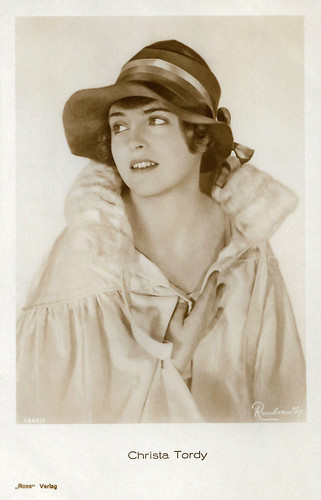
German postcard by Ross Verlag, no. 1947/1, 1927-1928. Photo: Rembrandt.
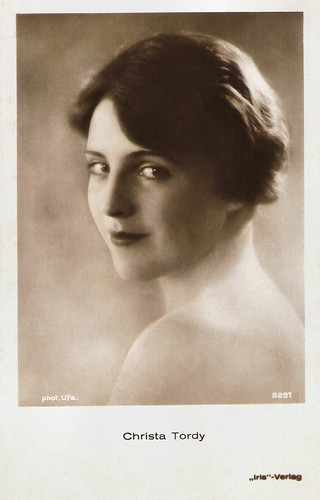
Austrian postcard by Iris-Verlag, no. 5291. Photo: Ufa.
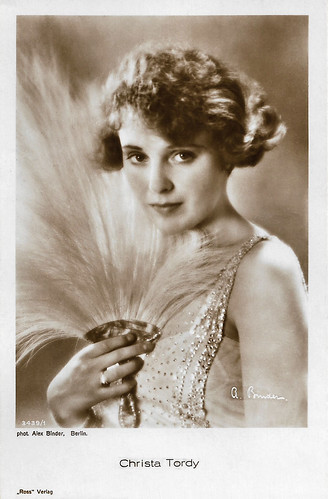
German postcard by Ross Verlag, no. 3439/1, 1928-1929. Photo: Alex Binder, Berlin.
The beautiful niece of Mady Christians
Christa Tordy was born Anneliese Uhlhorn (according to Wikipedia and Steffi-Line ; IMDb writes Christine Uhlhorst) in 1904 in Bremen. She spent her childhood in Wiesbaden after her father had retired there.
There, she attended high school, graduating at age 17, and began studying art history, archaeology, philosophy, and literary history in Berlin and Munich, finishing her studies in Wrocław with a doctorate. During her time in school, she also participated in student theatre, creating and staging plays.
In 1925, Tordy visited her cousin Mady Christians while she was working on the film Ein Walzertraum/A Waltz Dream (Ludwig Berger, 1925). Tordy was noticed by director Ludwig Berger or cinematographer Werner Brandes, who persuaded her to undergo a screen test.
After finishing her studies, she decided on a film career and chose the stage name Christa Tordy. Tordy made her film debut in Der Seekadett/The Sea Cadet (Carl Boese, 1926) starring Walter Slezak , followed by the crime film Sein großer Fall/His Toughest Case (Fritz Wendhausen, 1926).
She next starred in the historical film Prinz Louis Ferdinand (Hans Behrendt, 1927), based on the life of Prince Louis Ferdinand of Prussia (1772–1806). It was part of the series of Prussian films made during Weimar Germany. her co-star was Hans Stüwe , with whom she also appeared in Potsdam, das Schicksal einer Residenz/Potsdam (Hans Behrendt, 1927).
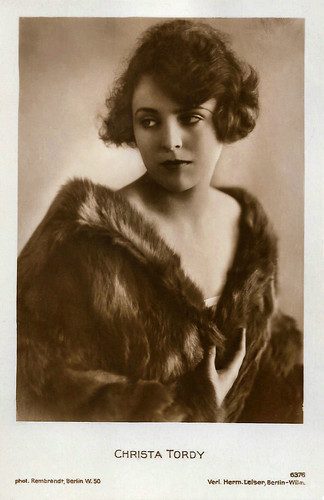
German postcard by Verlag Hermann Leiser, Berlin-Wilm., no. 6376. Photo: Rembrandt, Berlin.
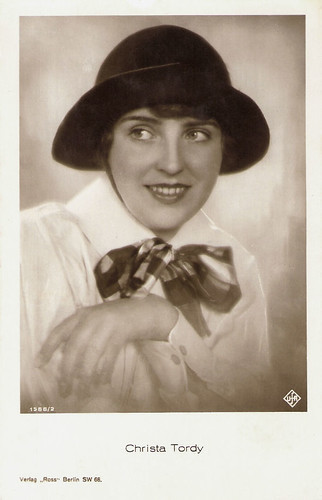
German postcard by Ross Verlag, no. 1588/2, 1927-1928. Photo: Ufa.
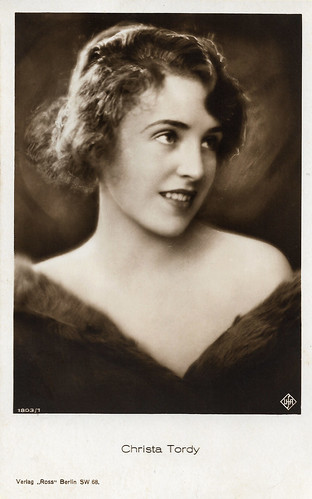
German postcard by Ross Verlag, no. 1803/1, 1927-1928. Photo: Ufa.
Murdered by the Soviet Red Army under mysterious circumstances
In 1928, Christa Tordy played the female lead in Das Geheimnis von Genf/The Man with the Limp (Willy Reiber, Franz Seitz, 1928) with Alfred Abel and Carmen Cartellieri . Next, she appeared in Die Sandgräfin/The Countess of Sand (Hans Steinhoff, 1928) also starring Käthe von Nagy and Jack Trevor .
That year Tordy married film star Harry Liedtke and retired from the film industry shortly thereafter. Her final screen appearance was in the comedy Amor auf Ski/Love on Skis (Rolf Randolf, 1928), with Liedtke.
They had met on the set and fallen in love. Christa was 20 years younger than her husband. During her brief career, she had only appeared in 8 films. From the early 1930s, the couple lived in a villa in the artist's colony 'Meckerndorf' in Bad Saarow-Pieskow on the eastern shore of Lake Scharmützel.
On 28 April 1945, Christa Tordy and Harry Liedtke were murdered there by the Soviet Red Army under mysterious circumstances. Liedtke had probably tried to save his wife from being raped and murdered but died after either being smashed on the head with a beer bottle or after being clubbed to death. Prior to their murder, the couple had attempted suicide.
Tordy and Liedtke's bodies were exhumed in October 1948 and they were buried at Waldfriedhof Saarow-Pieskow Cemetery. Upon Liedtke's ex-wife Käthe Dorsch 's death in 1957, she was buried alongside the two.
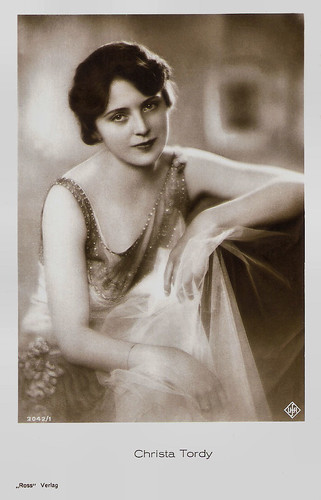
German postcard by Ross Verlag, no. 3042/1, 1928-1929. Photo: Ufa.
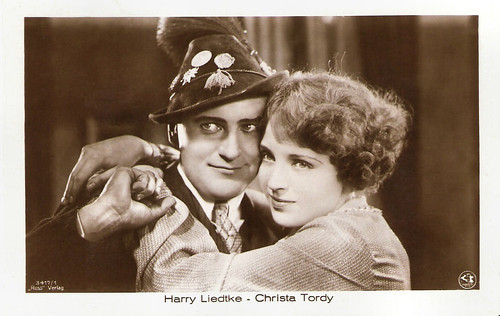
German postcard by Ross Verlag, no. 3417/1, 1919-1924. Photo: Phoebus-Film AG. Christa Tordy and Harry Liedtke in Amor auf Ski/Cupid on skis (Rolf Randolf, 1928).
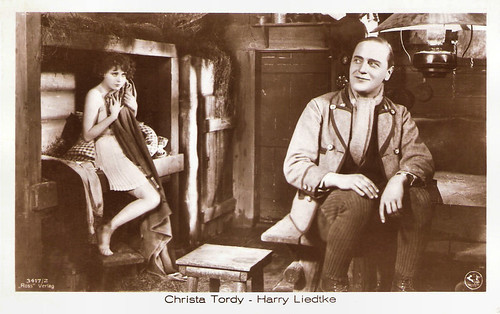
German postcard by Ross Verlag, no. 3417/2, 1919-1924. Photo: Phoebus-Film AG. Christa Tordy and Harry Liedtke in Amor auf Ski/Cupid on skis (Rolf Randolf, 1928).
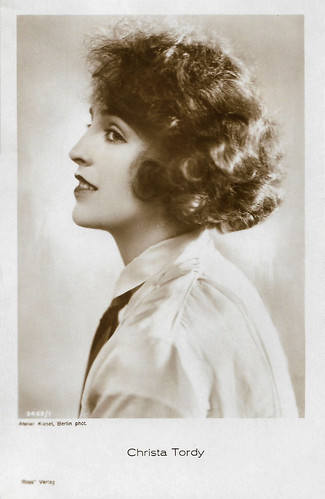
German postcard by Ross Verlag, no. 3462/1, 1928-1929. Photo: Kiesel, Berlin.
Sources: Stephanie D'heil (Steffi-Line - German), Wikipedia, and .

German postcard by Ross Verlag, no. 1947/1, 1927-1928. Photo: Rembrandt.

Austrian postcard by Iris-Verlag, no. 5291. Photo: Ufa.

German postcard by Ross Verlag, no. 3439/1, 1928-1929. Photo: Alex Binder, Berlin.
The beautiful niece of Mady Christians
Christa Tordy was born Anneliese Uhlhorn (according to Wikipedia and Steffi-Line ; IMDb writes Christine Uhlhorst) in 1904 in Bremen. She spent her childhood in Wiesbaden after her father had retired there.
There, she attended high school, graduating at age 17, and began studying art history, archaeology, philosophy, and literary history in Berlin and Munich, finishing her studies in Wrocław with a doctorate. During her time in school, she also participated in student theatre, creating and staging plays.
In 1925, Tordy visited her cousin Mady Christians while she was working on the film Ein Walzertraum/A Waltz Dream (Ludwig Berger, 1925). Tordy was noticed by director Ludwig Berger or cinematographer Werner Brandes, who persuaded her to undergo a screen test.
After finishing her studies, she decided on a film career and chose the stage name Christa Tordy. Tordy made her film debut in Der Seekadett/The Sea Cadet (Carl Boese, 1926) starring Walter Slezak , followed by the crime film Sein großer Fall/His Toughest Case (Fritz Wendhausen, 1926).
She next starred in the historical film Prinz Louis Ferdinand (Hans Behrendt, 1927), based on the life of Prince Louis Ferdinand of Prussia (1772–1806). It was part of the series of Prussian films made during Weimar Germany. her co-star was Hans Stüwe , with whom she also appeared in Potsdam, das Schicksal einer Residenz/Potsdam (Hans Behrendt, 1927).

German postcard by Verlag Hermann Leiser, Berlin-Wilm., no. 6376. Photo: Rembrandt, Berlin.

German postcard by Ross Verlag, no. 1588/2, 1927-1928. Photo: Ufa.

German postcard by Ross Verlag, no. 1803/1, 1927-1928. Photo: Ufa.
Murdered by the Soviet Red Army under mysterious circumstances
In 1928, Christa Tordy played the female lead in Das Geheimnis von Genf/The Man with the Limp (Willy Reiber, Franz Seitz, 1928) with Alfred Abel and Carmen Cartellieri . Next, she appeared in Die Sandgräfin/The Countess of Sand (Hans Steinhoff, 1928) also starring Käthe von Nagy and Jack Trevor .
That year Tordy married film star Harry Liedtke and retired from the film industry shortly thereafter. Her final screen appearance was in the comedy Amor auf Ski/Love on Skis (Rolf Randolf, 1928), with Liedtke.
They had met on the set and fallen in love. Christa was 20 years younger than her husband. During her brief career, she had only appeared in 8 films. From the early 1930s, the couple lived in a villa in the artist's colony 'Meckerndorf' in Bad Saarow-Pieskow on the eastern shore of Lake Scharmützel.
On 28 April 1945, Christa Tordy and Harry Liedtke were murdered there by the Soviet Red Army under mysterious circumstances. Liedtke had probably tried to save his wife from being raped and murdered but died after either being smashed on the head with a beer bottle or after being clubbed to death. Prior to their murder, the couple had attempted suicide.
Tordy and Liedtke's bodies were exhumed in October 1948 and they were buried at Waldfriedhof Saarow-Pieskow Cemetery. Upon Liedtke's ex-wife Käthe Dorsch 's death in 1957, she was buried alongside the two.

German postcard by Ross Verlag, no. 3042/1, 1928-1929. Photo: Ufa.

German postcard by Ross Verlag, no. 3417/1, 1919-1924. Photo: Phoebus-Film AG. Christa Tordy and Harry Liedtke in Amor auf Ski/Cupid on skis (Rolf Randolf, 1928).

German postcard by Ross Verlag, no. 3417/2, 1919-1924. Photo: Phoebus-Film AG. Christa Tordy and Harry Liedtke in Amor auf Ski/Cupid on skis (Rolf Randolf, 1928).

German postcard by Ross Verlag, no. 3462/1, 1928-1929. Photo: Kiesel, Berlin.
Sources: Stephanie D'heil (Steffi-Line - German), Wikipedia, and .
Published on September 06, 2020 22:00
September 5, 2020
Fannie Ward
Fannie Ward, a.k.a. Fanny Ward (1871–1952) was a star of light comedies on Broadway and in vaudeville. Internationally famous, she was at the height of her career in the first decade of the 20th century. Later she was known for The Cheat (1915), a sexually- and racially-charged silent film directed by Cecil B. DeMille. In the late 1910s, she did a series of films for Astra Films, released by Pathé Exchange.

British postcard. Fannie Ward in The Cheat (Cecil B. DeMille, 1915).
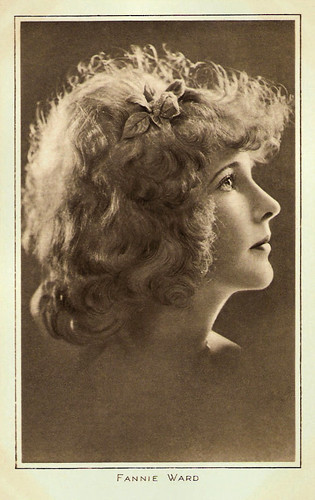
British postcard in the Pictures Portrait Gallery by Pictures Ltd, London, no. 98.
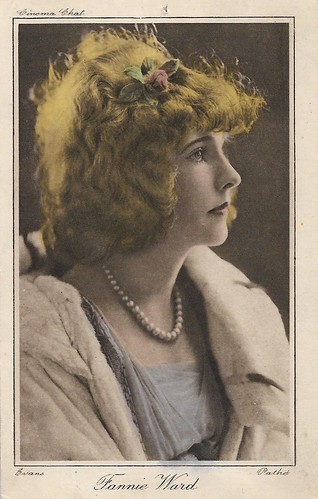
British postcard in the Cinema Chat series. Photo: Evans / Pathé.
Penniless Diamond Joe
Fannie Ward was born Fannie Buchanan in St. Louis, Missouri, in 1871 or 1872, the sources differ. Ward was the only daughter of Eliza and John Buchanan, who was a dry goods merchant. She had a brother, Benton.
In 1890, against the wishes of her parents, Ward made her stage debut as Cupid in 'Pippino' with vaudevillian star Eddie Foy. She soon became a success in 10 stage productions in New York City before sailing in 1894 to London, where she performed in 'The Shop Girl'.
Her performances led critics to compare Ward favourably to actress Maude Adams. In 1898, however, she married wealthy diamond merchant Joe Lewis and retired from the stage.
Ward resumed her career in 1905 after her husband 'Diamond Joe' suffered severe business losses that left him, according to news reports, "practically penniless".
In 1907, she returned to the Broadway stage to perform in 'A Marriage of Reason' at the Wallack's Theatre. She was then cast two years later in another Broadway production, 'The New Lady Bantock'; and after its run at Wallack's, she and other cast members took the play on tour to various cities during the latter half of 1909.
Yet another popular Broadway play in which she performed was the comedy 'Madam President', which was presented at the Garrick Theatre from September 1913 to January 1914.
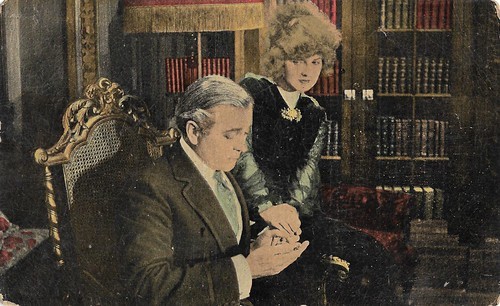
Spanish 'cromo'. Photo: Jesse L. Lasky / Paramount. Fannie Ward and Charles Clary in Each Pearl a Tear (George Melford, 1916).
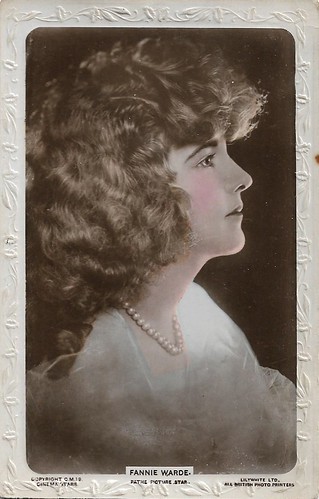
British postcard in the Cinema Stars series by Lilywhite Ltd., no. C.M. 19. Photo: Pathé. Ward's name is misspelled on this card.

British postcard by Cinema Chat. Photo: Evans / Pathé.
The film proved to be a sensation
In 1915, around the time Fannie Ward's stage career was waning, American film producer and director Cecil B. DeMille convinced her to perform in The Cheat (1915), a silent film melodrama co-starring Japanese actor Sessue Hayakawa . The film proved to be a sensation due to its plot mingling of racial and sexual themes.
In The Cheat, Ward portrays a society woman who embezzles money and turns to an Asian ivory dealer (Hayakawa) for help, with brutal consequences. The film features a shocking scene in which Ward's character is branded and nearly raped.
Although she was 43 when she made the film, she appeared much younger (she claimed she was 40). The film launched the careers of DeMille and Hayakawa, who soon became Hollywood's first Asian star. It also began a busy film career for Ward for the next few years, at least 15 of her 26 films co-starring her second husband John Dean.
When she and Dean built their huge Italian mansion in 1919, it was a well-publicised event. Known as 'The Youth Girl', she was continually cast in roles that were 20 to 30 years younger than her actual age. After making The Hardest Way (1919 or 1921) with Theodore Roberts, she decided to go back on the vaudeville circuit.
However, Ward also appeared on screen in such shorts as the Phonofilm short Father Time (1924) in which she sings; another Phonofilm production, The Perennial Flapper (1924); and in the Vitaphone short The Miracle Woman (1929).
In 1926, trading on her ever-youthful public image, Ward opened a Paris beauty shop, 'The Fountain of Youth'. She continued touring on vaudeville occasionally into the 1930s, still belying her age, now well into her sixties.
Fannie Ward was married twice. Her first husband was Joseph Lewis, a British money lender and diamond dealer. They married in 1898. In 1913, Ward and Lewis divorced. The following year she married her second husband, John Wooster Dean an actor who frequently co-starred with her on stage and in films. Ward's only child, Dorothé Mabel Lewis (1900–1938), died in a plane crash in 1938. Dorothé was the result of an affair with Viscount Castlereagh, who in 1915 became The Most Hon. the 7th Marquess of Londonderry, an Anglo-Irish aristocrat from Ulster.
Ward lost her husband in 1950. In 1952, at age 79 or 80, Ward suffered a stroke in her Park Avenue apartment and was found unconscious by a neighbour. She remained in a coma until her death six days later at Lenox Hill Hospital. The New York Times reported that Ward died without a will and left an estate with an estimated value of $40,000. The newspaper also reported that she was survived by "three English grandsons": Lord Patrick Plunkett, the Hon. Shaun Plunkett, and the Hon. Robin Plunkett.
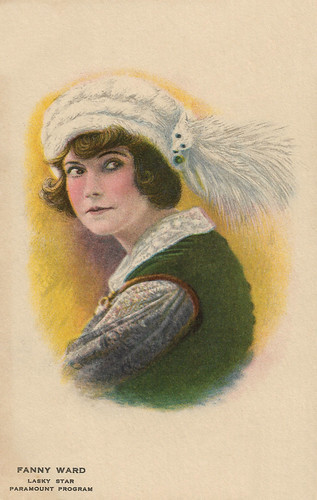
American postcard by Kline Poster Co. Inc., Phila. Illustration: Lasky / Paramount.
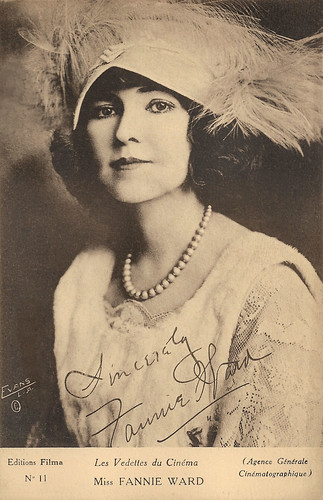
French postcard in the Les Vedettes du Cinéma series by Filma, no. 11. Photo: Evans, L.A. / Agence Générale Cinematographique.
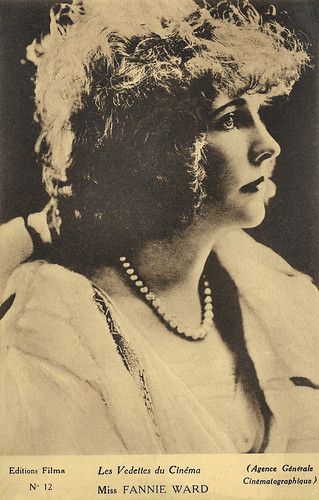
French postcard by Editions Filma in the Les Vedettes du Cinéma series, no. 12. Photo: Agence Générale Cinématographique.
Sources: Silents are Golden, Wikipedia, and.

British postcard. Fannie Ward in The Cheat (Cecil B. DeMille, 1915).

British postcard in the Pictures Portrait Gallery by Pictures Ltd, London, no. 98.

British postcard in the Cinema Chat series. Photo: Evans / Pathé.
Penniless Diamond Joe
Fannie Ward was born Fannie Buchanan in St. Louis, Missouri, in 1871 or 1872, the sources differ. Ward was the only daughter of Eliza and John Buchanan, who was a dry goods merchant. She had a brother, Benton.
In 1890, against the wishes of her parents, Ward made her stage debut as Cupid in 'Pippino' with vaudevillian star Eddie Foy. She soon became a success in 10 stage productions in New York City before sailing in 1894 to London, where she performed in 'The Shop Girl'.
Her performances led critics to compare Ward favourably to actress Maude Adams. In 1898, however, she married wealthy diamond merchant Joe Lewis and retired from the stage.
Ward resumed her career in 1905 after her husband 'Diamond Joe' suffered severe business losses that left him, according to news reports, "practically penniless".
In 1907, she returned to the Broadway stage to perform in 'A Marriage of Reason' at the Wallack's Theatre. She was then cast two years later in another Broadway production, 'The New Lady Bantock'; and after its run at Wallack's, she and other cast members took the play on tour to various cities during the latter half of 1909.
Yet another popular Broadway play in which she performed was the comedy 'Madam President', which was presented at the Garrick Theatre from September 1913 to January 1914.

Spanish 'cromo'. Photo: Jesse L. Lasky / Paramount. Fannie Ward and Charles Clary in Each Pearl a Tear (George Melford, 1916).

British postcard in the Cinema Stars series by Lilywhite Ltd., no. C.M. 19. Photo: Pathé. Ward's name is misspelled on this card.

British postcard by Cinema Chat. Photo: Evans / Pathé.
The film proved to be a sensation
In 1915, around the time Fannie Ward's stage career was waning, American film producer and director Cecil B. DeMille convinced her to perform in The Cheat (1915), a silent film melodrama co-starring Japanese actor Sessue Hayakawa . The film proved to be a sensation due to its plot mingling of racial and sexual themes.
In The Cheat, Ward portrays a society woman who embezzles money and turns to an Asian ivory dealer (Hayakawa) for help, with brutal consequences. The film features a shocking scene in which Ward's character is branded and nearly raped.
Although she was 43 when she made the film, she appeared much younger (she claimed she was 40). The film launched the careers of DeMille and Hayakawa, who soon became Hollywood's first Asian star. It also began a busy film career for Ward for the next few years, at least 15 of her 26 films co-starring her second husband John Dean.
When she and Dean built their huge Italian mansion in 1919, it was a well-publicised event. Known as 'The Youth Girl', she was continually cast in roles that were 20 to 30 years younger than her actual age. After making The Hardest Way (1919 or 1921) with Theodore Roberts, she decided to go back on the vaudeville circuit.
However, Ward also appeared on screen in such shorts as the Phonofilm short Father Time (1924) in which she sings; another Phonofilm production, The Perennial Flapper (1924); and in the Vitaphone short The Miracle Woman (1929).
In 1926, trading on her ever-youthful public image, Ward opened a Paris beauty shop, 'The Fountain of Youth'. She continued touring on vaudeville occasionally into the 1930s, still belying her age, now well into her sixties.
Fannie Ward was married twice. Her first husband was Joseph Lewis, a British money lender and diamond dealer. They married in 1898. In 1913, Ward and Lewis divorced. The following year she married her second husband, John Wooster Dean an actor who frequently co-starred with her on stage and in films. Ward's only child, Dorothé Mabel Lewis (1900–1938), died in a plane crash in 1938. Dorothé was the result of an affair with Viscount Castlereagh, who in 1915 became The Most Hon. the 7th Marquess of Londonderry, an Anglo-Irish aristocrat from Ulster.
Ward lost her husband in 1950. In 1952, at age 79 or 80, Ward suffered a stroke in her Park Avenue apartment and was found unconscious by a neighbour. She remained in a coma until her death six days later at Lenox Hill Hospital. The New York Times reported that Ward died without a will and left an estate with an estimated value of $40,000. The newspaper also reported that she was survived by "three English grandsons": Lord Patrick Plunkett, the Hon. Shaun Plunkett, and the Hon. Robin Plunkett.

American postcard by Kline Poster Co. Inc., Phila. Illustration: Lasky / Paramount.

French postcard in the Les Vedettes du Cinéma series by Filma, no. 11. Photo: Evans, L.A. / Agence Générale Cinematographique.

French postcard by Editions Filma in the Les Vedettes du Cinéma series, no. 12. Photo: Agence Générale Cinématographique.
Sources: Silents are Golden, Wikipedia, and.
Published on September 05, 2020 22:00
September 4, 2020
The World of Rizzoli, Part 3: 1938
The Milanese company Rizzoli & C. in Milan was one of the most prominent publishers of film star postcards in Italy between 1936 and 1942. Through the years, Ivo Blom collected many of the wonderful Rizzoli cards with their glamorous portraits of famous actresses. In a series of posts, Ivo chooses his favourite Rizzoli cards and describes what happened in Italy in this turbulent period. Today, Part 3 about 1938 with 8 European and 11 Hollywood stars.

Italian postcard by Rizzoli & C., Milano, 1938. Photo: Bragaglia.
Luisa Ferida (1914-1945) was an Italian stage and screen film, who was a leading actress in the late 1930s Italian sound film. In 1938, her films were Il conte di Brechard/The Count of Brechard (Mario Bonnard, 1938), Tutta la vita in una notte/All of Life in One Night (Corrado D'Errico, 1938), L'argine/The embankment (Corrado D'Errico, 1938), Il suo destino/His fate (Enrico Guazzoni, 1938), and Stella del mare/Star of the Sea (Corrado D'Errico, 1938). She was married to actor Osvaldo Valenti. Because of his close links with the fascist regime, the couple was shot by partisans in April 1945.

Italian postcard by Rizzoli & C., Milano, 1938. Photo: B.M.
Italian actress Barbara Monis (1913-?) had a short film career, acting in only three Italian films. She had minor parts in the propaganda film Vecchia guardia (Alessandro Blasetti, 1934), and Joe il rosso (Raffaello Matarazzo, 1936). She starred in La danza delle lancette/The Dance of Time (Mario Baffico, 1936). The latter film was produced by B.M. [Barbara Monis] Società Cinematografica, so this postcard may refer to this film. It is not known whether La danza delle lancette was a success, but B.M. stopped producing after this film and Monis' career stopped too.

Italian postcard by Rizzoli & C., Milano, 1938. Photo: Baccarini.
During the 1930s and early 1940s, Silvana Jachino (1916-2004) appeared in many entertainment films, musicals, and period pieces, which hardly crossed the Italian borders. With her blond, cheerful appearance, she was not destined for tragic roles, so she didn’t become a diva like other female stars of those years. However, women copied her hairstyle, makeup, and clothes. Silvana was often paired with the big male stars of those years, such as Vittorio De Sica in Partire (Amleto Palermi, 1938). Other films in 1938 were Il corsaro nero/The Black Pirate (Amleto Palermi, 1938), Lotte nell'ombra/Battles in the Shadow (Domenico Gambino, 1938), L'ultimo scugnizzo/The last urchin (Gennaro Righelli, 1938), and Crispino e la comare/Crispino and the godmother (Vincenzo Sorelli, 1938).

Italian postcard by Rizzoli & C., Milano, 1938. Photo: 20th Century Fox.
Annabella (1909-1996) was France's most popular actress during the mid-1930s, but she also achieved some success in Hollywood films of the late 1930s. In 1938 she appeared in the Hollywood productions Suez (Allan Dwan, 1938) and The Baroness and the Butler (Walter Lang, 1938), and in France in the poetic-realist classic Hôtel du Nord/Hotel du Nord (Marcel Carné, 1938).
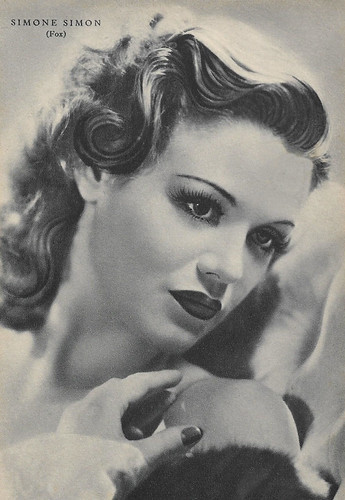
Italian postcard by Rizzoli & C., Milano, 1938. Photo: Fox.
Simone Simon (1910-2005) was one of the most seductive and brilliant stars of the French cinema of the 1930s and 1950s. In 1936-1937 and during the war years she worked in Hollywood, including the comedy Josette (Allan Dwan, 1938). Publicity dubbed her ‘La Sauvage Tendre’ (The Tender Savage). Back in France, she starred in La bête humaine/The Human Beast (Jean Renoir, 1938).
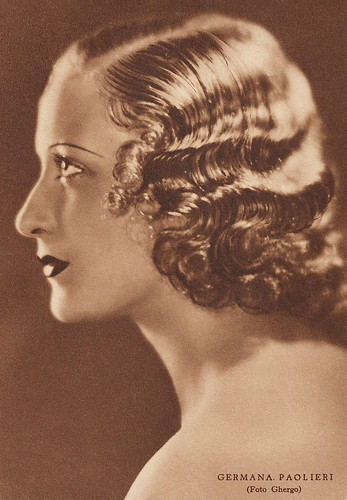
Italian postcard by Rizzoli & C., Milano, 1938. Photo: Ghergo.
Germana Paolieri (1906-1998) was an Italian stage and screen actress. After the war, she also worked for radio and television. As an actress, she flourished between the early 1930s and 1981, while as film actress she peaked in the 1930s and early 1940s, but also the mid-1950s. Paolieri played the wife of the title character in Luciano Serra pilota/Luciano Serra, Pilot (Goffredo Alessandrini, 1938). This highly successful film starred Amedeo Nazzari as an ex-pilot who has abandoned wife, child, and fatherland but is called to duty when years after his son ( Roberto Villa ) crashes with a plane in Africa and is captured by enemies. She could also be seen in Giuseppe Verdi/Verdi (Carmine Gallone, 1938), Stella del mare/Star of the Sea (Corrado D'Errico, 1938), L'allegro cantante/The Merry Singer (Gennaro Righelli, 1938), and Tutta la vita in una notte/All of Life in One Night (Corrado D'Errico, 1938).

Italian postcard by Rizzoli & C., Milano, 1938. Photo: Montebone.
Paola Barbara (1912-1989) was an Italian actress who acted in over 60 films but also worked on stage and for television. From the late 1930s on she mainly worked in Rome, e.g. at the Scalera studios, in such films as Il trionfo d'amore/Triumph of Love (Mario Mattoli, 1938), Orgoglio/Pride (Marco Elter, 1938), Lotte nell'ombra/Battles in the Shadow (Domenico Gambino, 1938), and Per uomini soli/For Men Only (Guido Brignone, 1938).
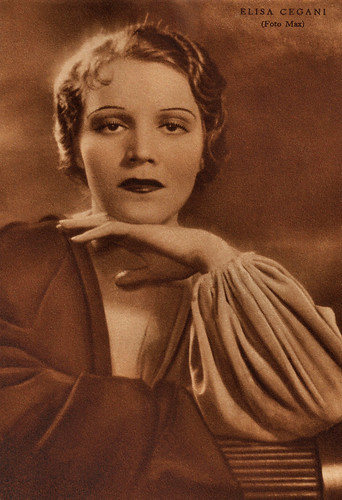
Italian postcard by Rizzoli, Milano, 1938 XVI. Photo: Max.
Elisa Cegani (1911-1996) was one of the most representative actresses of Italian cinema of the 1930s and 1940s. She played a mannequin pretending to be a countess in Contessa di Parma (Alessandro Blasetti, 1937) and was Gino Cervi 's love interest in Ettore Fieramosca (Alessandro Blasetti, 1938).
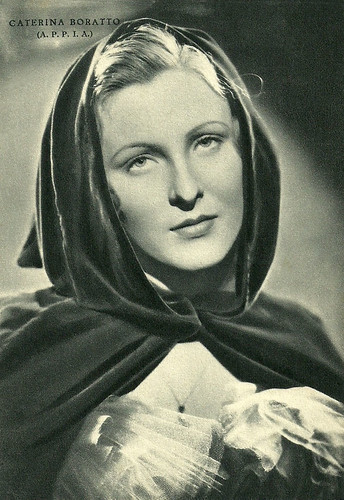
Italian postcard by Rizzoli & C., Milano, 1938. Photo: A.P.P.I.A.
Italian film actress Caterina Boratto (1915-2010) appeared in 50 films between 1936 and 1993. In 1938 she was seen in the comedy Chi è più felice di me!/Who Is Happier Than I? (Guido Brignone, 1938), and Hanno rapito un uomo/They've Kidnapped a Man (Gennaro Righelli, 1938).
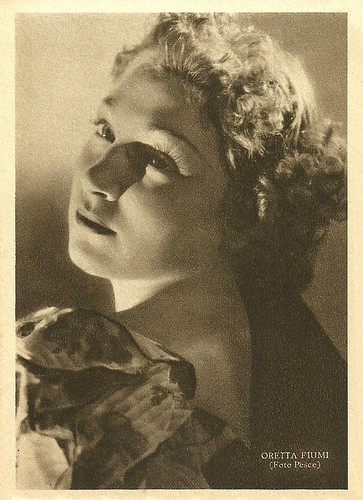
Italian postcard by Rizzoli & C., Milano, 1938. Photo: Pesce.
Oretta Fiume (1919-1994) was an Italian actress who became a star during the Fascist era after winning a competition. She started her film career in 1938 with the comedy L'orologio a cucù/The Cuckoo Clock (Camillo Mastrocinque, 1938), and a small part in Ettore Fieramosca (Alessandro Blasetti, 1938).
A centralised and vertically integrated industry
As Chris Wagstaff has written in the introduction to his book 'Italian Neorealist Cinema' (2007), the Neorealist Cinema of the immediate post-war years was closely related to the institutionalisation of Italian cinema in the 1930s. Between 1934 and 1939, Luigi Freddi, who was appointed by Mussolini to settle the film industry, promoted a centralised and vertically integrated industry, supporting the production side with subsidies and reducing (mainly foreign) competition. However, the Italian film industry was never as centralised and state-controlled as the German cinema under the Nazis.
In 1938, the large and established film companies won from Freddi’s centralisation’ policy and managed to get a law through, named after minister Dino Alfieri, which subsidised films on basis of box office receipts: the more box office, the more subsidy for next films. This didn’t stimulate innovation but favoured easy-going genre cinema. While after the war most fascist film laws were abolished, the Alfieri Law was reinstated by Giulio Andreotti in 1947-1949.
Another important effect of the Alfieri Law was the monopolisation of the importation and distribution of foreign films in Italy by a state organization, the ENIC. When the law went into effect the next year, all the Hollywood majors (MGM, Paramount, 20th Century Fox, and Warner) backed out from Italy. This was a watershed in the offer on film screens and boosted national production. It didn’t mean the total disappearance of American cinema in Italy, as the Hollywood minors such as Columbia and RKO (distributor of Disney too) continued to show their films in the Italian cinemas. Still, the difference was enormous: as Steve Ricci wrote in his book 'Cinema and Fascism: Italian Film and Society, 1922–1943' (2008), while in 1938 63 % of the film offer was American and only 13% Italian, in 1940 the Italian share was 34% and only 22% American.
One new Italian film company profited from the gap on the Italian screens, the new company Scalera, founded by the brothers Salvatore & Michele Scalera and backed by the regime. The Scalera brothers, who had been active before in building roads and airports in Italy and its colonies, copied the Hollywood studio system and attracted a ‘stable’ of actors that would match and to a certain extent even copy the major stars of Hollywood, such as Amedeo Nazzari , Rossano Brazzi, Fosco Giacchetti, Isa Pola , Luisa Ferida, and Doris Duranti . Major directors were Mario Bonnard , Amleto Palermi, and Goffredo Alessandrini, while major cinematographers were Ubaldo Arata, Massimo Terzano, and Otello Martelli.
At the 1938 Venice film festival, political pressures were getting clear: winners were two propagandistic films, Leni Riefenstahl ’s documentary Olympia (on the 1936 Berlin Olympic Games), and Alessandrini’s Luciano Serra pilota/Luciano Serra, Pilot (Goffredo Alessandrini, 1938), starring Amedeo Nazzari . While the Italians only had four features on show, 1938 was also the last year the Americans had a big presence in Venice, both in number (13 features / 10 shorts) and artistry (Jezebel, The Adventures of Tom Sawyer, Test Pilot, Vivacious Lady, etc.). Walt Disney’s feature-length Snowwhite and the Seven Dwarfs received a special award, while the Coppa Volpi for best actress was given to Norma Shearer for her part in the period piece Marie Antoinette (W.S. Van Dyke, Julien Duvivier, 1938), and for best actor to Leslie Howard in the British film Pygmalion (Anthony Asquith, Leslie Howard, 1938). The award for best director went to Carl Froehlich for Heimat/Magda (1938) with Zarah Leander .
The 1938 edition also showed for the first time a large retrospective, this time dedicated to French cinema from its origins to 1933. The audience thus could enjoy masterpieces of French cinema by the Lumière bros., Georges Méliès, Louis Feuillade, Abel Gance , Germaine Dulac, and René Clair. Yet, also recent French cinema was present with eight modern features and many shorts, including Le quai des brumes/Port of Shadows (Marcel Carné, 1938) with Jean Gabin , Michèle Morgan, and Michel Simon . It got a special recommendation. Awards were also given to the documentary The River (1938) by Pare Lorentz, while the festival audience could also see a young Ingrid Bergman in the Swedish film En Kvinnas ansikte/A Woman’s Face (Gustav Molander, 1938).
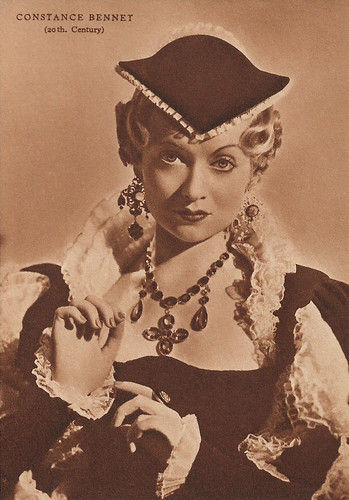
Italian postcard by Rizzoli & C. Milano, 1938. Photo: 20th Century. Constance Bennett in The Affairs of Cellini (Gregory La Cava, 1934).
Constance Bennett (1904-1965) was a Hollywood star of the 1920s and 1930s. In the early 1930s, she was for a time Hollywood's most popular and best-paid star and is known for e.g. What Price Hollywood? (George Cukor, 1932). She was the older sister of actress Joan Bennett.
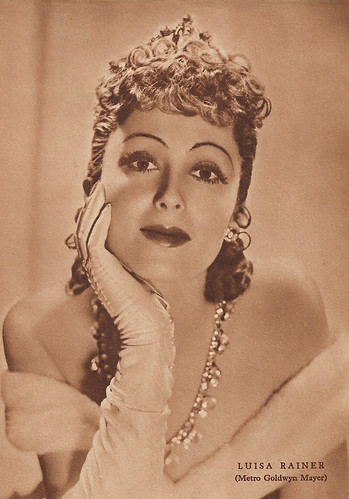
Italian postcard by Rizzoli & C. Milano, 1938. Photo: Metro-Goldwyn-Mayer.
Luise Rainer (1910–2014) was a German-American-British film actress. She was the first thespian to win multiple Academy Awards and, with that, the first to win back-to-back, for The Great Ziegfeld (Robert Z. Leonard, 1936) and The Good Earth (Sidney Franklin, 1937). In 1938, she starred in The Toy Wife (Richard Thorpe, 1938), the Johann Strauss biography The Great Waltz (Julien Duvivier, 1938), and Dramatic School (Robert B. Sinclair, 1938).
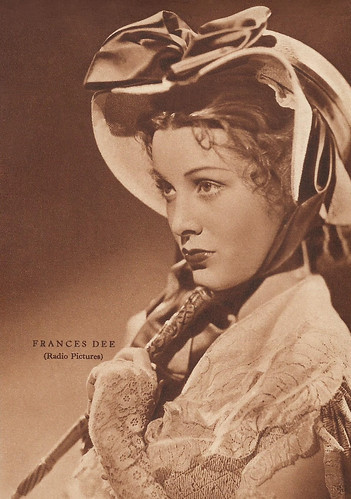
Italian postcard by Rizzoli & C. Milano, 1938. Photo: Radio Pictures (RKO). Frances Dee in Becky Sharp (Rouben Mamoulian, 1935).
Frances Dee (1909-2004) began her film career as an extra. After her breakthrough role in Playboy of Paris (Ludwig Berger, 1930) opposite Maurice Chevalier , she met Joel McCrea on the set of The Silver Cord (John Cromwell, 1933). Following a whirlwind courtship, the two married later that year. Their 57-year marriage ended in 1990 when McCrea died. In 1938, Dee starred in If I Were King (Frank Lloyd, 1938) opposite Ronald Colman .
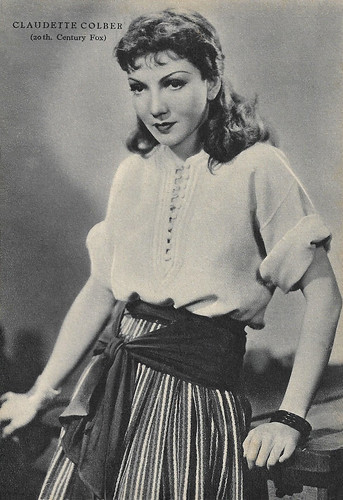
Italian postcard by Rizzoli & C. Milano, 1938. Photo: 20th Century Fox. Claudette Colbert in Under Two Flags (Frank Lloyd, 1936).
With her round apple-face, big eyes, and charm, French-born Hollywood star Claudette Colbert (1903-1996) was the epitome of chic sophistication. Her comedies It Happened One Night (Frank Capra, 1934) - for which she won the Oscar, Midnight (Mitchell Leisen, 1939) and The Palm Beach Story (Preston Sturges, 1942) are among Hollywood's greatest ever. In 1938, she co-starred with Gary Cooper in Bluebeard's Eighth Wife (Ernst Lubitsch, 1938), and in Zaza (George Cukor, 1938). After more than 60 films, she returned with great success to the theatre and was 84 years old when she won a Golden Globe for the TV mini-series The Two Mrs. Grenvilles (John Erman, 1987).
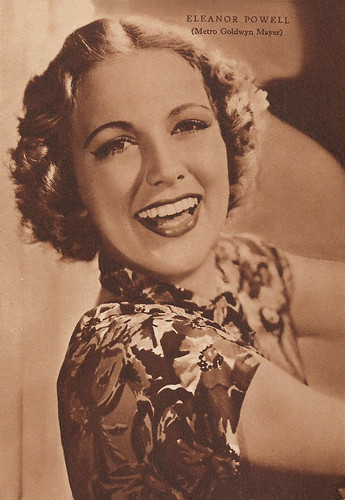
Italian postcard by Rizzoli & C. Milano, 1938. Photo: Metro-Goldwyn-Mayer.
Eleanor Powell (1912-1982) was an American dancer and actress, best remembered for her tap dance numbers in such MGM musicals as Born to Dance (Roy Del Ruth, 1936), Broadway Melody of 1938 (Roy Del Ruth, 1937), and Rosalie (W.S. Van Dyke, 1937). Her machine-gun footwork established her as the Queen of Ra-Ta-Taps.
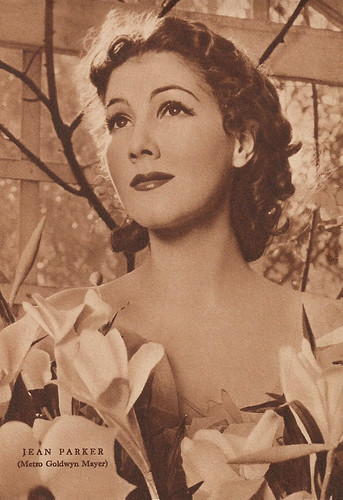
Italian postcard by Rizzoli & C. Milano, 1938. Photo: Metro-Goldwyn-Mayer.
American film and stage actress Jean Parker (1915-2005) landed her first screen test while still in high school. She had a successful career at MGM, RKO, and Columbia including roles in such films as Little Women (George Cukor, 1933), Gabriel Over the White House (Gregory La Cava, 1933), and The Ghost Goes West (René Clair, 1935). In 1938, she acted in Penitentiary (John Brahm, 1938), Romance of the Limberlost (William Nigh, 1938), and The Arkansas Traveler (Alfred Santell, 1938).
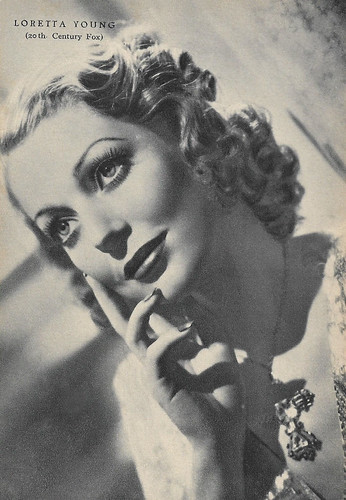
Italian postcard. Rizzoli & C. Milano, 1938. 20th Century Fox.
The film career of Loretta Young (1913-2000) peaked between the late 1920s and the early 1950s. She acted in over 100 films. In 1938, she could be seen in Four Men and a Prayer (John Ford, 1938), Three Blind Mice (William A. Seiter, 1938), Suez (Allan Dwan, 1938), and Kentucky (David Butler, 1938).

Italian postcard. Rizzoli & C. Milano, 1938. Metro Goldwyn Mayer.
Sylvia Sidney (1910-1999) was an American stage, screen, and film actress whose career spanned over 70 years. In the 1930s, she rose to prominence with leading roles in such films as City Streets (Rouben Mamoulian, 1931), Pick-Up (Marion Gering, 1933), Alfred Hitchcock's Sabotage (1936) and Fritz Lang's Fury (1936). In 1938 she starred in You and Me (Fritz Lang, 1938). She later gained attention for her role as Juno, a caseworker in the afterlife, in Tim Burton's Beetlejuice (1988).
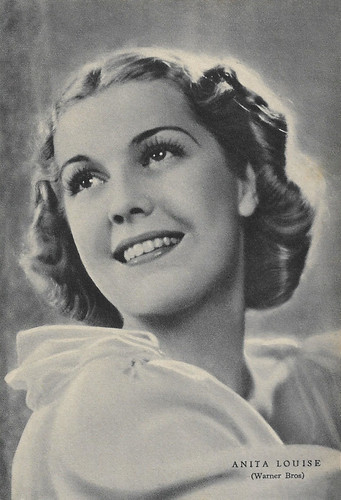
Italian postcard by Rizzoli & C. Milano, 1938. Photo: Warner Bros.
Anita Louise (1915-1970) was named as a WAMPAS Baby Star and frequently described as one of the cinema's more fashionable and stylish women. She was best known for her performances in A Midsummer Night's Dream (William Dieterle, Max Reinhardt, 1935), The Story of Louis Pasteur (William Dieterle, 1935), Anthony Adverse (Mervyn LeRoy, 1936), Marie Antoinette (W.S. Van Dyke, 1938) and The Little Princess (Walter Lang, 1939).
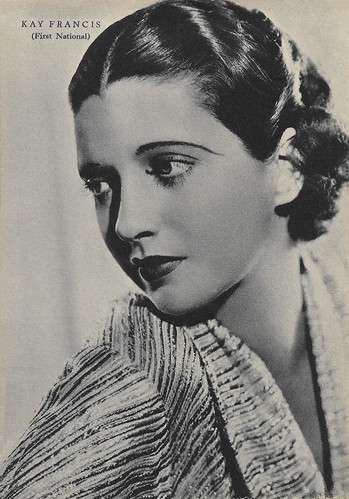
Italian postcard by Rizzoli & C. Milano, 1938. Photo: First National.
American stage and film actress Kay Francis (1905-1968) was known for films such as Ernst Lubitsch 's Trouble in Paradise (1932). After a brief period on Broadway in the late 1920s, she moved to film and achieved her greatest success between 1930 and 1936, when she first was a Paramount early sound film star but then became the number one female star at the Warner Brothers studio, becoming the highest-paid American film actress in those years. In 1939 she was declared box-office poison.
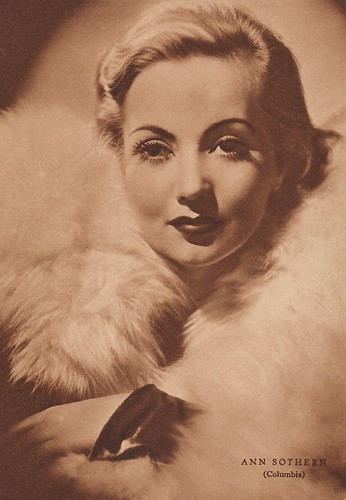
Italian postcard by Rizzoli & C. Milano, 1938. Photo: Columbia Pictures.
American actress Ann Sothern (1909-2001) had a career on stage, radio, film, and television, that spanned nearly six decades. In 1939, MGM cast her as Maisie Ravier, a brash yet lovable Brooklyn showgirl, which lead to a successful film series. In 1953, Sothern moved into television as the star of her own sitcom Private Secretary. In 1987, Sothern appeared in her final film The Whales of August (Lindsay Anderson, 1987) and earned her only Oscar nomination for Best Supporting Actress.
To be continued.
Check out Part 1 and Part 2.

Italian postcard by Rizzoli & C., Milano, 1938. Photo: Bragaglia.
Luisa Ferida (1914-1945) was an Italian stage and screen film, who was a leading actress in the late 1930s Italian sound film. In 1938, her films were Il conte di Brechard/The Count of Brechard (Mario Bonnard, 1938), Tutta la vita in una notte/All of Life in One Night (Corrado D'Errico, 1938), L'argine/The embankment (Corrado D'Errico, 1938), Il suo destino/His fate (Enrico Guazzoni, 1938), and Stella del mare/Star of the Sea (Corrado D'Errico, 1938). She was married to actor Osvaldo Valenti. Because of his close links with the fascist regime, the couple was shot by partisans in April 1945.

Italian postcard by Rizzoli & C., Milano, 1938. Photo: B.M.
Italian actress Barbara Monis (1913-?) had a short film career, acting in only three Italian films. She had minor parts in the propaganda film Vecchia guardia (Alessandro Blasetti, 1934), and Joe il rosso (Raffaello Matarazzo, 1936). She starred in La danza delle lancette/The Dance of Time (Mario Baffico, 1936). The latter film was produced by B.M. [Barbara Monis] Società Cinematografica, so this postcard may refer to this film. It is not known whether La danza delle lancette was a success, but B.M. stopped producing after this film and Monis' career stopped too.

Italian postcard by Rizzoli & C., Milano, 1938. Photo: Baccarini.
During the 1930s and early 1940s, Silvana Jachino (1916-2004) appeared in many entertainment films, musicals, and period pieces, which hardly crossed the Italian borders. With her blond, cheerful appearance, she was not destined for tragic roles, so she didn’t become a diva like other female stars of those years. However, women copied her hairstyle, makeup, and clothes. Silvana was often paired with the big male stars of those years, such as Vittorio De Sica in Partire (Amleto Palermi, 1938). Other films in 1938 were Il corsaro nero/The Black Pirate (Amleto Palermi, 1938), Lotte nell'ombra/Battles in the Shadow (Domenico Gambino, 1938), L'ultimo scugnizzo/The last urchin (Gennaro Righelli, 1938), and Crispino e la comare/Crispino and the godmother (Vincenzo Sorelli, 1938).

Italian postcard by Rizzoli & C., Milano, 1938. Photo: 20th Century Fox.
Annabella (1909-1996) was France's most popular actress during the mid-1930s, but she also achieved some success in Hollywood films of the late 1930s. In 1938 she appeared in the Hollywood productions Suez (Allan Dwan, 1938) and The Baroness and the Butler (Walter Lang, 1938), and in France in the poetic-realist classic Hôtel du Nord/Hotel du Nord (Marcel Carné, 1938).

Italian postcard by Rizzoli & C., Milano, 1938. Photo: Fox.
Simone Simon (1910-2005) was one of the most seductive and brilliant stars of the French cinema of the 1930s and 1950s. In 1936-1937 and during the war years she worked in Hollywood, including the comedy Josette (Allan Dwan, 1938). Publicity dubbed her ‘La Sauvage Tendre’ (The Tender Savage). Back in France, she starred in La bête humaine/The Human Beast (Jean Renoir, 1938).

Italian postcard by Rizzoli & C., Milano, 1938. Photo: Ghergo.
Germana Paolieri (1906-1998) was an Italian stage and screen actress. After the war, she also worked for radio and television. As an actress, she flourished between the early 1930s and 1981, while as film actress she peaked in the 1930s and early 1940s, but also the mid-1950s. Paolieri played the wife of the title character in Luciano Serra pilota/Luciano Serra, Pilot (Goffredo Alessandrini, 1938). This highly successful film starred Amedeo Nazzari as an ex-pilot who has abandoned wife, child, and fatherland but is called to duty when years after his son ( Roberto Villa ) crashes with a plane in Africa and is captured by enemies. She could also be seen in Giuseppe Verdi/Verdi (Carmine Gallone, 1938), Stella del mare/Star of the Sea (Corrado D'Errico, 1938), L'allegro cantante/The Merry Singer (Gennaro Righelli, 1938), and Tutta la vita in una notte/All of Life in One Night (Corrado D'Errico, 1938).

Italian postcard by Rizzoli & C., Milano, 1938. Photo: Montebone.
Paola Barbara (1912-1989) was an Italian actress who acted in over 60 films but also worked on stage and for television. From the late 1930s on she mainly worked in Rome, e.g. at the Scalera studios, in such films as Il trionfo d'amore/Triumph of Love (Mario Mattoli, 1938), Orgoglio/Pride (Marco Elter, 1938), Lotte nell'ombra/Battles in the Shadow (Domenico Gambino, 1938), and Per uomini soli/For Men Only (Guido Brignone, 1938).

Italian postcard by Rizzoli, Milano, 1938 XVI. Photo: Max.
Elisa Cegani (1911-1996) was one of the most representative actresses of Italian cinema of the 1930s and 1940s. She played a mannequin pretending to be a countess in Contessa di Parma (Alessandro Blasetti, 1937) and was Gino Cervi 's love interest in Ettore Fieramosca (Alessandro Blasetti, 1938).

Italian postcard by Rizzoli & C., Milano, 1938. Photo: A.P.P.I.A.
Italian film actress Caterina Boratto (1915-2010) appeared in 50 films between 1936 and 1993. In 1938 she was seen in the comedy Chi è più felice di me!/Who Is Happier Than I? (Guido Brignone, 1938), and Hanno rapito un uomo/They've Kidnapped a Man (Gennaro Righelli, 1938).

Italian postcard by Rizzoli & C., Milano, 1938. Photo: Pesce.
Oretta Fiume (1919-1994) was an Italian actress who became a star during the Fascist era after winning a competition. She started her film career in 1938 with the comedy L'orologio a cucù/The Cuckoo Clock (Camillo Mastrocinque, 1938), and a small part in Ettore Fieramosca (Alessandro Blasetti, 1938).
A centralised and vertically integrated industry
As Chris Wagstaff has written in the introduction to his book 'Italian Neorealist Cinema' (2007), the Neorealist Cinema of the immediate post-war years was closely related to the institutionalisation of Italian cinema in the 1930s. Between 1934 and 1939, Luigi Freddi, who was appointed by Mussolini to settle the film industry, promoted a centralised and vertically integrated industry, supporting the production side with subsidies and reducing (mainly foreign) competition. However, the Italian film industry was never as centralised and state-controlled as the German cinema under the Nazis.
In 1938, the large and established film companies won from Freddi’s centralisation’ policy and managed to get a law through, named after minister Dino Alfieri, which subsidised films on basis of box office receipts: the more box office, the more subsidy for next films. This didn’t stimulate innovation but favoured easy-going genre cinema. While after the war most fascist film laws were abolished, the Alfieri Law was reinstated by Giulio Andreotti in 1947-1949.
Another important effect of the Alfieri Law was the monopolisation of the importation and distribution of foreign films in Italy by a state organization, the ENIC. When the law went into effect the next year, all the Hollywood majors (MGM, Paramount, 20th Century Fox, and Warner) backed out from Italy. This was a watershed in the offer on film screens and boosted national production. It didn’t mean the total disappearance of American cinema in Italy, as the Hollywood minors such as Columbia and RKO (distributor of Disney too) continued to show their films in the Italian cinemas. Still, the difference was enormous: as Steve Ricci wrote in his book 'Cinema and Fascism: Italian Film and Society, 1922–1943' (2008), while in 1938 63 % of the film offer was American and only 13% Italian, in 1940 the Italian share was 34% and only 22% American.
One new Italian film company profited from the gap on the Italian screens, the new company Scalera, founded by the brothers Salvatore & Michele Scalera and backed by the regime. The Scalera brothers, who had been active before in building roads and airports in Italy and its colonies, copied the Hollywood studio system and attracted a ‘stable’ of actors that would match and to a certain extent even copy the major stars of Hollywood, such as Amedeo Nazzari , Rossano Brazzi, Fosco Giacchetti, Isa Pola , Luisa Ferida, and Doris Duranti . Major directors were Mario Bonnard , Amleto Palermi, and Goffredo Alessandrini, while major cinematographers were Ubaldo Arata, Massimo Terzano, and Otello Martelli.
At the 1938 Venice film festival, political pressures were getting clear: winners were two propagandistic films, Leni Riefenstahl ’s documentary Olympia (on the 1936 Berlin Olympic Games), and Alessandrini’s Luciano Serra pilota/Luciano Serra, Pilot (Goffredo Alessandrini, 1938), starring Amedeo Nazzari . While the Italians only had four features on show, 1938 was also the last year the Americans had a big presence in Venice, both in number (13 features / 10 shorts) and artistry (Jezebel, The Adventures of Tom Sawyer, Test Pilot, Vivacious Lady, etc.). Walt Disney’s feature-length Snowwhite and the Seven Dwarfs received a special award, while the Coppa Volpi for best actress was given to Norma Shearer for her part in the period piece Marie Antoinette (W.S. Van Dyke, Julien Duvivier, 1938), and for best actor to Leslie Howard in the British film Pygmalion (Anthony Asquith, Leslie Howard, 1938). The award for best director went to Carl Froehlich for Heimat/Magda (1938) with Zarah Leander .
The 1938 edition also showed for the first time a large retrospective, this time dedicated to French cinema from its origins to 1933. The audience thus could enjoy masterpieces of French cinema by the Lumière bros., Georges Méliès, Louis Feuillade, Abel Gance , Germaine Dulac, and René Clair. Yet, also recent French cinema was present with eight modern features and many shorts, including Le quai des brumes/Port of Shadows (Marcel Carné, 1938) with Jean Gabin , Michèle Morgan, and Michel Simon . It got a special recommendation. Awards were also given to the documentary The River (1938) by Pare Lorentz, while the festival audience could also see a young Ingrid Bergman in the Swedish film En Kvinnas ansikte/A Woman’s Face (Gustav Molander, 1938).

Italian postcard by Rizzoli & C. Milano, 1938. Photo: 20th Century. Constance Bennett in The Affairs of Cellini (Gregory La Cava, 1934).
Constance Bennett (1904-1965) was a Hollywood star of the 1920s and 1930s. In the early 1930s, she was for a time Hollywood's most popular and best-paid star and is known for e.g. What Price Hollywood? (George Cukor, 1932). She was the older sister of actress Joan Bennett.

Italian postcard by Rizzoli & C. Milano, 1938. Photo: Metro-Goldwyn-Mayer.
Luise Rainer (1910–2014) was a German-American-British film actress. She was the first thespian to win multiple Academy Awards and, with that, the first to win back-to-back, for The Great Ziegfeld (Robert Z. Leonard, 1936) and The Good Earth (Sidney Franklin, 1937). In 1938, she starred in The Toy Wife (Richard Thorpe, 1938), the Johann Strauss biography The Great Waltz (Julien Duvivier, 1938), and Dramatic School (Robert B. Sinclair, 1938).

Italian postcard by Rizzoli & C. Milano, 1938. Photo: Radio Pictures (RKO). Frances Dee in Becky Sharp (Rouben Mamoulian, 1935).
Frances Dee (1909-2004) began her film career as an extra. After her breakthrough role in Playboy of Paris (Ludwig Berger, 1930) opposite Maurice Chevalier , she met Joel McCrea on the set of The Silver Cord (John Cromwell, 1933). Following a whirlwind courtship, the two married later that year. Their 57-year marriage ended in 1990 when McCrea died. In 1938, Dee starred in If I Were King (Frank Lloyd, 1938) opposite Ronald Colman .

Italian postcard by Rizzoli & C. Milano, 1938. Photo: 20th Century Fox. Claudette Colbert in Under Two Flags (Frank Lloyd, 1936).
With her round apple-face, big eyes, and charm, French-born Hollywood star Claudette Colbert (1903-1996) was the epitome of chic sophistication. Her comedies It Happened One Night (Frank Capra, 1934) - for which she won the Oscar, Midnight (Mitchell Leisen, 1939) and The Palm Beach Story (Preston Sturges, 1942) are among Hollywood's greatest ever. In 1938, she co-starred with Gary Cooper in Bluebeard's Eighth Wife (Ernst Lubitsch, 1938), and in Zaza (George Cukor, 1938). After more than 60 films, she returned with great success to the theatre and was 84 years old when she won a Golden Globe for the TV mini-series The Two Mrs. Grenvilles (John Erman, 1987).

Italian postcard by Rizzoli & C. Milano, 1938. Photo: Metro-Goldwyn-Mayer.
Eleanor Powell (1912-1982) was an American dancer and actress, best remembered for her tap dance numbers in such MGM musicals as Born to Dance (Roy Del Ruth, 1936), Broadway Melody of 1938 (Roy Del Ruth, 1937), and Rosalie (W.S. Van Dyke, 1937). Her machine-gun footwork established her as the Queen of Ra-Ta-Taps.

Italian postcard by Rizzoli & C. Milano, 1938. Photo: Metro-Goldwyn-Mayer.
American film and stage actress Jean Parker (1915-2005) landed her first screen test while still in high school. She had a successful career at MGM, RKO, and Columbia including roles in such films as Little Women (George Cukor, 1933), Gabriel Over the White House (Gregory La Cava, 1933), and The Ghost Goes West (René Clair, 1935). In 1938, she acted in Penitentiary (John Brahm, 1938), Romance of the Limberlost (William Nigh, 1938), and The Arkansas Traveler (Alfred Santell, 1938).

Italian postcard. Rizzoli & C. Milano, 1938. 20th Century Fox.
The film career of Loretta Young (1913-2000) peaked between the late 1920s and the early 1950s. She acted in over 100 films. In 1938, she could be seen in Four Men and a Prayer (John Ford, 1938), Three Blind Mice (William A. Seiter, 1938), Suez (Allan Dwan, 1938), and Kentucky (David Butler, 1938).

Italian postcard. Rizzoli & C. Milano, 1938. Metro Goldwyn Mayer.
Sylvia Sidney (1910-1999) was an American stage, screen, and film actress whose career spanned over 70 years. In the 1930s, she rose to prominence with leading roles in such films as City Streets (Rouben Mamoulian, 1931), Pick-Up (Marion Gering, 1933), Alfred Hitchcock's Sabotage (1936) and Fritz Lang's Fury (1936). In 1938 she starred in You and Me (Fritz Lang, 1938). She later gained attention for her role as Juno, a caseworker in the afterlife, in Tim Burton's Beetlejuice (1988).

Italian postcard by Rizzoli & C. Milano, 1938. Photo: Warner Bros.
Anita Louise (1915-1970) was named as a WAMPAS Baby Star and frequently described as one of the cinema's more fashionable and stylish women. She was best known for her performances in A Midsummer Night's Dream (William Dieterle, Max Reinhardt, 1935), The Story of Louis Pasteur (William Dieterle, 1935), Anthony Adverse (Mervyn LeRoy, 1936), Marie Antoinette (W.S. Van Dyke, 1938) and The Little Princess (Walter Lang, 1939).

Italian postcard by Rizzoli & C. Milano, 1938. Photo: First National.
American stage and film actress Kay Francis (1905-1968) was known for films such as Ernst Lubitsch 's Trouble in Paradise (1932). After a brief period on Broadway in the late 1920s, she moved to film and achieved her greatest success between 1930 and 1936, when she first was a Paramount early sound film star but then became the number one female star at the Warner Brothers studio, becoming the highest-paid American film actress in those years. In 1939 she was declared box-office poison.

Italian postcard by Rizzoli & C. Milano, 1938. Photo: Columbia Pictures.
American actress Ann Sothern (1909-2001) had a career on stage, radio, film, and television, that spanned nearly six decades. In 1939, MGM cast her as Maisie Ravier, a brash yet lovable Brooklyn showgirl, which lead to a successful film series. In 1953, Sothern moved into television as the star of her own sitcom Private Secretary. In 1987, Sothern appeared in her final film The Whales of August (Lindsay Anderson, 1987) and earned her only Oscar nomination for Best Supporting Actress.
To be continued.
Check out Part 1 and Part 2.
Published on September 04, 2020 22:00
September 3, 2020
Karin Heske
Karin Heske (1939) was a German starlet of the 1960s and early 1970s. The blonde appeared in leading and bit roles in two dozens of cheesy comedies, Eurowesterns and "braindead" soft-sex films.
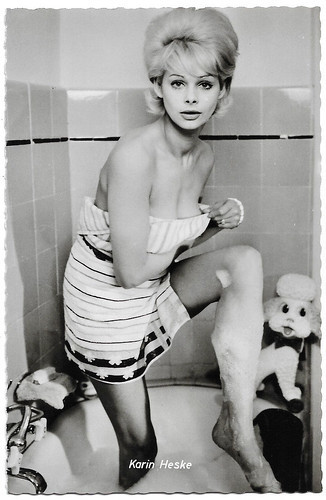
German postcard by Kolibri-Verlag G.m.b.H., Minden/Westf., no. 1773.
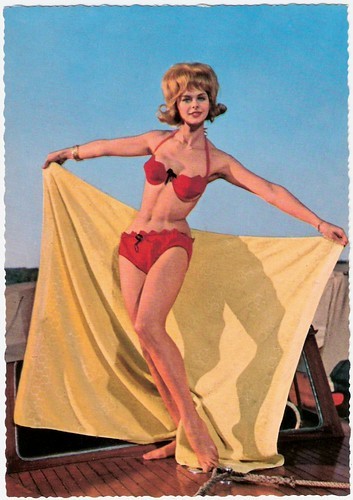
German postcard by Krüger, no. 902/191. Photo: Bernard of Hollywood.
Glamorous and Sexy Photographs
Karin Heske was born in 1939 or 1940 in Germany. Where she was born is unknown, nor if Karin Heske is her birth name. IMDb and other sites offer only the titles of her films and TV-productions: 24 between 1959 and 1976.
However, on the net can be found several glamorous and sexy photographs of her. Karin posed for Peter Basch for the November 1964 issue of Playboy magazine and probably in the same period, she posed for the lens of the legendary pin-up photographer Bernard of Hollywood (aka Bruno Bernard) of which the picture for the colour postcard above is an example.
Heske started her film career with a supporting part in the comedy Paradies der Matrosen/Paradise for Sailors (Harald Reinl, 1959) with Margit Saad and Boy Gobert.
In the following years she appeared as one of the seven gorgeous girls on vacation in Die Insel der Amazonen/Seven Daring Girls (Otto Meyer, 1960) with Adrian Hoven , and she was billed second after Ingrid Andree in Nachts ging das Telefon/The Phone Rings Every Night (Géza von Cziffra, 1962).
During the 1960s, she continued to play supporting and small parts in forgettable comedies like Mit besten Empfehlungen/With Best Regards (Kurt Nachmann, 1963) with Georg Thomalla , Wenn man baden geht auf Teneriffa/When You Go Swimming at Tenerife (Helmuth M. Backhaus, 1964) with Peter Kraus , and Unser Doktor ist der Beste/Our Doctor is the Best (Harald Vock, 1969), a vehicle for Schlager star Roy Black .

German postcard by Rüdel-Verlag. Photo: Wiener Stadthalle / Bavariafilm. Publicity still for Sing, aber spiel nicht mit mir/Sing, but don't play with me (Kurt Nachmann, 1963).
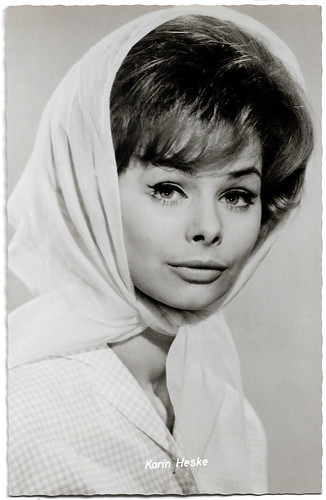
German postcard by Kolibri-Verlag G.m.b.H., Minden/Westf. Photo: Hanns Matula.
Wehrmachtsploitation
Karin Heske was quite busy during the soft-sex-comedy-wave that flooded the German cinema in the early 1970s. Her first entry in this genre was a leading part in Wer weint denn schon im Freudenhaus?/He’s at it again (Rudolf Lubowski, 1970) about a brothel.
Other (stereo)typical examples were Krankenschwestern-Report/Nurses Report (Walter Boos, 1972), Matratzen-Tango/Secrets of Naked Girls (Eberhard Schröder, 1973), and Eine Armee Gretchen/Fraulein Without A Unifrom/She Devils of the SS (Erwin C. Dietrich, 1973), with Birgit Bergen .
About the latter, Bogeyman writes at IMDb : "This film, Eine Armee Gretchen (1973) by the European trash/sleaze/soft porn-producer-king Erwin C. Dietrich is among those very few grade Z films that really make feel angry for many reasons.(...) this goes way under all the categories in its level of braindead. It has no plot or any dramatic moments to make it at least marginally interesting for a second, the acting is not acting, only reading lines in front of the camera, the scenes are ridiculous (the final battle in green grass with tanks must be seen if you thought your home video was bad) and the editing done in 2 seconds with garden scissors."
The alternate English-language title, She-Devils of the SS, hints at the notorious 'Naziploitation' subgenre, but according to Brian Lindsey at Eccentric Cinema it belongs to another subgenre: "She-Devils of the SS, makes absolutely no sense. None of the girls is a member of the Schutzstaffel, nor are they in any particular respect 'she-devils'. (...) it's uncharacteristically genteel. Oh, there's plenty of sex and nudity on display, rest assured on that point. But if you're expecting sadistic torture or grisly inhuman experiments along with the tits, bums and bush, I suggest looking to the ones made in Italy. Perhaps this movie belongs to a hitherto undefined sub-subgenre... Wehrmachtsploitation."
In those years, Heske also appeared regularly on TV. She could be seen in such Krimis as Dem Täter auf der Spur/On the Track of the Suspect (1970) and Percy Stuart (1970) with Claus Wilcke , and she played Toulouse Lautrec’s model in the operetta Der Opernball/The Opera Ball (Eugen York, 1971). She played the lead in the sex-Western Ein langer Ritt nach Eden/A Long Ride to Eden (Günter Hendel, 1974), co-starring with the later TV-star Ingrid Steeger .
On IMDb , reviewer Stefan Kahrs calls the film “An incredibly bad piece of trash. (...) We are talking bottom drawer stuff here, of a hundred-drawer cabinet, rivaling anything Edward Wood Jr., A.C. Stephen and Demofilo Fidani ever made.”
It was followed by another Eurowestern, Dallas/Ten Killers Came from Afar (Juan Bosch, 1975) with Anthony Steffen . Another IMDb -reviewer, Michael Wotruba, calls it “A Real Timewaster”.
Karin Heske was last seen before the cameras in two episodes of the popular Krimi TV-series Derrick (1975-1976).
Trailer for Eine Armee Gretchen/Fraulein Without A Unifrom/She Devils of the SS (1973). Source: CheezyFlicks (YouTube).
Sources: Brian Lindsey (Eccentric Cinema - now defunct), Stefan Kahrs (IMDb), Michael Woruba (IMDb), Bogeyman (IMDb), Wikipedia (German) and .

German postcard by Kolibri-Verlag G.m.b.H., Minden/Westf., no. 1773.

German postcard by Krüger, no. 902/191. Photo: Bernard of Hollywood.
Glamorous and Sexy Photographs
Karin Heske was born in 1939 or 1940 in Germany. Where she was born is unknown, nor if Karin Heske is her birth name. IMDb and other sites offer only the titles of her films and TV-productions: 24 between 1959 and 1976.
However, on the net can be found several glamorous and sexy photographs of her. Karin posed for Peter Basch for the November 1964 issue of Playboy magazine and probably in the same period, she posed for the lens of the legendary pin-up photographer Bernard of Hollywood (aka Bruno Bernard) of which the picture for the colour postcard above is an example.
Heske started her film career with a supporting part in the comedy Paradies der Matrosen/Paradise for Sailors (Harald Reinl, 1959) with Margit Saad and Boy Gobert.
In the following years she appeared as one of the seven gorgeous girls on vacation in Die Insel der Amazonen/Seven Daring Girls (Otto Meyer, 1960) with Adrian Hoven , and she was billed second after Ingrid Andree in Nachts ging das Telefon/The Phone Rings Every Night (Géza von Cziffra, 1962).
During the 1960s, she continued to play supporting and small parts in forgettable comedies like Mit besten Empfehlungen/With Best Regards (Kurt Nachmann, 1963) with Georg Thomalla , Wenn man baden geht auf Teneriffa/When You Go Swimming at Tenerife (Helmuth M. Backhaus, 1964) with Peter Kraus , and Unser Doktor ist der Beste/Our Doctor is the Best (Harald Vock, 1969), a vehicle for Schlager star Roy Black .

German postcard by Rüdel-Verlag. Photo: Wiener Stadthalle / Bavariafilm. Publicity still for Sing, aber spiel nicht mit mir/Sing, but don't play with me (Kurt Nachmann, 1963).

German postcard by Kolibri-Verlag G.m.b.H., Minden/Westf. Photo: Hanns Matula.
Wehrmachtsploitation
Karin Heske was quite busy during the soft-sex-comedy-wave that flooded the German cinema in the early 1970s. Her first entry in this genre was a leading part in Wer weint denn schon im Freudenhaus?/He’s at it again (Rudolf Lubowski, 1970) about a brothel.
Other (stereo)typical examples were Krankenschwestern-Report/Nurses Report (Walter Boos, 1972), Matratzen-Tango/Secrets of Naked Girls (Eberhard Schröder, 1973), and Eine Armee Gretchen/Fraulein Without A Unifrom/She Devils of the SS (Erwin C. Dietrich, 1973), with Birgit Bergen .
About the latter, Bogeyman writes at IMDb : "This film, Eine Armee Gretchen (1973) by the European trash/sleaze/soft porn-producer-king Erwin C. Dietrich is among those very few grade Z films that really make feel angry for many reasons.(...) this goes way under all the categories in its level of braindead. It has no plot or any dramatic moments to make it at least marginally interesting for a second, the acting is not acting, only reading lines in front of the camera, the scenes are ridiculous (the final battle in green grass with tanks must be seen if you thought your home video was bad) and the editing done in 2 seconds with garden scissors."
The alternate English-language title, She-Devils of the SS, hints at the notorious 'Naziploitation' subgenre, but according to Brian Lindsey at Eccentric Cinema it belongs to another subgenre: "She-Devils of the SS, makes absolutely no sense. None of the girls is a member of the Schutzstaffel, nor are they in any particular respect 'she-devils'. (...) it's uncharacteristically genteel. Oh, there's plenty of sex and nudity on display, rest assured on that point. But if you're expecting sadistic torture or grisly inhuman experiments along with the tits, bums and bush, I suggest looking to the ones made in Italy. Perhaps this movie belongs to a hitherto undefined sub-subgenre... Wehrmachtsploitation."
In those years, Heske also appeared regularly on TV. She could be seen in such Krimis as Dem Täter auf der Spur/On the Track of the Suspect (1970) and Percy Stuart (1970) with Claus Wilcke , and she played Toulouse Lautrec’s model in the operetta Der Opernball/The Opera Ball (Eugen York, 1971). She played the lead in the sex-Western Ein langer Ritt nach Eden/A Long Ride to Eden (Günter Hendel, 1974), co-starring with the later TV-star Ingrid Steeger .
On IMDb , reviewer Stefan Kahrs calls the film “An incredibly bad piece of trash. (...) We are talking bottom drawer stuff here, of a hundred-drawer cabinet, rivaling anything Edward Wood Jr., A.C. Stephen and Demofilo Fidani ever made.”
It was followed by another Eurowestern, Dallas/Ten Killers Came from Afar (Juan Bosch, 1975) with Anthony Steffen . Another IMDb -reviewer, Michael Wotruba, calls it “A Real Timewaster”.
Karin Heske was last seen before the cameras in two episodes of the popular Krimi TV-series Derrick (1975-1976).
Trailer for Eine Armee Gretchen/Fraulein Without A Unifrom/She Devils of the SS (1973). Source: CheezyFlicks (YouTube).
Sources: Brian Lindsey (Eccentric Cinema - now defunct), Stefan Kahrs (IMDb), Michael Woruba (IMDb), Bogeyman (IMDb), Wikipedia (German) and .
Published on September 03, 2020 22:00
September 2, 2020
Photo by Evans
Nelson Evans (1889-1922), who signed as "Evans, L.A.", was a photographer during the days of early Hollywood. Evans was known for his portraits of film actors such as Mary Pickford, Marie Prevost, Jackie Coogan, and many others during the silent film era including director Philip Rosen. He is also considered one of the creators of pin-up photography.
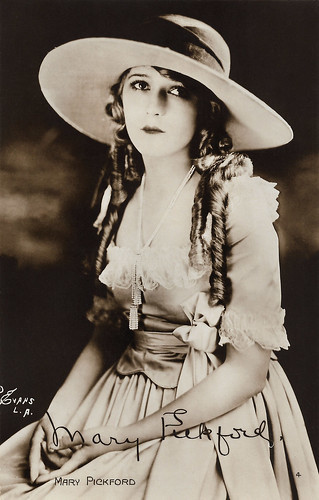
French postcard by Cinemagazine-Edition, no. 4. Photo: Evans, L.A.
Mary Pickford (1892-1972) was a legendary silent film actress and was known as 'America’s sweetheart.' She was a founder of United Artists and helped establish the Academy.
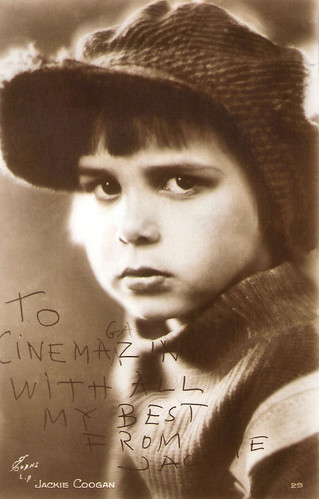
French postcard by Cinémagazine-Edition, no. 29. Photo: Evans, L.A.
American actor John Leslie 'Jackie' Coogan (1914-1984) began as a child star in silent films. He was Charlie Chaplin 's irascible sidekick in The Kid (Charles Chaplin, 1921) and played the title role in Oliver Twist (Frank Lloyd, 1922). Many years later, he became known as Uncle Fester in the TV series The Addams Family (1964-1966). In the interim, he sued his mother and stepfather over his squandered film earnings ($48 million to $65 million adjusted for 2012 dollars) and provoked California to enact the first known legal protection for the earnings of child performers, widely known as 'the Coogan Act'.
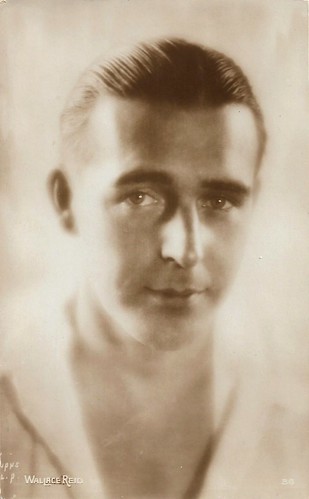
French postcard by Cinémagazine-Edition, no. 36. Photo: Evans.
Wallace Reid (1891-1923) was an American actor in the silent film referred to as "the screen's most perfect lover". A morphine addiction killed him, at the age of only 31.
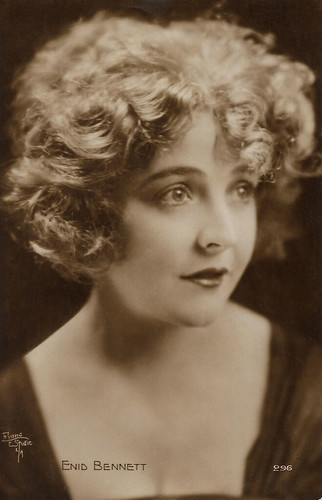
French postcard by Cinémagazine-Edition / A.N., Paris, no. 296. Photo: Evans Studio, L.A.
Enid Bennett (1893-1969) was an Australian-born silent film actress, mostly active in the American cinema. She peaked in the late 1910s and early 1920s with films such as Robin Hood (1922), starring Douglas Fairbanks , and The Sea Hawk (1924). In the sound era, she played Jackie Coogan 's mother in the Oscar-winning film Skippy (1931). She was the wife of director Fred Niblo and after his death of director Sidney Franklin.
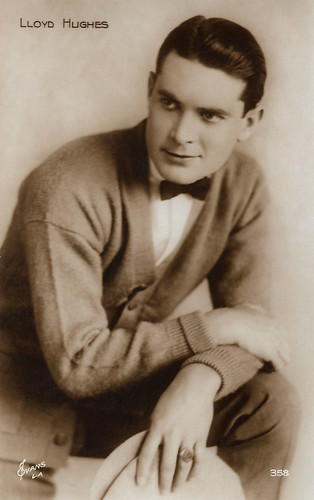
French postcard by Cinémagazine-Edition, Paris, no. 358. Photo: Evans, L.A.
Clean-cut, sensitive Lloyd Hughes (1897-1958) was an American actor of both the silent and sound film eras. He appeared in such silent classics as Tess of the Storm Country (1921), The Sea Hawk (1924), and The Lost World (1925).
A market niche
Nelson Frazier Evans was born in Columbus, Ohio in 1889. He was the son of a coal mine operator, who objected to Evans' choice to pursue a career in photography.
Initially working in the eastern United States, Evans moved to the west coast in the 1910s to pursue a career as a portrait photographer in Hollywood.
In 'Still: American Silent Motion Picture Photography', historian David Shields writes that Evans "had the most playful visual imagination of any of the early photographers of Hollywood". He took the first candid film star photos in an assignment for Photo-Play in late 1914.
In 1915, Evans established a studio at 6039 Hollywood Boulevard. At the time, Hollywood studio photographers focused mainly on shooting film stills of sets and scenes — actors and actresses were forced to find personal photographers to take portrait shots.
This market niche was filled by professional photographers like Evans. He also did more traditional still photography for a number of prominent film studios, including Paramount, Fox, Famous Players-Lasky, First National, and Metro Ince Studios.
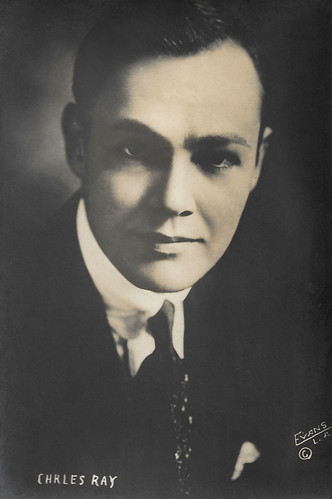
Spanish postcard. Photo: Evans, Los Angeles.
Charles Ray (1891-1943) was an American actor, scriptwriter, and director of the silent screen, who knew a parabole from rags to riches and back again. He worked for Paramount, his own company, United Artists and MGM. In the late 1910s and early 1920s, he was a very popular actor and one of Hollywood's best-paid stars.
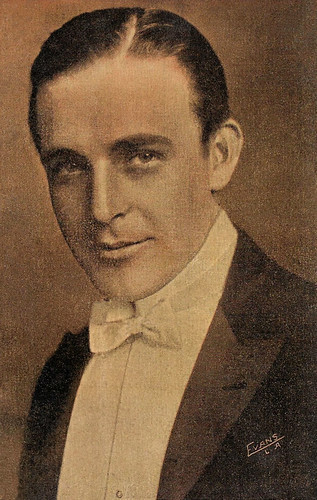
Spanish collectors card by Amatller Marca Luna, series 11, no. 20. Photo: Evans, L.A.
Wallace Reid (1891-1923) was an American actor in the silent film referred to as "the screen's most perfect lover". A morphine addiction killed him, at the age of only 31.
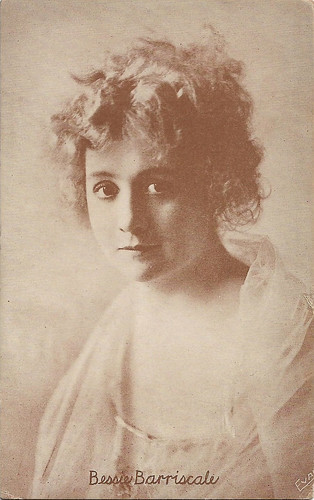
American postcard. Photo: Evans.
Bessie Barriscale (1884-1965) was an Edwardian-era stage actress, noted for her beautiful eyes. In films from 1913, the American actress became a major star with Thomas H. Ince and Kay-Bee until the early 1920s.
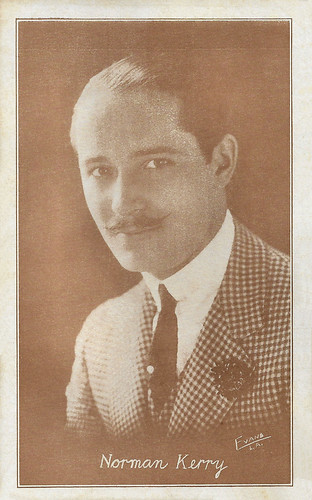
American postcard. Photo: Evans, L.A.
Norman Kerry (1894–1956) was an American actor of the silent era, who peaked in the Lon Chaney films The Hunchback of the Notre Dame (1923), The Phantom of the Opera (1925) and The Unknown (1927).
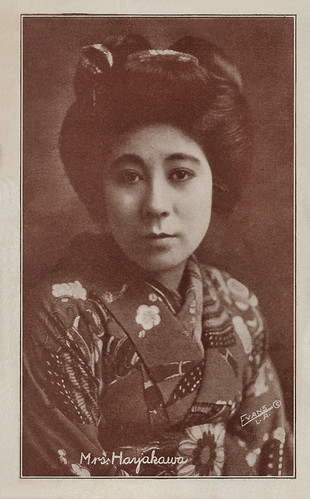
American postcard. Photo: Evans, L.A.
Screen and stage actress Tsuru Aoki (1892-1961) was the first female film star from Asia in the United States. Throughout the 1910s, Aoki would appear in approximately forty films, often in leading-lady roles. From 1914 on, she was married to Sessue Hayakawa and they co-starred in 20 films.
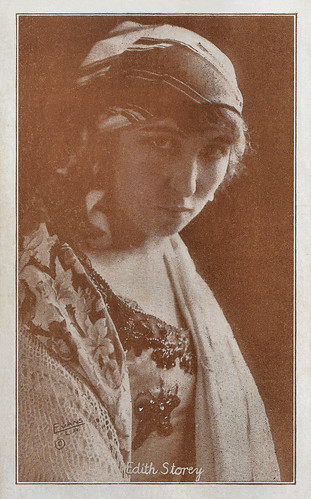
American postcard. Photo: Evans, L.A.
American actress Edith Storey (1892-1967) was a silent film star who was an unusual combination of an intelligent actress and an outdoor athlete. She often appeared in Westerns, period dramas and adventure films. For a long time, she worked for Vitagraph and in 1918, she became one of the stars of Metro.
Creating Cheesecake Photography
Evans introduced several innovations to the photography scene of Old Hollywood. He avoided using the traditional fancy props like the ornate chair and the brocade drape. He painted effects or backgrounds directly on photo negatives.
Evans is also credited by David S. Shields with creating the genre of 'Cheesecake Photography', a forerunner to pin-up photography. He made seaside portraits of Mack Sennett's bathing beauties cavorting on the rocks and in the surf in swimwear. Some of these full-body swimsuit photos appeared in magazines and on cigarette packages.
During World War I, Evans was drafted into government service and stationed in New York City. He was commissioned as a first lieutenant and was involved with the growing field of aerial photography, for which he attempted to develop a new camera.
In the early 1920s, Evans rivaled Albert Witzel as Hollywood's favourite photographer. David S. Shields: "Evans borrowed liberally from a broader range of models than any of his competitors in Los Angeles. His focus could be sharp, like Mojonier, or as poetically soft as Sartov. He could shoot fanciful full-figure vignettes like James Abbe, or superbly lit and expressive close-ups like Melbourne Spurr."
In 1922, Nelson Evans died in Los Angeles at the age of 33. Following his death, Evans' studio was converted into an art gallery. In 1929, his studio was damaged by a fire possibly set as part of a wider vendetta against still photographers operating in Hollywood. Evans' early death resulted in him fading from memory more so than his contemporaries, such as Fred Hartsook and Witzel.

British postcard in the Cinema Chat series. Photo: Evans / Pathé.
Fannie Ward, a.k.a. Fanny Ward (1872–1952) was an American actress of stage and screen, known for The Cheat (1915), a sexually- and racially-charged silent film directed by Cecil B. DeMille. In the late 1910s, she did a series of films for Astra Films, released by Pathé Exchange.
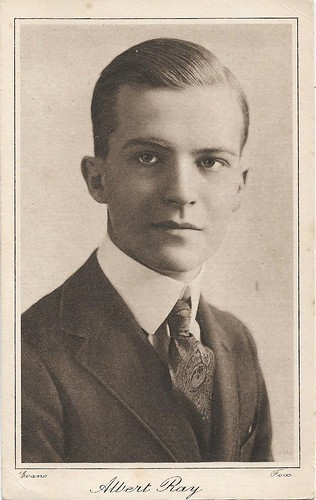
British postcard. Photo: Evans / Fox. This card must be from around 1918-1920.
Albert Ray (1897–1944) was an American film director, actor, and screenwriter. He appeared in 22 films between 1915 and 1921 and he directed 85 films between 1920 and 1939.
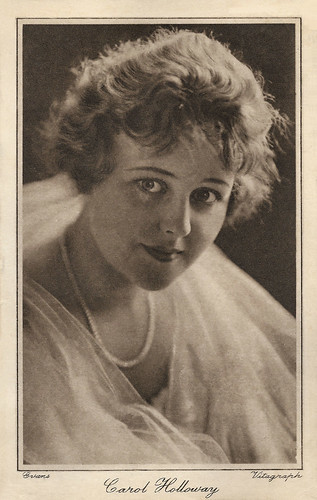
British postcard. Photo: Evans / Vitagraph.
Carol Holloway (1892–1979) was an American screen actress and writer. In the late 1910s, she was an important serial queen at Vitagraph.
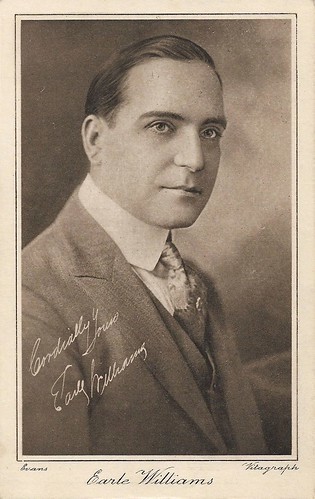
British postcard. Photo: Evans / Vitagraph.
In the 1910s, Earle Williams (1880-1927) was the leading man of the American film company Vitagraph, often paired with Anita Stewart. He was subsequently successful at Paramount. Due to bronchial pneumonia, he already died when he was 47.
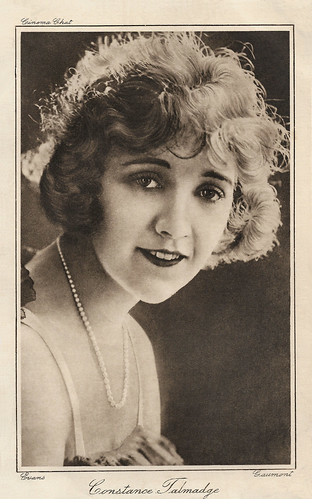
British postcard. Photo: Evans / Gaumont.
Constance Talmadge (1898-1973) was an actress of the American silent screen. Talmadge appeared in over 80 films, mostly comedies of manners. Together with her sister Norma, Constance Talmadge was billed as one of the biggest stars of the twenties.
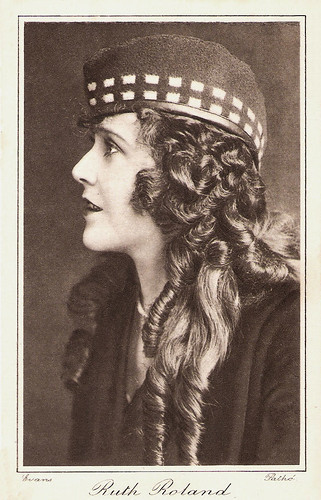
British postcard. Photo: Evans / Pathé.
Ruth Roland (1892–1937) was an American stage and film actress and film producer. Between 1911 and 1914 she was the leading actress of Kalem, from 1914 to 1917 she acted at Balboa Films, in popular serials such as The Red Circle, distributed by Pathé Exchange, and with Frank Mayo as her leading man. A clever businesswoman, she established her own production company, Ruth Roland Serials, and signed a distribution deal with Pathé to make seven new multi-episode serials that proved very successful, e.g. the crime serial The Adventures of Ruth (George Marshall, 1919) and the Western serial Ruth of the Rockies (George Marshall, 1920). In 1979 a concrete box with Roland's private nitrate film collection was found in her backyard and donated to the UCLA Film Archive, including the complete 12-part serial Who Pays? (1915) with Roland herself in the lead opposite Henry King (who co-directed as well).
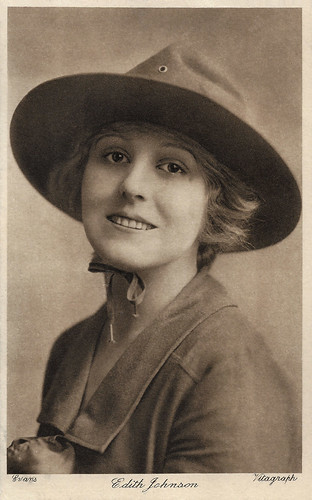
British postcard. Photo: Evans / Vitagraph.
Edith Johnson (1894-1969) was an American actress of the silent era. She appeared in 66 films between 1913 and 1924, mostly serials, action films, and Westerns. She and husband William Duncan were "the king and queen of the serial".
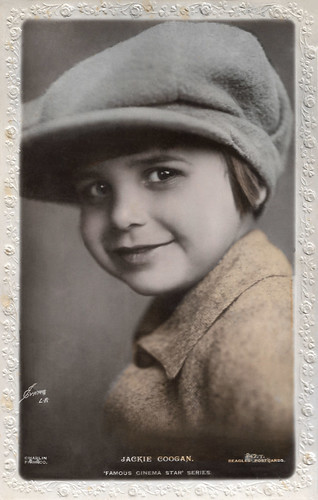
British postcard by Beagles Postcards in the Famous Cinema Star Series, no. 247 T. Photo: Evans / Chaplin Film Co.

French postcard in the Les Vedettes du Cinéma series by Filma, no. 11. Photo: Evans, L.A. / Agence Générale Cinematographique.
Sources: David S. Shields (Still: American Silent Motion Picture Photography), and Wikipedia.
This was the last post in a series on photographers.

French postcard by Cinemagazine-Edition, no. 4. Photo: Evans, L.A.
Mary Pickford (1892-1972) was a legendary silent film actress and was known as 'America’s sweetheart.' She was a founder of United Artists and helped establish the Academy.

French postcard by Cinémagazine-Edition, no. 29. Photo: Evans, L.A.
American actor John Leslie 'Jackie' Coogan (1914-1984) began as a child star in silent films. He was Charlie Chaplin 's irascible sidekick in The Kid (Charles Chaplin, 1921) and played the title role in Oliver Twist (Frank Lloyd, 1922). Many years later, he became known as Uncle Fester in the TV series The Addams Family (1964-1966). In the interim, he sued his mother and stepfather over his squandered film earnings ($48 million to $65 million adjusted for 2012 dollars) and provoked California to enact the first known legal protection for the earnings of child performers, widely known as 'the Coogan Act'.

French postcard by Cinémagazine-Edition, no. 36. Photo: Evans.
Wallace Reid (1891-1923) was an American actor in the silent film referred to as "the screen's most perfect lover". A morphine addiction killed him, at the age of only 31.

French postcard by Cinémagazine-Edition / A.N., Paris, no. 296. Photo: Evans Studio, L.A.
Enid Bennett (1893-1969) was an Australian-born silent film actress, mostly active in the American cinema. She peaked in the late 1910s and early 1920s with films such as Robin Hood (1922), starring Douglas Fairbanks , and The Sea Hawk (1924). In the sound era, she played Jackie Coogan 's mother in the Oscar-winning film Skippy (1931). She was the wife of director Fred Niblo and after his death of director Sidney Franklin.

French postcard by Cinémagazine-Edition, Paris, no. 358. Photo: Evans, L.A.
Clean-cut, sensitive Lloyd Hughes (1897-1958) was an American actor of both the silent and sound film eras. He appeared in such silent classics as Tess of the Storm Country (1921), The Sea Hawk (1924), and The Lost World (1925).
A market niche
Nelson Frazier Evans was born in Columbus, Ohio in 1889. He was the son of a coal mine operator, who objected to Evans' choice to pursue a career in photography.
Initially working in the eastern United States, Evans moved to the west coast in the 1910s to pursue a career as a portrait photographer in Hollywood.
In 'Still: American Silent Motion Picture Photography', historian David Shields writes that Evans "had the most playful visual imagination of any of the early photographers of Hollywood". He took the first candid film star photos in an assignment for Photo-Play in late 1914.
In 1915, Evans established a studio at 6039 Hollywood Boulevard. At the time, Hollywood studio photographers focused mainly on shooting film stills of sets and scenes — actors and actresses were forced to find personal photographers to take portrait shots.
This market niche was filled by professional photographers like Evans. He also did more traditional still photography for a number of prominent film studios, including Paramount, Fox, Famous Players-Lasky, First National, and Metro Ince Studios.

Spanish postcard. Photo: Evans, Los Angeles.
Charles Ray (1891-1943) was an American actor, scriptwriter, and director of the silent screen, who knew a parabole from rags to riches and back again. He worked for Paramount, his own company, United Artists and MGM. In the late 1910s and early 1920s, he was a very popular actor and one of Hollywood's best-paid stars.

Spanish collectors card by Amatller Marca Luna, series 11, no. 20. Photo: Evans, L.A.
Wallace Reid (1891-1923) was an American actor in the silent film referred to as "the screen's most perfect lover". A morphine addiction killed him, at the age of only 31.

American postcard. Photo: Evans.
Bessie Barriscale (1884-1965) was an Edwardian-era stage actress, noted for her beautiful eyes. In films from 1913, the American actress became a major star with Thomas H. Ince and Kay-Bee until the early 1920s.

American postcard. Photo: Evans, L.A.
Norman Kerry (1894–1956) was an American actor of the silent era, who peaked in the Lon Chaney films The Hunchback of the Notre Dame (1923), The Phantom of the Opera (1925) and The Unknown (1927).

American postcard. Photo: Evans, L.A.
Screen and stage actress Tsuru Aoki (1892-1961) was the first female film star from Asia in the United States. Throughout the 1910s, Aoki would appear in approximately forty films, often in leading-lady roles. From 1914 on, she was married to Sessue Hayakawa and they co-starred in 20 films.

American postcard. Photo: Evans, L.A.
American actress Edith Storey (1892-1967) was a silent film star who was an unusual combination of an intelligent actress and an outdoor athlete. She often appeared in Westerns, period dramas and adventure films. For a long time, she worked for Vitagraph and in 1918, she became one of the stars of Metro.
Creating Cheesecake Photography
Evans introduced several innovations to the photography scene of Old Hollywood. He avoided using the traditional fancy props like the ornate chair and the brocade drape. He painted effects or backgrounds directly on photo negatives.
Evans is also credited by David S. Shields with creating the genre of 'Cheesecake Photography', a forerunner to pin-up photography. He made seaside portraits of Mack Sennett's bathing beauties cavorting on the rocks and in the surf in swimwear. Some of these full-body swimsuit photos appeared in magazines and on cigarette packages.
During World War I, Evans was drafted into government service and stationed in New York City. He was commissioned as a first lieutenant and was involved with the growing field of aerial photography, for which he attempted to develop a new camera.
In the early 1920s, Evans rivaled Albert Witzel as Hollywood's favourite photographer. David S. Shields: "Evans borrowed liberally from a broader range of models than any of his competitors in Los Angeles. His focus could be sharp, like Mojonier, or as poetically soft as Sartov. He could shoot fanciful full-figure vignettes like James Abbe, or superbly lit and expressive close-ups like Melbourne Spurr."
In 1922, Nelson Evans died in Los Angeles at the age of 33. Following his death, Evans' studio was converted into an art gallery. In 1929, his studio was damaged by a fire possibly set as part of a wider vendetta against still photographers operating in Hollywood. Evans' early death resulted in him fading from memory more so than his contemporaries, such as Fred Hartsook and Witzel.

British postcard in the Cinema Chat series. Photo: Evans / Pathé.
Fannie Ward, a.k.a. Fanny Ward (1872–1952) was an American actress of stage and screen, known for The Cheat (1915), a sexually- and racially-charged silent film directed by Cecil B. DeMille. In the late 1910s, she did a series of films for Astra Films, released by Pathé Exchange.

British postcard. Photo: Evans / Fox. This card must be from around 1918-1920.
Albert Ray (1897–1944) was an American film director, actor, and screenwriter. He appeared in 22 films between 1915 and 1921 and he directed 85 films between 1920 and 1939.

British postcard. Photo: Evans / Vitagraph.
Carol Holloway (1892–1979) was an American screen actress and writer. In the late 1910s, she was an important serial queen at Vitagraph.

British postcard. Photo: Evans / Vitagraph.
In the 1910s, Earle Williams (1880-1927) was the leading man of the American film company Vitagraph, often paired with Anita Stewart. He was subsequently successful at Paramount. Due to bronchial pneumonia, he already died when he was 47.

British postcard. Photo: Evans / Gaumont.
Constance Talmadge (1898-1973) was an actress of the American silent screen. Talmadge appeared in over 80 films, mostly comedies of manners. Together with her sister Norma, Constance Talmadge was billed as one of the biggest stars of the twenties.

British postcard. Photo: Evans / Pathé.
Ruth Roland (1892–1937) was an American stage and film actress and film producer. Between 1911 and 1914 she was the leading actress of Kalem, from 1914 to 1917 she acted at Balboa Films, in popular serials such as The Red Circle, distributed by Pathé Exchange, and with Frank Mayo as her leading man. A clever businesswoman, she established her own production company, Ruth Roland Serials, and signed a distribution deal with Pathé to make seven new multi-episode serials that proved very successful, e.g. the crime serial The Adventures of Ruth (George Marshall, 1919) and the Western serial Ruth of the Rockies (George Marshall, 1920). In 1979 a concrete box with Roland's private nitrate film collection was found in her backyard and donated to the UCLA Film Archive, including the complete 12-part serial Who Pays? (1915) with Roland herself in the lead opposite Henry King (who co-directed as well).

British postcard. Photo: Evans / Vitagraph.
Edith Johnson (1894-1969) was an American actress of the silent era. She appeared in 66 films between 1913 and 1924, mostly serials, action films, and Westerns. She and husband William Duncan were "the king and queen of the serial".

British postcard by Beagles Postcards in the Famous Cinema Star Series, no. 247 T. Photo: Evans / Chaplin Film Co.

French postcard in the Les Vedettes du Cinéma series by Filma, no. 11. Photo: Evans, L.A. / Agence Générale Cinematographique.
Sources: David S. Shields (Still: American Silent Motion Picture Photography), and Wikipedia.
This was the last post in a series on photographers.
Published on September 02, 2020 22:00
September 1, 2020
Grazia del Rio
Little is known about the personal life of Italian actress and singer Grazia Del Rio, but probably because of her singing voice and clear vocals she had a prolific career in the earliest years of sound cinema. Between 1930 and 1933 she had a short but intense film career in Italy and France, peaking with La stella del cinema (Mario Almirante, 1931) in which she starred as herself. In the late 1930s, she had a second career in Argentina and Chile.
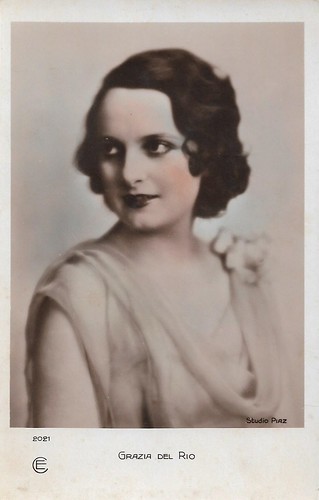
French postcard by Cinémagazine-Editions, no. 2021. Photo: Studio Piaz.

French postcard by Europe, no. 992. Photo: Produzione Pittaluga Cines, Roma.
Music-Hall
According to Elena Mosconi, Grazia Del Rio aka Gracia del Río came from Santiago, Chili, studied piano in Paris, and song and dance in Milan.
Grazia Del Rio became a music-hall actress. She herself claimed to have performed with the music-hall Za-Bum in the shows 'Broadway' and 'K.41'. Del Rio acted in one late silent film shot in Africa, Tramonto dei blasoni/Sunset of the blazons (Attilio Gatti, 1928), even if it is unsure whether that film really was released.
Her breakthrough came in 1930 with the earliest sound films made at the Cines Pittaluga studio in Rome, equipped for sound cinema in that year. Already in 1929 she sang in a short recorded by director Baldassarre Negroni, Serenata Tzigana/Gypsy Serenade (released in 1930), made to test the new sound equipment of the ENAC company.
Negroni would henceforth become a floor manager at the new Cines Pittaluga sound film studios. It was here that in 1930 Del Rio performed as singer and actress in a series of Cines shorts by Mario Almirante, including Donne alla fonte/Women at the source and Fantasia di bambole/Fantasy of dolls. The latter was found at the EYE Filmmuseum years ago.
Together with actor Elio Steiner, Del Rio played a host to the film spectators in the first of a series of shorts by Cines, called Rivista Cines. It showed the new studios and a visit by Minister Giuseppe Bottai . The short was shown together with what goes as the first Italian sound film, La canzone dell'amore/The Song of Love, at its premiere at the Roman Supercinema (now Teatro Nazionale) on 8 October 1930.
One month after, the film Nerone/Nero (Alessandro Blasetti, 1930) was released, an anachronistic comedy with Ettore Petrolini in the title role and Del Rio as his admirer. Then she played a supporting part in the Armando Falconi comedy Rubacuori/Heartbreaker (Guido Brignone, 1931).
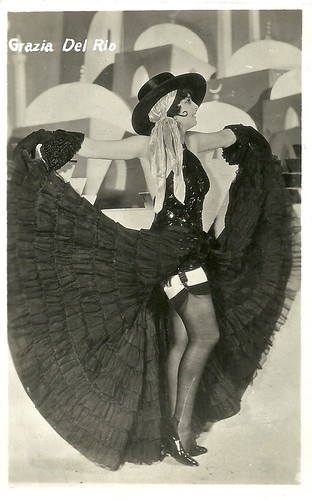
Italian postcard. The back of this Italian postcard has a stamp promoting Grazia del Rio in Paris: "Grazia del Rio. TALKIES FILMS. Pianiste Concertiste. Vedette Internationale de Chant (5 langues) Danse et Musique. La Vedette en Italie de la "Za Bum"pour "Broadway" et "K.41". Parle sans aucun accent étranger le français, l'italien, l'espagnol et assez bien l'anglais. Sports: cheval, natation, patinage, etc. Adresse permanente: Via Cicerone 44 - ROME." Written on the card: "Act[uellement] 178, Bd. Berthier. Tel. Carnot 59-72."

French postcard by P-C, Paris, no. 25. Photo: Gaumont / Franco-Film / Aubert. Grazia Del Rio sang the 'valse musette' 'Les d'moisell's de Montparnasse' in La petite de Montparnasse/Die Mädels von Montparnasse (Hanns Schwarz, 1932). Text by Lucien Boyer, and music by F. Wachsmann. Copyright: Alrobi, Berlin/ Ed. Salabert, Paris.
Where did Grazia go?
Grazia Del Rio starred in the film La stella del cinema/The cinema star (Mario Almirante, 1931), about a debuting actress who is catapulted into stardom, while her fiancé (Elio Steiner) remains an extra. Twenty years before Stanley Donen's Singin' in the rain, the histrionic acting of the former silent film actress (Sandra Ravel) is discredited, and the 'au naturel' acting of the newcomer is favored as more apt to the new medium. The plot was an excuse to give a peek into the behind-the-screens of the modern Cines sound film studio and shows both actors and directors from the silent days and the new sound film generation. A few years ago, the film was fully restored and released on DVD.
Del Rio also went to France to act in early sound films there: first in La dernière berceuse/The last lullaby (Gennaro Righelli, 1931), the French version of Righelli's own La canzone dell'amore, starring Dolly Davis and Jean Angelo instead of Dria Paola and Elio Steiner, and with Del Rio in the part of Isa Pola .
This would be followed by Mon ami Tim/Fifty Fathoms Deep (Jack Forrester, 1932) with Jeanne Helbling and Thomy Bourdelle , and La petite de Montparnasse/The little one from Montparnasse (Hanns Schwarz, 1932), in which she starred herself, opposite Lucien Gallas.
In 1933 she had a supporting part in the comedy Les aventures du roi Pausole/The Adventures of King Pausole (Alexis Granowsky, 1933), starring André Berley and filmed at the Côte d'Azur. Del Rio also played in the German language version of the film, Die Abenteuer des Königs Pausole (1933), in which Emil Jannings played the title character.
Del Rio remained in France for three more films: the comedy Le tendron d'Achille/Achilles' Heel (Christian-Jaque, 1933), Le relais d'amour/The love relay (André Pellenc, 1933), and La nuit des dupes/The night of the Fools (Maurice Labro, Pierre Weill, 1933) with Roland Toutain .
After that, Grazia Del Rio's European film career was over. It is not entirely clear what happened to her.
She might have gone back to Chile. Her namesake Grazia Del Rio made various films in 1938-1940 in Argentina and Chile: in Argentina, Turbión/Turbion (Antonio Momplet, 1938), El misterio de la dama gris/The mystery of the gray lady (James Bauer, 1939), Ambición/Ambition (Adelqui Migliar, 1939), and La luz de un fósforo/The light of a match (Leopoldo Torres Ríos, 1940). In Chile, she also made Entre gallos y medianoche/Between roosters and midnight (Eugenio de Liguoro, 1940).
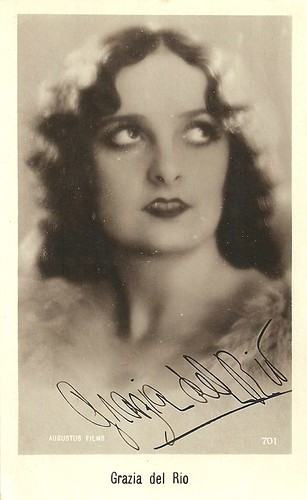
Italian postcard, no. 701. Photo: Augustus Films.
Signorina Grazia Del Rio (1931). Source: British Pathé (YouTube).
Rivista Cines n°1 il Cinema Sonoro di Luciano Muratori. Source: Ughetto50 (YouTube).
Sources: Elena Mosconi ('L 'altra Pittaluga', Immagine No. 16, 2017 - Italian), Taxidrivers (Italian), and .

French postcard by Cinémagazine-Editions, no. 2021. Photo: Studio Piaz.

French postcard by Europe, no. 992. Photo: Produzione Pittaluga Cines, Roma.
Music-Hall
According to Elena Mosconi, Grazia Del Rio aka Gracia del Río came from Santiago, Chili, studied piano in Paris, and song and dance in Milan.
Grazia Del Rio became a music-hall actress. She herself claimed to have performed with the music-hall Za-Bum in the shows 'Broadway' and 'K.41'. Del Rio acted in one late silent film shot in Africa, Tramonto dei blasoni/Sunset of the blazons (Attilio Gatti, 1928), even if it is unsure whether that film really was released.
Her breakthrough came in 1930 with the earliest sound films made at the Cines Pittaluga studio in Rome, equipped for sound cinema in that year. Already in 1929 she sang in a short recorded by director Baldassarre Negroni, Serenata Tzigana/Gypsy Serenade (released in 1930), made to test the new sound equipment of the ENAC company.
Negroni would henceforth become a floor manager at the new Cines Pittaluga sound film studios. It was here that in 1930 Del Rio performed as singer and actress in a series of Cines shorts by Mario Almirante, including Donne alla fonte/Women at the source and Fantasia di bambole/Fantasy of dolls. The latter was found at the EYE Filmmuseum years ago.
Together with actor Elio Steiner, Del Rio played a host to the film spectators in the first of a series of shorts by Cines, called Rivista Cines. It showed the new studios and a visit by Minister Giuseppe Bottai . The short was shown together with what goes as the first Italian sound film, La canzone dell'amore/The Song of Love, at its premiere at the Roman Supercinema (now Teatro Nazionale) on 8 October 1930.
One month after, the film Nerone/Nero (Alessandro Blasetti, 1930) was released, an anachronistic comedy with Ettore Petrolini in the title role and Del Rio as his admirer. Then she played a supporting part in the Armando Falconi comedy Rubacuori/Heartbreaker (Guido Brignone, 1931).

Italian postcard. The back of this Italian postcard has a stamp promoting Grazia del Rio in Paris: "Grazia del Rio. TALKIES FILMS. Pianiste Concertiste. Vedette Internationale de Chant (5 langues) Danse et Musique. La Vedette en Italie de la "Za Bum"pour "Broadway" et "K.41". Parle sans aucun accent étranger le français, l'italien, l'espagnol et assez bien l'anglais. Sports: cheval, natation, patinage, etc. Adresse permanente: Via Cicerone 44 - ROME." Written on the card: "Act[uellement] 178, Bd. Berthier. Tel. Carnot 59-72."

French postcard by P-C, Paris, no. 25. Photo: Gaumont / Franco-Film / Aubert. Grazia Del Rio sang the 'valse musette' 'Les d'moisell's de Montparnasse' in La petite de Montparnasse/Die Mädels von Montparnasse (Hanns Schwarz, 1932). Text by Lucien Boyer, and music by F. Wachsmann. Copyright: Alrobi, Berlin/ Ed. Salabert, Paris.
Where did Grazia go?
Grazia Del Rio starred in the film La stella del cinema/The cinema star (Mario Almirante, 1931), about a debuting actress who is catapulted into stardom, while her fiancé (Elio Steiner) remains an extra. Twenty years before Stanley Donen's Singin' in the rain, the histrionic acting of the former silent film actress (Sandra Ravel) is discredited, and the 'au naturel' acting of the newcomer is favored as more apt to the new medium. The plot was an excuse to give a peek into the behind-the-screens of the modern Cines sound film studio and shows both actors and directors from the silent days and the new sound film generation. A few years ago, the film was fully restored and released on DVD.
Del Rio also went to France to act in early sound films there: first in La dernière berceuse/The last lullaby (Gennaro Righelli, 1931), the French version of Righelli's own La canzone dell'amore, starring Dolly Davis and Jean Angelo instead of Dria Paola and Elio Steiner, and with Del Rio in the part of Isa Pola .
This would be followed by Mon ami Tim/Fifty Fathoms Deep (Jack Forrester, 1932) with Jeanne Helbling and Thomy Bourdelle , and La petite de Montparnasse/The little one from Montparnasse (Hanns Schwarz, 1932), in which she starred herself, opposite Lucien Gallas.
In 1933 she had a supporting part in the comedy Les aventures du roi Pausole/The Adventures of King Pausole (Alexis Granowsky, 1933), starring André Berley and filmed at the Côte d'Azur. Del Rio also played in the German language version of the film, Die Abenteuer des Königs Pausole (1933), in which Emil Jannings played the title character.
Del Rio remained in France for three more films: the comedy Le tendron d'Achille/Achilles' Heel (Christian-Jaque, 1933), Le relais d'amour/The love relay (André Pellenc, 1933), and La nuit des dupes/The night of the Fools (Maurice Labro, Pierre Weill, 1933) with Roland Toutain .
After that, Grazia Del Rio's European film career was over. It is not entirely clear what happened to her.
She might have gone back to Chile. Her namesake Grazia Del Rio made various films in 1938-1940 in Argentina and Chile: in Argentina, Turbión/Turbion (Antonio Momplet, 1938), El misterio de la dama gris/The mystery of the gray lady (James Bauer, 1939), Ambición/Ambition (Adelqui Migliar, 1939), and La luz de un fósforo/The light of a match (Leopoldo Torres Ríos, 1940). In Chile, she also made Entre gallos y medianoche/Between roosters and midnight (Eugenio de Liguoro, 1940).

Italian postcard, no. 701. Photo: Augustus Films.
Signorina Grazia Del Rio (1931). Source: British Pathé (YouTube).
Rivista Cines n°1 il Cinema Sonoro di Luciano Muratori. Source: Ughetto50 (YouTube).
Sources: Elena Mosconi ('L 'altra Pittaluga', Immagine No. 16, 2017 - Italian), Taxidrivers (Italian), and .
Published on September 01, 2020 22:00
August 31, 2020
The Prisoner of Zenda (1922)
Alice Terry and Lewis Stone were the stars of Rex Ingram's classic silent Swashbuckler The Prisoner of Zenda (1922). It is an adaptation of Anthony Hope's popular 1894 novel 'The Prisoner of Zenda' and the subsequent 1896 play by Hope and Edward Rose. Ramon Novarro had his breakthrough in the film as the roguish Rupert von Hentzau. The story was previously filmed in 1913 and 1915 and would enjoy five more remakes during the sound era.

German postcard by Ross Verlag, Berlin, no. 679/2. Photo: BAFAG (British-American-Films A.G.).. Alice Terry as Princess Flavia and Lewis Stone as King Rudolf in The Prisoner of Zenda (Rex Ingram, 1922).

German postcard by Ross Verlag, no. 679/4. Photo: BAFAG (British-American-Films A.G.). Lewis Stone as Rudolph Rassendyll and Alice Terry as Princess Flavia in The Prisoner of Zenda (Rex Ingram, 1922). The Bismarck-like guy behind Terry is the actor Robert Edeson, who plays Colonel Sapt. Behind him is actor Malcolm McGregor, who plays Captain Fritz von Tarlenheim. Both are the loyal aids of the King, defending him against his evil half-brother Michael (Stuart Holmes, who might be the man in black on the right) and his plotting cronies: his mistress Antoinette (Barbara la Marr) and Rupert von Hentzau ( Ramon Novarro ). Trying to stop a coup by Michael, who has abducted and imprisoned the real king, Sapt and Tarlenheim arrange a lookalike cousin of the king to be crowned (which we see on this card). The substitute king falls in love with Princess Flavia but he cannot tell the truth... Stone played both the King and his lookalike.

German postcard by Ross Verlag, no. 697/5. Photo: BAFAG (British-American-Films A.G.). Ramon Novarro and Barbara la Marr in The Prisoner of Zenda (Rex Ingram, 1922).
Trouble and Love in Ruritania
Upon the death of his father the King, Rudolph V (Lewis Stone) is set to assume the throne of Ruritania. Both he and his half-brother, the treacherous Grand Duke 'Black' Michael (Stuart Holmes), love Princess Flavia ( Alice Terry ), their orphaned cousin who lives in a wing of the palace located in the Ruritanian capital of Strelsau.
While half the populace favours the King and the other half the Grand Duke, the entire populace loves Flavia. She is attracted to the Grand Duke's magnetism, but she, in a sense of obligation to her country to support his reign, believes that she will marry the King despite she not being in love with him due to he indulging excessively in his vices, such as the drink, and thus often acting irresponsibly and not in the manner of a king.
The Grand Duke, with his longtime faithful companions De Gautet (Al Jennings), Bersonin (Fairfax Burger), and Rupert of Hentzau ( Ramon Novarro ), plan to detain the King at the Grand Duke's hunting lodge on the grounds of his castle at Zenda on the day of the coronation so that Michael can assume the throne in Strelsau in his place. Englishman Rudolf Rassendyll (also Lewis Stone) decides to pass the time by attending the coronation of his distant relation. He encounters an acquaintance on the train there, Antoinette de Mauban (Barbara La Marr), the mistress of the king's brother, Grand Duke 'Black' Michael.
The day before the coronation, Rassendyll is seen by Colonel Sapt (Robert Edeson) and Captain Fritz von Tarlenheim (Malcolm McGregor). Astounded by the uncanny resemblance between Rassendyll and their liege, they take him to meet Rudolf at a hunting lodge. The king is delighted with his double and invites him to dinner. During the meal, a servant brings in a fine bottle of wine, a present from Michael delivered by his henchman, Rupert of Hentzau. After Rudolf tastes it, he finds it so irresistible that he drinks the entire bottle by himself.
The next morning, Sapt is unable to rouse him; the wine was drugged. Sapt is afraid that if the coronation is postponed, Michael will seize the throne. The country is dangerously divided between the supporters of Rudolf and of Michael. The colonel declares that it is Fate that brought Rassendyll to Ruritania; he can take Rudolf's place with no one the wiser. The Englishman is less certain, but he tosses a coin, which lands in Rudolf's favor, and Rassendyll goes through with the ceremony. Afterwards, he is driven to the palace in the company of the universally adored Princess Flavia.
Later, when Rassendyll returns to the lodge to switch places with the king once more, he and Sapt find only the corpse of Josef (Snitz Edwards), the servant left to guard the king. Rassendyll is forced to continue the masquerade. With Rudolf guarded by a handful of trusted retainers at Zenda Castle, Michael tries unsuccessfully to bribe Rassendyll into leaving. In the days that follow, Rasssendyll becomes acquainted with Flavia, and the two fall in love. Meanwhile, Rupert tries to alienate Antoinette from Michael by telling her that Michael will marry Flavia once Rudolf is out of the way. However, it has an unintended effect; Antionette reveals Michael's plans and Rudolf's location to von Tarlenheim.
A dwarf assassin (John George) in Michael's pay tries to garrot Rassendyll, but Sapt interrupts him before he can finish the job. The would-be killer mistakenly signals to an anxiously waiting Michael that the deed is done, and the duke hastens to Zenda to quietly dispose of the real king. However, Rassendyll was only rendered unconscious. When von Tarlenheim arrives with his news, the three men chase after Michael. Sapt and von Tarlenheim split up to find a way into the castle, but when Antoinette lowers the drawbridge, Rassendyll goes inside alone. Though outnumbered, he manages to kill Michael in a sword fight. Then Sapt and von Tarlenheim come to his aid. When Rupert is cornered by the three men, he chooses death over a waterfall rather than execution for treason.
In the aftermath, Rudolf resumes his rightful position, while Rassendyll hides out at the lodge. By chance, Flavia stops there to speak with Colonel Sapt. Despite Sapt's attempt to shield the princess from heartbreak, a servant girl blurts out that the "king" is staying at the lodge. Rassendyll is forced to tell his beloved the bitter truth. When he tries to persuade her to leave with him, her sense of honour and duty to her country compel her to stay, and Rassendyll departs alone.
The film was received positively by critics. The New York Times called it "well worth seeing" though "needlessly talky", and wrote that "much of the acting is excellent", if occasionally "overdone". "It couldn't miss", wrote Variety of the film's content. "It probably would have been proof against bad direction, but done with perfect stage management and exquisite literary taste it is faultless."
Modern critic Richard Gilliam at AllMovie: "Among the silent era's most handsome motion pictures, this was the third and best filming of Anthony Hope's popular novel within a ten year period. Ramon Novarro , playing the villainous Count Rupert, gets top billing over the dual-role hero Lewis Stone and leading lady Alice Terry . All give strong performances, particularly Terry, who was married at the time to (Rex) Ingram . The film's major flaw is a lack of visual style. Nonetheless, the strength of the story and quality of production more than carry the film. "
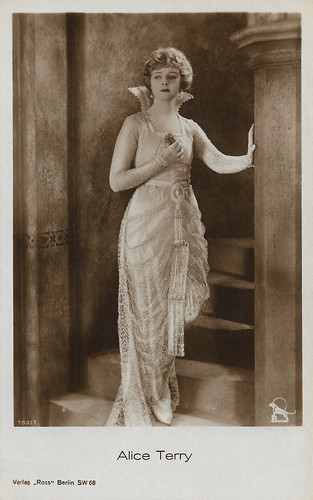
German postcard by Ross Verlag, no. 783/1. Photo: BAFAG (British-American-Films A.G.). Alice Terry as Princess Flavia in The Prisoner of Zenda (Rex Ingram, 1922).
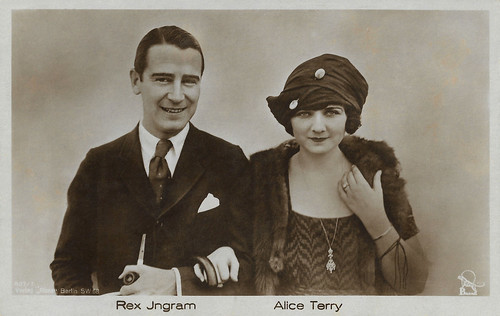
German postcard by Ross Verlag, Berlin, no. 807/1, 1925-1926. Photo: BAFAG (British-American-Films A.G.). Director Rex Ingram and his wife and star Alice Terry .
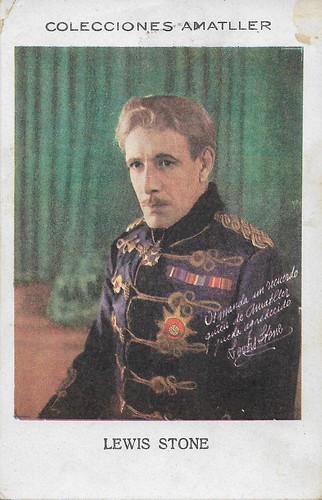
Spanish collectors card by Chocolate Amatller, Series EE, artist 41, no. 83. Lewis Stone In The Prisoner of Zenda (Rex Ingram, 1922).

British postcard on the Picturegoer Series, London, no. D 252. Photo: Metro-Goldwyn-Mayer. Stewart Granger and Deborah Kerr in The Prisoner of Zenda (Richard Thorpe, 1952).
Sources: Richard Gilliam (AllMovie), Wikipedia, and IMDb.

German postcard by Ross Verlag, Berlin, no. 679/2. Photo: BAFAG (British-American-Films A.G.).. Alice Terry as Princess Flavia and Lewis Stone as King Rudolf in The Prisoner of Zenda (Rex Ingram, 1922).

German postcard by Ross Verlag, no. 679/4. Photo: BAFAG (British-American-Films A.G.). Lewis Stone as Rudolph Rassendyll and Alice Terry as Princess Flavia in The Prisoner of Zenda (Rex Ingram, 1922). The Bismarck-like guy behind Terry is the actor Robert Edeson, who plays Colonel Sapt. Behind him is actor Malcolm McGregor, who plays Captain Fritz von Tarlenheim. Both are the loyal aids of the King, defending him against his evil half-brother Michael (Stuart Holmes, who might be the man in black on the right) and his plotting cronies: his mistress Antoinette (Barbara la Marr) and Rupert von Hentzau ( Ramon Novarro ). Trying to stop a coup by Michael, who has abducted and imprisoned the real king, Sapt and Tarlenheim arrange a lookalike cousin of the king to be crowned (which we see on this card). The substitute king falls in love with Princess Flavia but he cannot tell the truth... Stone played both the King and his lookalike.

German postcard by Ross Verlag, no. 697/5. Photo: BAFAG (British-American-Films A.G.). Ramon Novarro and Barbara la Marr in The Prisoner of Zenda (Rex Ingram, 1922).
Trouble and Love in Ruritania
Upon the death of his father the King, Rudolph V (Lewis Stone) is set to assume the throne of Ruritania. Both he and his half-brother, the treacherous Grand Duke 'Black' Michael (Stuart Holmes), love Princess Flavia ( Alice Terry ), their orphaned cousin who lives in a wing of the palace located in the Ruritanian capital of Strelsau.
While half the populace favours the King and the other half the Grand Duke, the entire populace loves Flavia. She is attracted to the Grand Duke's magnetism, but she, in a sense of obligation to her country to support his reign, believes that she will marry the King despite she not being in love with him due to he indulging excessively in his vices, such as the drink, and thus often acting irresponsibly and not in the manner of a king.
The Grand Duke, with his longtime faithful companions De Gautet (Al Jennings), Bersonin (Fairfax Burger), and Rupert of Hentzau ( Ramon Novarro ), plan to detain the King at the Grand Duke's hunting lodge on the grounds of his castle at Zenda on the day of the coronation so that Michael can assume the throne in Strelsau in his place. Englishman Rudolf Rassendyll (also Lewis Stone) decides to pass the time by attending the coronation of his distant relation. He encounters an acquaintance on the train there, Antoinette de Mauban (Barbara La Marr), the mistress of the king's brother, Grand Duke 'Black' Michael.
The day before the coronation, Rassendyll is seen by Colonel Sapt (Robert Edeson) and Captain Fritz von Tarlenheim (Malcolm McGregor). Astounded by the uncanny resemblance between Rassendyll and their liege, they take him to meet Rudolf at a hunting lodge. The king is delighted with his double and invites him to dinner. During the meal, a servant brings in a fine bottle of wine, a present from Michael delivered by his henchman, Rupert of Hentzau. After Rudolf tastes it, he finds it so irresistible that he drinks the entire bottle by himself.
The next morning, Sapt is unable to rouse him; the wine was drugged. Sapt is afraid that if the coronation is postponed, Michael will seize the throne. The country is dangerously divided between the supporters of Rudolf and of Michael. The colonel declares that it is Fate that brought Rassendyll to Ruritania; he can take Rudolf's place with no one the wiser. The Englishman is less certain, but he tosses a coin, which lands in Rudolf's favor, and Rassendyll goes through with the ceremony. Afterwards, he is driven to the palace in the company of the universally adored Princess Flavia.
Later, when Rassendyll returns to the lodge to switch places with the king once more, he and Sapt find only the corpse of Josef (Snitz Edwards), the servant left to guard the king. Rassendyll is forced to continue the masquerade. With Rudolf guarded by a handful of trusted retainers at Zenda Castle, Michael tries unsuccessfully to bribe Rassendyll into leaving. In the days that follow, Rasssendyll becomes acquainted with Flavia, and the two fall in love. Meanwhile, Rupert tries to alienate Antoinette from Michael by telling her that Michael will marry Flavia once Rudolf is out of the way. However, it has an unintended effect; Antionette reveals Michael's plans and Rudolf's location to von Tarlenheim.
A dwarf assassin (John George) in Michael's pay tries to garrot Rassendyll, but Sapt interrupts him before he can finish the job. The would-be killer mistakenly signals to an anxiously waiting Michael that the deed is done, and the duke hastens to Zenda to quietly dispose of the real king. However, Rassendyll was only rendered unconscious. When von Tarlenheim arrives with his news, the three men chase after Michael. Sapt and von Tarlenheim split up to find a way into the castle, but when Antoinette lowers the drawbridge, Rassendyll goes inside alone. Though outnumbered, he manages to kill Michael in a sword fight. Then Sapt and von Tarlenheim come to his aid. When Rupert is cornered by the three men, he chooses death over a waterfall rather than execution for treason.
In the aftermath, Rudolf resumes his rightful position, while Rassendyll hides out at the lodge. By chance, Flavia stops there to speak with Colonel Sapt. Despite Sapt's attempt to shield the princess from heartbreak, a servant girl blurts out that the "king" is staying at the lodge. Rassendyll is forced to tell his beloved the bitter truth. When he tries to persuade her to leave with him, her sense of honour and duty to her country compel her to stay, and Rassendyll departs alone.
The film was received positively by critics. The New York Times called it "well worth seeing" though "needlessly talky", and wrote that "much of the acting is excellent", if occasionally "overdone". "It couldn't miss", wrote Variety of the film's content. "It probably would have been proof against bad direction, but done with perfect stage management and exquisite literary taste it is faultless."
Modern critic Richard Gilliam at AllMovie: "Among the silent era's most handsome motion pictures, this was the third and best filming of Anthony Hope's popular novel within a ten year period. Ramon Novarro , playing the villainous Count Rupert, gets top billing over the dual-role hero Lewis Stone and leading lady Alice Terry . All give strong performances, particularly Terry, who was married at the time to (Rex) Ingram . The film's major flaw is a lack of visual style. Nonetheless, the strength of the story and quality of production more than carry the film. "

German postcard by Ross Verlag, no. 783/1. Photo: BAFAG (British-American-Films A.G.). Alice Terry as Princess Flavia in The Prisoner of Zenda (Rex Ingram, 1922).

German postcard by Ross Verlag, Berlin, no. 807/1, 1925-1926. Photo: BAFAG (British-American-Films A.G.). Director Rex Ingram and his wife and star Alice Terry .

Spanish collectors card by Chocolate Amatller, Series EE, artist 41, no. 83. Lewis Stone In The Prisoner of Zenda (Rex Ingram, 1922).

British postcard on the Picturegoer Series, London, no. D 252. Photo: Metro-Goldwyn-Mayer. Stewart Granger and Deborah Kerr in The Prisoner of Zenda (Richard Thorpe, 1952).
Sources: Richard Gilliam (AllMovie), Wikipedia, and IMDb.
Published on August 31, 2020 22:00
August 30, 2020
Victor Janson
Victor Janson aka Viktor Janson (1884-1960) was a German actor and director. He appeared in many of the early German Ernst Lubitsch comedies. During his long career, Janson played in almost 140 silent and sound films and directed 52 films.
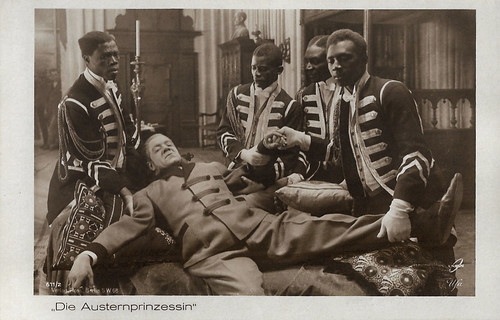
German postcard by Ross Verlag, Berlin, no. 611/2. Photo: Union / Ufa. Victor Janson in Die Austernprinzessin/The Oyster Princess (Ernst Lubitsch, 1919). In his early European films, Lubitsch alternated between escapist comedies and large-scale historical dramas, enjoying great international success with both. A triumph was Die Austernprinzessin, featuring Ossi Oswalda , with Victor Janson as her rich American father. It is a sparkling satire caricaturing American manners.
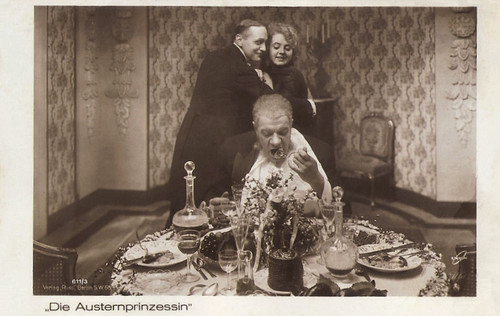
German postcard by Ross Verlag, Berlin, no. 611/3. Photo: Union / Ufa. Victor Janson, Ossi Oswalda and Harry Liedtke in Die Austernprinzessin/The Oyster Princess (Ernst Lubitsch, 1919).
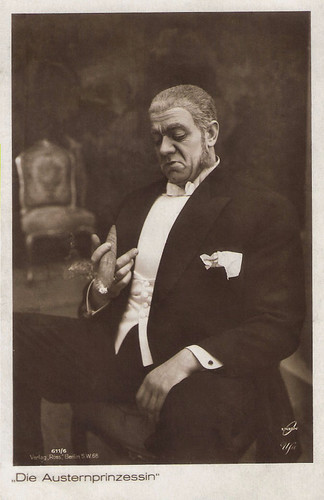
German postcard by Ross Verlag, Berlin, no. 611/6. Photo: Union / Ufa. Victor Janson in Die Austernprinzessin/The Oyster Princess (Ernst Lubitsch, 1919).
Under the direction of Ernst Lubitsch
Victor Janson was born in 1884 in Riga (now Latvia, then Russian Empire).
After acting and singing lessons, Janson went to Berlin at the age of 17, where he received further acting training. He began his first permanent engagement in 1904 at the Court Theater in Detmold. In 1905 he played in Libau, in 1906 in Neisse and in 1908 in Opole, where he also directed for the first time.
In 1909 he moved to the New Operetta Theatre in Berlin. As a funny character actor, he was particularly active in the Central and Residenz Theatre in the following years. As part of an operetta tour, he reached as far as South America.
From 1913 Janson acted in silent films. He subsequently played under the direction of Ernst Lubitsch in a large string of films, often with Ossi Oswalda or Pola Negri . These films were Wenn vier dasselbe tun/When Four Do the Same (1917), Prinz Sami/Prince Sami (1917), Ich möchte kein Mann sein/I Don't Want to Be a Man (1918), Das Mädel vom Ballett/The Ballet Girl (1918), Meine Frau, die Filmschauspielerin/My Wife the Movie Star (1918), Carmen (1918), Die Austernprinzessin/The Oyster Princess (1919), Die Puppe/The Doll (1919), Die Wohnungsnot/The Housing Shortage (1919), and Die Bergkatze/The Mountain Cat (1921).
Janson also acted in films by other well-known German directors, including Nebel und Sonne (Joe May, 1916), Die grosse Wette/The big bet (Harry Piel, 1916), Das Mädel von nebenan/The Girl Nextdoor (Otto Rippert, 1917), Dornröschen/Aurora (Paul Leni, 1917), Die schöne Jolan/The beautiful Jolan (Rudolf Meinert, 1918), Das Teehaus zu den zehn Lotosblumen/The tea house to the ten lotus flowers (Georg Jacoby, 1919), and in many other films.
From 1918 Victor Janson began to work as a director, but he remained an actor too. Janson debuted as a silent film director with Der gelbe Schein/The Yellow Ticket (1918, codirected with Eugen Illés), starring Pola Negri , and with Janson himself in a supporting part.
It is a remarkable philosemitic German drama, partly shot at the Jewish quarter in Warsaw, and initially intended as anti-Russian propaganda. Though the Nazis had tried to destroy all copies of it, a print of the film was found a few years ago in a Dutch private collection, and restored by Kevin Brownlow. Before Der gelbe Schein, Janson had already directed in 1916 the film Das Geheimnis der Mumie/The secret of the mummy, but the film was not released until 1921.
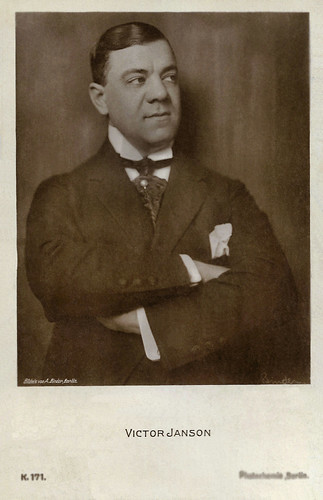
German postcard by Photochemie, no. K.171. Photo: Alex Binder, Berlin.
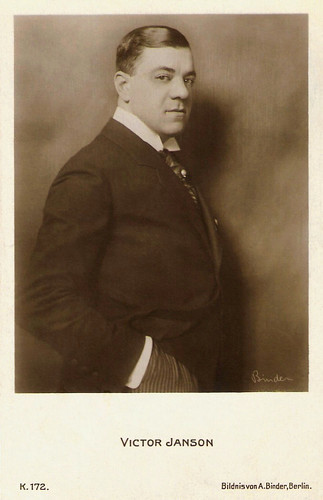
German postcard by Photochemie, no. K.172. Photo: Alex Binder, Berlin.
Directing Ossi Oswalda
In the early 1920s, Janson also directed a series of comedies with Ossi Oswalda , produced by her own film company, such as Amor am Steuer/Cupid at the Wheel (Victor Janson, 1921), Colibri (Victor Janson, 1924), and Niniche (Victor Janson, 1925). Janson also directed dramatic films such as Der Trödler von Amsterdam/The Dealer from Amsterdam (1925) starring Werner Krauss .
He also directed such romantic comedies as the period piece Zopf und Schwert – Eine tolle Prinzessin/Braid and Sword - A Great Princess (Victor Janson, 1926) with Mady Christians , Wien, du Stadt meiner Träume/Die Königin seines Herzens/Vienna, You City of My Dreams (Victor Janson, 1927) with Liane Haid , and Es flüstert die Nacht/It Whispers the Night (Victor Janson, 1929) with Lil Dagover .
In sound cinema, Victor Janson continued to be used as an actor - primarily in comic roles - especially from the late 1930s until the early 1950s, when he stopped working as an actor. All in all, he acted in almost 140 films.
Victor Janson continued to direct until 1939 and would make 52 films in total. His sound productions included films such as Die Frau von der man spricht/The Woman You Talk About (1931), Das Blaue vom Himmel/The Blue Sky (1932), Sie und die Drei/She and the Three (1935), Mädchen in Weiß/Girls in White (1936), and Wer küßt Madeleine/Who Kisses Madeleine (1939).
In the early 1950s, Janson acted as a German voice actor for a few American films, including Disney's Alice in Wonderland. Until well into the 1950s, he was active on the Berlin stages, especially at the Schlossparktheater and Schillertheater.
From 1920, Victor Janson was married to the singer Helene Landt-Merviola, who appeared under the name Helene Merviola. Janson died in Berlin in 1960 and was also buried there.
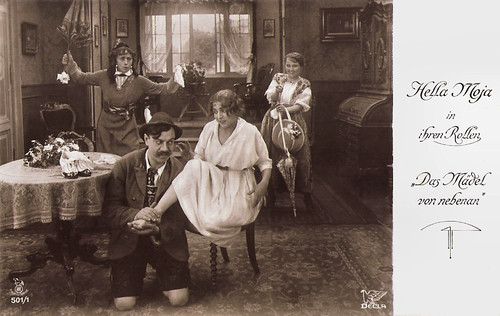
German postcard in the Film Sterne series by Rotophot, no. 501/1. Photo: Decla. Hella Moja in Das Mädel von Nebenan/The Girl Nextdoor (Otto Rippert, 1917). The man holding Hella's foot is Victor Janson.
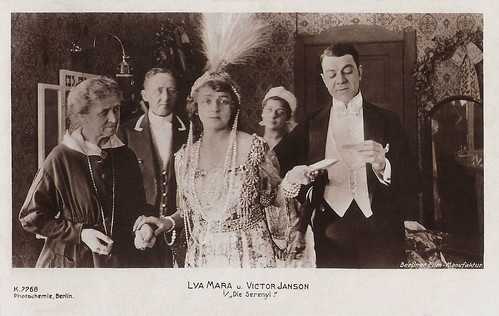
German postcard by Photochemie, Berlin, K. 2268. Photo: Berliner Film-Manufaktur. Lya Mara and Victor Janson in Die Serenyi (Alfred Halm, 1918).
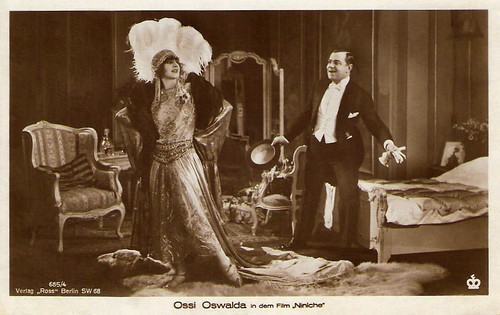
German postcard by Ross Verlag, Berlin, no. 685/4, 1919-1924. Photo: Ossi Oswalda and Victor Janson in Niniche (Victor Janson, 1925).
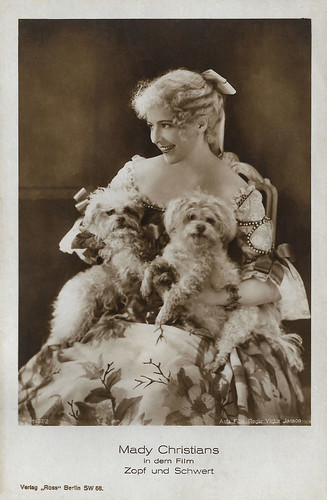
German postcard by Ross Verlag, no. 1467/2. Photo: Aafa Film. Mady Christians in Zopf und Schwert – Eine tolle Prinzessin/Braid and Sword - A Great Princess (Victor Janson, 1926).
Sources: Filmportal.de, Wikipedia (German), and .

German postcard by Ross Verlag, Berlin, no. 611/2. Photo: Union / Ufa. Victor Janson in Die Austernprinzessin/The Oyster Princess (Ernst Lubitsch, 1919). In his early European films, Lubitsch alternated between escapist comedies and large-scale historical dramas, enjoying great international success with both. A triumph was Die Austernprinzessin, featuring Ossi Oswalda , with Victor Janson as her rich American father. It is a sparkling satire caricaturing American manners.

German postcard by Ross Verlag, Berlin, no. 611/3. Photo: Union / Ufa. Victor Janson, Ossi Oswalda and Harry Liedtke in Die Austernprinzessin/The Oyster Princess (Ernst Lubitsch, 1919).

German postcard by Ross Verlag, Berlin, no. 611/6. Photo: Union / Ufa. Victor Janson in Die Austernprinzessin/The Oyster Princess (Ernst Lubitsch, 1919).
Under the direction of Ernst Lubitsch
Victor Janson was born in 1884 in Riga (now Latvia, then Russian Empire).
After acting and singing lessons, Janson went to Berlin at the age of 17, where he received further acting training. He began his first permanent engagement in 1904 at the Court Theater in Detmold. In 1905 he played in Libau, in 1906 in Neisse and in 1908 in Opole, where he also directed for the first time.
In 1909 he moved to the New Operetta Theatre in Berlin. As a funny character actor, he was particularly active in the Central and Residenz Theatre in the following years. As part of an operetta tour, he reached as far as South America.
From 1913 Janson acted in silent films. He subsequently played under the direction of Ernst Lubitsch in a large string of films, often with Ossi Oswalda or Pola Negri . These films were Wenn vier dasselbe tun/When Four Do the Same (1917), Prinz Sami/Prince Sami (1917), Ich möchte kein Mann sein/I Don't Want to Be a Man (1918), Das Mädel vom Ballett/The Ballet Girl (1918), Meine Frau, die Filmschauspielerin/My Wife the Movie Star (1918), Carmen (1918), Die Austernprinzessin/The Oyster Princess (1919), Die Puppe/The Doll (1919), Die Wohnungsnot/The Housing Shortage (1919), and Die Bergkatze/The Mountain Cat (1921).
Janson also acted in films by other well-known German directors, including Nebel und Sonne (Joe May, 1916), Die grosse Wette/The big bet (Harry Piel, 1916), Das Mädel von nebenan/The Girl Nextdoor (Otto Rippert, 1917), Dornröschen/Aurora (Paul Leni, 1917), Die schöne Jolan/The beautiful Jolan (Rudolf Meinert, 1918), Das Teehaus zu den zehn Lotosblumen/The tea house to the ten lotus flowers (Georg Jacoby, 1919), and in many other films.
From 1918 Victor Janson began to work as a director, but he remained an actor too. Janson debuted as a silent film director with Der gelbe Schein/The Yellow Ticket (1918, codirected with Eugen Illés), starring Pola Negri , and with Janson himself in a supporting part.
It is a remarkable philosemitic German drama, partly shot at the Jewish quarter in Warsaw, and initially intended as anti-Russian propaganda. Though the Nazis had tried to destroy all copies of it, a print of the film was found a few years ago in a Dutch private collection, and restored by Kevin Brownlow. Before Der gelbe Schein, Janson had already directed in 1916 the film Das Geheimnis der Mumie/The secret of the mummy, but the film was not released until 1921.

German postcard by Photochemie, no. K.171. Photo: Alex Binder, Berlin.

German postcard by Photochemie, no. K.172. Photo: Alex Binder, Berlin.
Directing Ossi Oswalda
In the early 1920s, Janson also directed a series of comedies with Ossi Oswalda , produced by her own film company, such as Amor am Steuer/Cupid at the Wheel (Victor Janson, 1921), Colibri (Victor Janson, 1924), and Niniche (Victor Janson, 1925). Janson also directed dramatic films such as Der Trödler von Amsterdam/The Dealer from Amsterdam (1925) starring Werner Krauss .
He also directed such romantic comedies as the period piece Zopf und Schwert – Eine tolle Prinzessin/Braid and Sword - A Great Princess (Victor Janson, 1926) with Mady Christians , Wien, du Stadt meiner Träume/Die Königin seines Herzens/Vienna, You City of My Dreams (Victor Janson, 1927) with Liane Haid , and Es flüstert die Nacht/It Whispers the Night (Victor Janson, 1929) with Lil Dagover .
In sound cinema, Victor Janson continued to be used as an actor - primarily in comic roles - especially from the late 1930s until the early 1950s, when he stopped working as an actor. All in all, he acted in almost 140 films.
Victor Janson continued to direct until 1939 and would make 52 films in total. His sound productions included films such as Die Frau von der man spricht/The Woman You Talk About (1931), Das Blaue vom Himmel/The Blue Sky (1932), Sie und die Drei/She and the Three (1935), Mädchen in Weiß/Girls in White (1936), and Wer küßt Madeleine/Who Kisses Madeleine (1939).
In the early 1950s, Janson acted as a German voice actor for a few American films, including Disney's Alice in Wonderland. Until well into the 1950s, he was active on the Berlin stages, especially at the Schlossparktheater and Schillertheater.
From 1920, Victor Janson was married to the singer Helene Landt-Merviola, who appeared under the name Helene Merviola. Janson died in Berlin in 1960 and was also buried there.

German postcard in the Film Sterne series by Rotophot, no. 501/1. Photo: Decla. Hella Moja in Das Mädel von Nebenan/The Girl Nextdoor (Otto Rippert, 1917). The man holding Hella's foot is Victor Janson.

German postcard by Photochemie, Berlin, K. 2268. Photo: Berliner Film-Manufaktur. Lya Mara and Victor Janson in Die Serenyi (Alfred Halm, 1918).

German postcard by Ross Verlag, Berlin, no. 685/4, 1919-1924. Photo: Ossi Oswalda and Victor Janson in Niniche (Victor Janson, 1925).

German postcard by Ross Verlag, no. 1467/2. Photo: Aafa Film. Mady Christians in Zopf und Schwert – Eine tolle Prinzessin/Braid and Sword - A Great Princess (Victor Janson, 1926).
Sources: Filmportal.de, Wikipedia (German), and .
Published on August 30, 2020 22:00
August 29, 2020
Lupe Velez
Happy birthday, Ivo!
Lupe Velez (1908-1944), was one of the first Mexican actresses to succeed in Hollywood. Her nicknames were 'The Mexican Spitfire' and 'Hot Pepper'. She was the leading lady in such silent films as The Gaucho (1927), Lady of the Pavements (1928), and Wolf Song (1929). During the 1930s, her well-known explosive screen persona was exploited in a series of successful films like Hot Pepper (1933), Strictly Dynamite (1934), and Hollywood Party (1934). In the 1940s, Vélez's popularity peaked after appearing in the Mexican Spitfire films, a series created to capitalise on Vélez's well-documented fiery personality. She had several highly publicised romances and a stormy marriage. In 1944, Vélez died of an intentional overdose of the barbiturate drug Seconal. Her death and the circumstances surrounding it have been the subject of speculation and controversy.
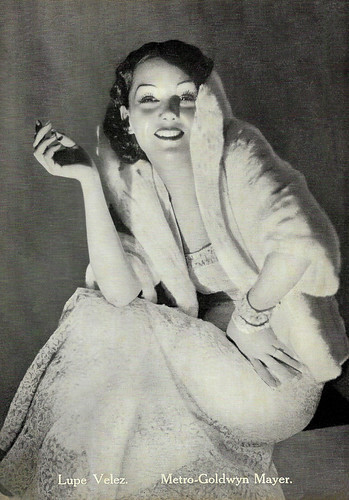
Dutch postcard by Smeets & Schippers, Amsterdam. Photo: George Hurrell / MGM (Metro-Goldwyn-Mayer).
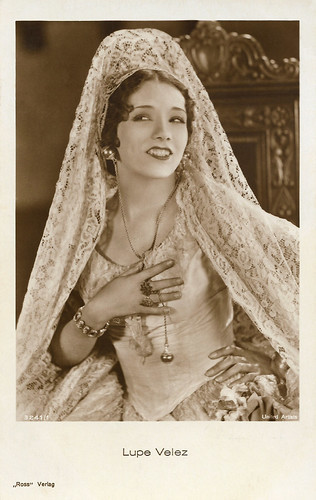
German postcard by Ross Verlag, no. 3241/1, 1928-1929. Photo: United Artists. Lupe Velez in The Wolf Song (Victor Fleming, 1929).
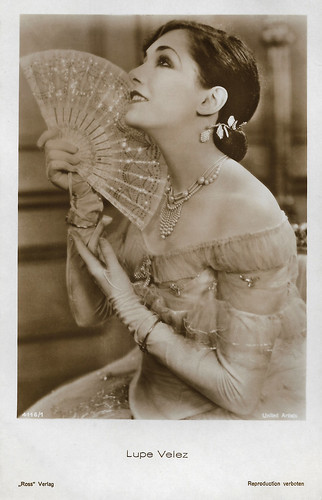
German postcard by Ross Verlag, no. 4116/1, 1929-1930. Photo: United Artists. Lupe Velez in Lady of the Pavements (D.W. Griffith, 1929).
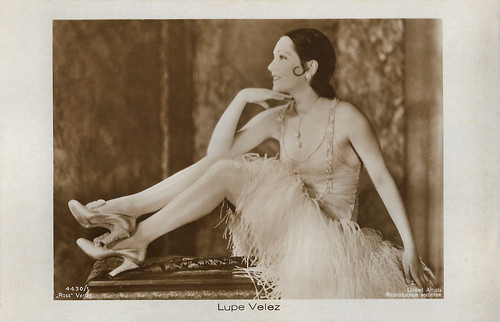
German postcard by Ross Verlag, no. 44301/1, 1929-1930. Photo: United Artists.
Suggestive singing and provocative dancing
Lupe Vélez was born María Guadalupe Villalobos Vélez in 1908 in the city of San Luis Potosí in Mexico. She was the daughter of Jacobo Villalobos Reyes, a colonel in the army of the dictator Porfirio Diaz, and his wife Josefina Vélez, an opera singer according to some sources, or vaudeville singer according to others. She had three sisters: Mercedes, Reina and Josefina, and a brother, Emigdio.
The family was financially comfortable and lived in a large home. At the age of 13, her parents sent her to study at Our Lady of the Lake (now Our Lady of the Lake University) in San Antonio, Texas. It was at Our Lady of the Lake that Vélez learned to speak English and began to dance. She later admitted that she liked dance class, but was otherwise a poor student.
Denny Jackson at IMDb : "Life was hard for her family, and Lupe returned to Mexico to help them out financially. She worked as a salesgirl for a department store for the princely sum of $4 a week. Every week she would turn most of her salary over to her mother, but kept a little for herself so she could take dancing lessons. By now, she figured, with her mature shape and grand personality, she thought she could make a try at show business."
She began her career as a performer in Mexican vaudeville in 1924. She initially performed under her paternal surname, but after her father returned home from the war, he was outraged that his daughter had decided to become a stage performer. She chose her maternal surname, 'Vélez', as her stage name and her mother introduced Vélez and her sister Josefina to the popular Spanish Mexican vedette María Conesa, 'La Gatita Blanca'.
Vélez debuted in a show led by Conesa, where she sang 'Oh Charley, My Boy' and danced the shimmy. Aurelio Campos, a young pianist, and friend of the Vélez sisters recommended Lupe to stage producers, Carlos Ortega and Manuel Castro. Ortega and Castro were preparing a season revue at the Regis Theatre and hired Vélez to join the company in March 1925.
Later that year, Vélez starred in the revues 'Mexican Rataplan' and '¡No lo tapes!', both parodies of the Bataclan's shows in Paris. Her suggestive singing and provocative dancing was a hit with audiences, and she soon established herself as one of the main stars of vaudeville in Mexico. After a year and a half, Vélez left the revue after the manager refused to give her a raise.
She then joined the Teatro Principal but was fired after three months due to her "feisty attitude". Vélez was quickly hired by the Teatro Lirico, where her salary rose to 100 pesos a day. In 1926, Frank A. Woodyard, an American who had seen Vélez perform, recommended her to stage director Richard Bennett, the father of actresses Joan and Constance Bennett.
Bennett was looking for an actress to portray a Mexican cantina singer in his upcoming play 'The Dove'. He sent Vélez a telegram inviting her to Los Angeles to appear in the play. Vélez had been planning to go to Cuba to perform, but quickly changed her plans and traveled to Los Angeles. However, upon arrival, she discovered that she had been replaced by another actress.
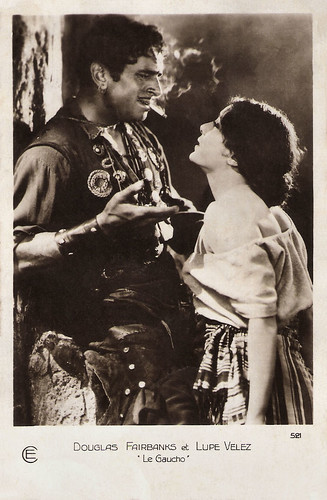
French postcard by Cinémagazine-Edition, Paris, no. 521. Douglas Fairbanks and Lupe Velez in The Gaucho (F. Richard Jones, 1927). Sent by mail in 1930.
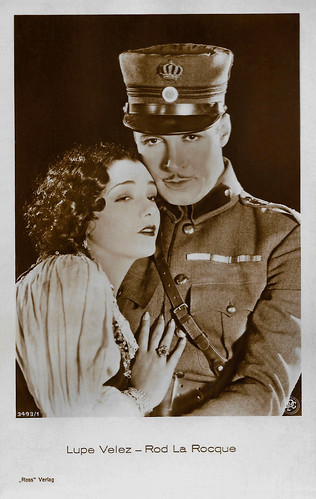
German postcard by Ross Verlag, no. 3493/1, 1928-1929. Photo: P.D.C. Lupe Velez and Rod La Rocque in Stand and Deliver (Donald Crisp, 1928).
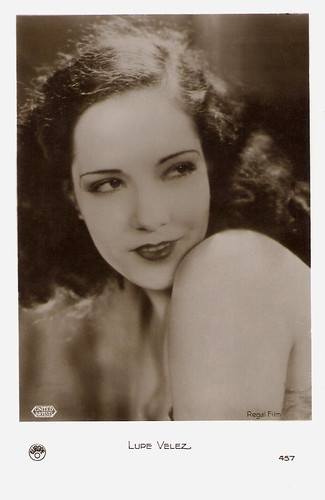
French postcard by Europe, no. 457. Photo: United Artists / Regal Film.
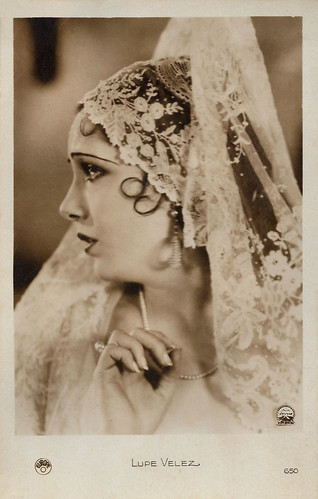
French postcard by Europe, no. 650. Photo: Paramount. Lupe Velez in The Wolf Song (Victor Fleming, 1929).
Whoopee Lupe
While in Los Angeles, Lupe Vélez met the comedian Fanny Brice. Brice recommended her to Florenz Ziegfeld Jr., who hired her to perform in New York City. While Vélez was preparing to leave Los Angeles, she received a call from MGM producer Harry Rapf, who offered her a screen test. Producer and director Hal Roach saw Vélez's screen test and hired her for a small role in the comic Laurel and Hardy short Sailors, Beware! (Fred Guiol, Hal Yates, 1927).
After her debut, Vélez appeared in another Hal Roach short, What Women Did for Me (James Parrott, 1927), opposite Charley Chase. Later that year, she did a screen test for the upcoming Douglas Fairbanks feature The Gaucho (F. Richard Jones, 1927). Fairbanks was impressed by Vélez and hired her to appear in the film with him.
The Gaucho (F. Richard Jones, 1927) was a hit and critics were duly impressed with Vélez's ability to hold her own alongside Fairbanks, who was well known for his spirited acting and impressive stunts. Her second major film was Stand and Deliver (Donald Crisp, 1928), produced by Cecil B. DeMille. That same year, she was named one of the WAMPAS Baby Stars.
Then she appeared in Lady of the Pavements (1929), directed by D. W. Griffith, and Where East Is East (Tod Browning, 1929), starring Lon Chaney as an animal trapper in Laos. In the Western The Wolf Song (Victor Fleming, 1929), she appeared alongside Gary Cooper . As she was regularly cast as 'exotic' or 'ethnic' women that were volatile and hot-tempered, gossip columnists took to referring to Vélez as "Mexican Hurricane", "The Mexican Wildcat", "The Mexican Madcap", "Whoopee Lupe" and "The Hot Tamale".
Lupe Vélez made the transition to sound films without difficulty. Studio executives had predicted that her accent would likely hamper her ability to make the transition. That idea was dispelled after she appeared in the all-talking Rin Tin Tin vehicle, Tiger Rose (George Fitzmaurice, 1929). The film was a hit and Vélez's sound career was established.
Vélez appeared in a series of Pre-Code films like Hell Harbor (Henry King, 1930), The Storm (William Wyler, 1930), and the crime drama East Is West (Monta Bell, 1930) opposite Edward G. Robinson . The next year, she appeared in her second film for Cecil B. DeMille, Squaw Man (Cecil B. DeMille, 1931), opposite Warner Baxter, in Resurrection (Edwin Carewe, 1931), and The Cuban Love Song (W.S. Van Dyke, 1931), with the popular singer Lawrence Tibbett.
She had a supporting role in Kongo (William J. Cowen, 1932) with Walter Huston, a sound remake of West of Zanzibar (Tod Browning, 1928) which tries to outdo the Lon Chaney original in morbidity. She also starred in Spanish-language versions of Universal films like Resurrección (Eduardo Arozamena, David Selman, 1931), the Spanish version of Resurrection (1931), and Hombres en mi vida (Eduardo Arozamena, David Selman, 1932), the Spanish version of Men in Her Life (William Beaudine, 1931) in which Lois Moran had starred.
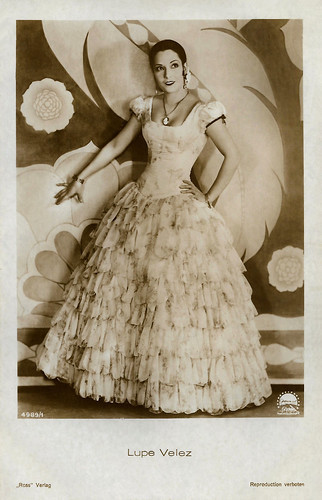
German postcard by Ross Verlag, no. 4989/1, 1929-1930. Photo: Paramount. Lupe Velez in The Wolf Song (Victor Fleming, 1929). Sent by mail in The Netherlands in 1932.
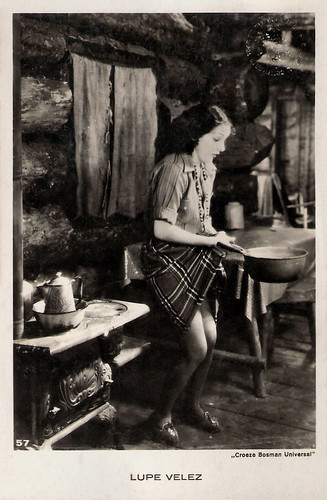
Dutch postcard by Croeze Bosman Universal, no. 57. Lupe Velez in The Storm (William Wyler, 1930).
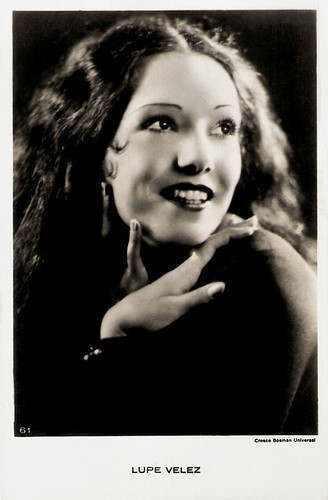
Dutch postcard by Croeze Bosman Universal, no. 61.
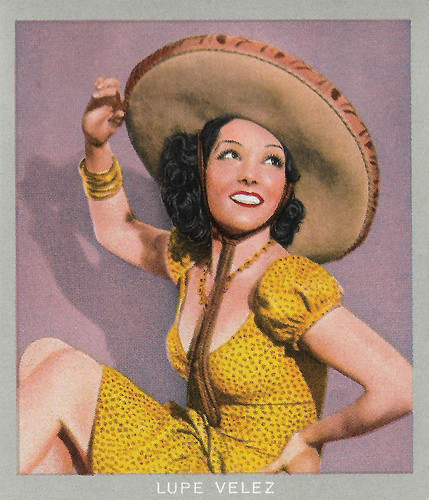
German cigarette card by Ross Verlag in the 'Künstler im Film' series for Zigarettenfabrik Monopol, Dresden, Serie 1, image 152 (of 200). Photo: Paramount. Lupe Velez in The Broken Wing (Lloyd Corrigan, 1932).
Hot Pepper
In 1932, Lupe Vélez took a break from her film career and traveled to New York City where she was finally signed by Broadway impresario Florenz Ziegfeld, Jr. to take over the role of 'Conchita' in the musical revue 'Hot-Cha!'. The show also starred Bert Lahr, Eleanor Powell, and Buddy Rogers.
Back in Hollywood, Lupe switched to comedy after playing dramatic roles for five years. Denny Jackson at IMDb : "In 1933 she played the lead role of Pepper in Hot Pepper (1933). This film showcased her comedic talents and helped her to show the world her vital personality. She was delightful."
After Hot Pepper (John G. Blystone, 1933) with Edmund Lowe and Victor McLaglen , Lupe played beautiful but volatile, characters in a series of successful films like Strictly Dynamite (Elliott Nugent, 1934), Palooka (Benjamin Stoloff, 1934) both opposite Jimmy Durante, and Hollywood Party (Allan Dwan, a.o., 1934) with Laurel and Hardy .
Although Vélez was a popular actress, RKO Pictures did not renew her contract in 1934. Over the next few years, Vélez worked for various studios as a freelance actress; she also spent two years in England where she filmed The Morals of Marcus (Miles Mander, 1935) and Gypsy Melody (Edmond T. Gréville, 1936). She returned to Los Angeles the following year where she appeared in the final part of the Wheeler & Woolsey comedy High Flyers (Edward F. Cline, 1937).
In 1938, Vélez made her final appearance on Broadway in the musical 'You Never Know', by Cole Porter. The show received poor reviews from critics but received a large amount of publicity due to the feud between Vélez and fellow cast member Libby Holman. Holman was irritated by the attention Vélez garnered from the show with her impersonations of several actresses including Gloria Swanson , Katharine Hepburn , and Shirley Temple . The feud came to a head during a performance in New Haven, Connecticut after Vélez punched Holman in between curtain calls and gave her a black eye. The feud effectively ended the show.
Upon her return to Mexico City in 1938 to star in her first Mexican film, Vélez was greeted by ten thousand fans. The film La Zandunga (Fernando de Fuentes, 1938) co-starring Arturo de Córdova, was a critical and financial success. Vélez was slated to appear in four more Mexican films, but instead, she returned to Los Angeles and went back to work for RKO Pictures.
In 1939, Lupe Vélez was cast opposite Leon Errol and Donald Woods in the B-comedy, The Girl from Mexico (Leslie Goodwins, 1939). Despite being a B film, it was a hit with audiences and RKO re-teamed her with Errol and Wood for a sequel, Mexican Spitfire (Leslie Goodwins, 1940). That film was also a success and led to a series of eight Spitfire films.
Wikipedia : "In the series, Vélez portrays Carmelita Lindsay, a temperamental yet friendly Mexican singer married to Dennis 'Denny' Lindsay (Woods), an elegant American gentleman. The Spitfire films rejuvenated Vélez's career. Moreover, they were films in which a Latina headlined for eight films straight – a true rarity."
In addition to the Spitfire series, she was cast in such films as Six Lessons from Madame La Zonga (John Rawlins, 1941), Playmates (David Butler, 1941) opposite John Barrymore, and Redhead from Manhattan (Lew Landers, 1943). In 1943, the final film in the Spitfire series, Mexican Spitfire's Blessed Event (Leslie Goodwins, 1943), was released. By that time, the novelty of the series had begun to wane.
Velez co-starred with Eddie Albert in the romantic comedy, Ladies' Day (Leslie Goodwins, 1943), about an actress and a baseball player. In 1944, Vélez returned to Mexico to star in an adaptation of Émile Zola's novel Nana (Roberto Gavaldón, Celestino Gorostiza, 1944), which was well-received. It would be her final film. After filming wrapped, Vélez returned to Los Angeles and began preparing for another stage role in New York.
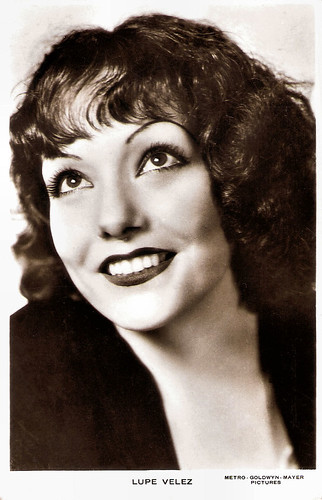
British Real Photograph postcard. Photo: Metro-Goldwyn-Mayer.
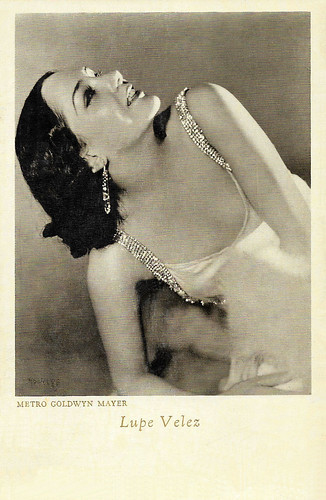
Italian postcard by Cinema-Illustrazione, Milano, Serie 1, no. 36. Photo: Metro-Goldwyn-Mayer.
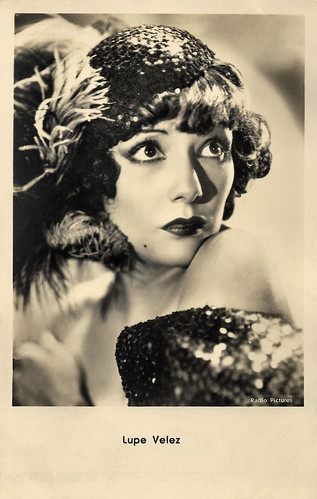
Austrian postcard by Iris Verlag, no. 6744. Photo: Radio Pictures.
Scratches, bruises, and love-bites
Lupe Vélez's temper and jealousy in her often tempestuous romantic relationships were well documented and became tabloid fodder, often overshadowing her career. Vélez was straightforward with the press and was regularly contacted by gossip columnists for stories about her romantic exploits.
Her first long-term relationship was with actor Gary Cooper . Vélez met Cooper while filming The Wolf Song in 1929 and began a two-year affair with him. The relationship was passionate but often stormy. Reportedly Vélez chased Cooper around with a knife during an argument and cut him severely enough to require stitches. By that time, the rocky relationship had taken its toll on Cooper who had lost 45 pounds and was suffering from nervous exhaustion. Paramount Pictures ordered him to take a vacation to recuperate. While he was boarding the train, Vélez showed up at the train station and fired a pistol at him.
During her marriage to actor Johnny Weissmuller , stories of their frequent physical fights were regularly reported in the press. Vélez reportedly inflicted scratches, bruises, and love-bites on Weissmuller during their fights and "passionate love-making". In July 1934, after ten months of marriage, Vélez filed for divorce citing cruelty. She withdrew the petition a week later after reconciling with Weissmuller. In January 1935, she filed for divorce a second time and was granted an interlocutory decree that was dismissed when the couple reconciled a month later. In August 1938, Vélez filed for divorce for a third time, again charging Weissmuller with cruelty. Their divorce was finalised in August 1939.
After the divorce became final, Vélez began dating actor Guinn "Big Boy" Williams in late 1940. They were reportedly engaged but never married. Vélez was also linked to author Erich Maria Remarque and the boxers Jack Johnson and Jack Dempsey.
In 1943, Vélez began an affair with her La Zandunga co-star Arturo de Córdova. De Córdova had recently moved to Hollywood after signing with Paramount Pictures. Despite the fact that de Córdova was married to Mexican actress Enna Arana with whom he had four children, Vélez granted an interview to gossip columnist Louella Parsons in September 1943 and announced that the two were engaged. Vélez ended the engagement in early 1944, reportedly after de Córdova's wife refused to give him a divorce.
Vélez then met and began dating a struggling young Austrian actor named Harald Maresch who went by the stage name Harald Ramond. In September 1944, she discovered she was pregnant with Ramond's child. She announced their engagement in late November 1944. On 10 December, four days before her death, Vélez announced she had ended the engagement and kicked Ramond out of her home.
On the evening of 13 December 1944, Vélez dined with her two friends, the silent film star Estelle Taylor and Venita Oakie. In the early morning hours of 14 December, Vélez retired to her bedroom, where she consumed 75 Seconal pills and a glass of brandy. Her secretary, Beulah Kinder, found the actress's body on her bed later that morning. A suicide note addressed to Harald Ramond was found nearby. Lupe Vélez was only 36 years old.
More than four-thousand people filed past her casket during her funeral. Her body was interred in Mexico City, at Panteón Civil de Dolores Cemetery. Velez' estate, valued at $125,000 and consisting mostly of her Rodeo House home, two cars, jewelry, and personal effects were left to her secretary Beulah Kinder with the remainder in trust for her mother, Mrs. Josephine Velez. Together with Dolores del Rio , Ramon Novarro , and José Mojica, she was one of the few Mexican people who had made history in the early years of Hollywood.

French postcard by Europe, no. 470. Photo: Regal Film / United Artists.
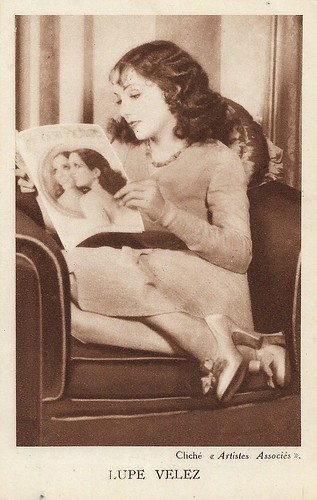
Belgian postcard by S.A. Cacao et Chocolat Kivou, Vilvoorde / N.V. Cacao en Chocolade Kivou, Vilvoorde. PhotoL Artistes Associés (United Artists).
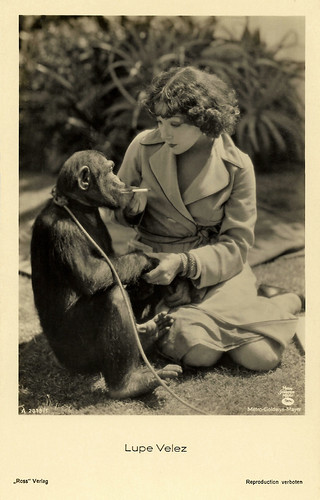
German postcard by Ross Verlag, no. A 2013/1, 1939-1940. Photo: Metro-Goldwyn-Mayer.
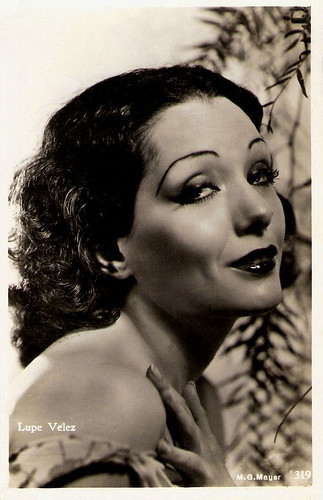
Dutch postcard by JosPe, Arnhem, no. 319. Photo: MGM.
Sources: (IMDb), Wikipedia, and .
Lupe Velez (1908-1944), was one of the first Mexican actresses to succeed in Hollywood. Her nicknames were 'The Mexican Spitfire' and 'Hot Pepper'. She was the leading lady in such silent films as The Gaucho (1927), Lady of the Pavements (1928), and Wolf Song (1929). During the 1930s, her well-known explosive screen persona was exploited in a series of successful films like Hot Pepper (1933), Strictly Dynamite (1934), and Hollywood Party (1934). In the 1940s, Vélez's popularity peaked after appearing in the Mexican Spitfire films, a series created to capitalise on Vélez's well-documented fiery personality. She had several highly publicised romances and a stormy marriage. In 1944, Vélez died of an intentional overdose of the barbiturate drug Seconal. Her death and the circumstances surrounding it have been the subject of speculation and controversy.

Dutch postcard by Smeets & Schippers, Amsterdam. Photo: George Hurrell / MGM (Metro-Goldwyn-Mayer).

German postcard by Ross Verlag, no. 3241/1, 1928-1929. Photo: United Artists. Lupe Velez in The Wolf Song (Victor Fleming, 1929).

German postcard by Ross Verlag, no. 4116/1, 1929-1930. Photo: United Artists. Lupe Velez in Lady of the Pavements (D.W. Griffith, 1929).

German postcard by Ross Verlag, no. 44301/1, 1929-1930. Photo: United Artists.
Suggestive singing and provocative dancing
Lupe Vélez was born María Guadalupe Villalobos Vélez in 1908 in the city of San Luis Potosí in Mexico. She was the daughter of Jacobo Villalobos Reyes, a colonel in the army of the dictator Porfirio Diaz, and his wife Josefina Vélez, an opera singer according to some sources, or vaudeville singer according to others. She had three sisters: Mercedes, Reina and Josefina, and a brother, Emigdio.
The family was financially comfortable and lived in a large home. At the age of 13, her parents sent her to study at Our Lady of the Lake (now Our Lady of the Lake University) in San Antonio, Texas. It was at Our Lady of the Lake that Vélez learned to speak English and began to dance. She later admitted that she liked dance class, but was otherwise a poor student.
Denny Jackson at IMDb : "Life was hard for her family, and Lupe returned to Mexico to help them out financially. She worked as a salesgirl for a department store for the princely sum of $4 a week. Every week she would turn most of her salary over to her mother, but kept a little for herself so she could take dancing lessons. By now, she figured, with her mature shape and grand personality, she thought she could make a try at show business."
She began her career as a performer in Mexican vaudeville in 1924. She initially performed under her paternal surname, but after her father returned home from the war, he was outraged that his daughter had decided to become a stage performer. She chose her maternal surname, 'Vélez', as her stage name and her mother introduced Vélez and her sister Josefina to the popular Spanish Mexican vedette María Conesa, 'La Gatita Blanca'.
Vélez debuted in a show led by Conesa, where she sang 'Oh Charley, My Boy' and danced the shimmy. Aurelio Campos, a young pianist, and friend of the Vélez sisters recommended Lupe to stage producers, Carlos Ortega and Manuel Castro. Ortega and Castro were preparing a season revue at the Regis Theatre and hired Vélez to join the company in March 1925.
Later that year, Vélez starred in the revues 'Mexican Rataplan' and '¡No lo tapes!', both parodies of the Bataclan's shows in Paris. Her suggestive singing and provocative dancing was a hit with audiences, and she soon established herself as one of the main stars of vaudeville in Mexico. After a year and a half, Vélez left the revue after the manager refused to give her a raise.
She then joined the Teatro Principal but was fired after three months due to her "feisty attitude". Vélez was quickly hired by the Teatro Lirico, where her salary rose to 100 pesos a day. In 1926, Frank A. Woodyard, an American who had seen Vélez perform, recommended her to stage director Richard Bennett, the father of actresses Joan and Constance Bennett.
Bennett was looking for an actress to portray a Mexican cantina singer in his upcoming play 'The Dove'. He sent Vélez a telegram inviting her to Los Angeles to appear in the play. Vélez had been planning to go to Cuba to perform, but quickly changed her plans and traveled to Los Angeles. However, upon arrival, she discovered that she had been replaced by another actress.

French postcard by Cinémagazine-Edition, Paris, no. 521. Douglas Fairbanks and Lupe Velez in The Gaucho (F. Richard Jones, 1927). Sent by mail in 1930.

German postcard by Ross Verlag, no. 3493/1, 1928-1929. Photo: P.D.C. Lupe Velez and Rod La Rocque in Stand and Deliver (Donald Crisp, 1928).

French postcard by Europe, no. 457. Photo: United Artists / Regal Film.

French postcard by Europe, no. 650. Photo: Paramount. Lupe Velez in The Wolf Song (Victor Fleming, 1929).
Whoopee Lupe
While in Los Angeles, Lupe Vélez met the comedian Fanny Brice. Brice recommended her to Florenz Ziegfeld Jr., who hired her to perform in New York City. While Vélez was preparing to leave Los Angeles, she received a call from MGM producer Harry Rapf, who offered her a screen test. Producer and director Hal Roach saw Vélez's screen test and hired her for a small role in the comic Laurel and Hardy short Sailors, Beware! (Fred Guiol, Hal Yates, 1927).
After her debut, Vélez appeared in another Hal Roach short, What Women Did for Me (James Parrott, 1927), opposite Charley Chase. Later that year, she did a screen test for the upcoming Douglas Fairbanks feature The Gaucho (F. Richard Jones, 1927). Fairbanks was impressed by Vélez and hired her to appear in the film with him.
The Gaucho (F. Richard Jones, 1927) was a hit and critics were duly impressed with Vélez's ability to hold her own alongside Fairbanks, who was well known for his spirited acting and impressive stunts. Her second major film was Stand and Deliver (Donald Crisp, 1928), produced by Cecil B. DeMille. That same year, she was named one of the WAMPAS Baby Stars.
Then she appeared in Lady of the Pavements (1929), directed by D. W. Griffith, and Where East Is East (Tod Browning, 1929), starring Lon Chaney as an animal trapper in Laos. In the Western The Wolf Song (Victor Fleming, 1929), she appeared alongside Gary Cooper . As she was regularly cast as 'exotic' or 'ethnic' women that were volatile and hot-tempered, gossip columnists took to referring to Vélez as "Mexican Hurricane", "The Mexican Wildcat", "The Mexican Madcap", "Whoopee Lupe" and "The Hot Tamale".
Lupe Vélez made the transition to sound films without difficulty. Studio executives had predicted that her accent would likely hamper her ability to make the transition. That idea was dispelled after she appeared in the all-talking Rin Tin Tin vehicle, Tiger Rose (George Fitzmaurice, 1929). The film was a hit and Vélez's sound career was established.
Vélez appeared in a series of Pre-Code films like Hell Harbor (Henry King, 1930), The Storm (William Wyler, 1930), and the crime drama East Is West (Monta Bell, 1930) opposite Edward G. Robinson . The next year, she appeared in her second film for Cecil B. DeMille, Squaw Man (Cecil B. DeMille, 1931), opposite Warner Baxter, in Resurrection (Edwin Carewe, 1931), and The Cuban Love Song (W.S. Van Dyke, 1931), with the popular singer Lawrence Tibbett.
She had a supporting role in Kongo (William J. Cowen, 1932) with Walter Huston, a sound remake of West of Zanzibar (Tod Browning, 1928) which tries to outdo the Lon Chaney original in morbidity. She also starred in Spanish-language versions of Universal films like Resurrección (Eduardo Arozamena, David Selman, 1931), the Spanish version of Resurrection (1931), and Hombres en mi vida (Eduardo Arozamena, David Selman, 1932), the Spanish version of Men in Her Life (William Beaudine, 1931) in which Lois Moran had starred.

German postcard by Ross Verlag, no. 4989/1, 1929-1930. Photo: Paramount. Lupe Velez in The Wolf Song (Victor Fleming, 1929). Sent by mail in The Netherlands in 1932.

Dutch postcard by Croeze Bosman Universal, no. 57. Lupe Velez in The Storm (William Wyler, 1930).

Dutch postcard by Croeze Bosman Universal, no. 61.

German cigarette card by Ross Verlag in the 'Künstler im Film' series for Zigarettenfabrik Monopol, Dresden, Serie 1, image 152 (of 200). Photo: Paramount. Lupe Velez in The Broken Wing (Lloyd Corrigan, 1932).
Hot Pepper
In 1932, Lupe Vélez took a break from her film career and traveled to New York City where she was finally signed by Broadway impresario Florenz Ziegfeld, Jr. to take over the role of 'Conchita' in the musical revue 'Hot-Cha!'. The show also starred Bert Lahr, Eleanor Powell, and Buddy Rogers.
Back in Hollywood, Lupe switched to comedy after playing dramatic roles for five years. Denny Jackson at IMDb : "In 1933 she played the lead role of Pepper in Hot Pepper (1933). This film showcased her comedic talents and helped her to show the world her vital personality. She was delightful."
After Hot Pepper (John G. Blystone, 1933) with Edmund Lowe and Victor McLaglen , Lupe played beautiful but volatile, characters in a series of successful films like Strictly Dynamite (Elliott Nugent, 1934), Palooka (Benjamin Stoloff, 1934) both opposite Jimmy Durante, and Hollywood Party (Allan Dwan, a.o., 1934) with Laurel and Hardy .
Although Vélez was a popular actress, RKO Pictures did not renew her contract in 1934. Over the next few years, Vélez worked for various studios as a freelance actress; she also spent two years in England where she filmed The Morals of Marcus (Miles Mander, 1935) and Gypsy Melody (Edmond T. Gréville, 1936). She returned to Los Angeles the following year where she appeared in the final part of the Wheeler & Woolsey comedy High Flyers (Edward F. Cline, 1937).
In 1938, Vélez made her final appearance on Broadway in the musical 'You Never Know', by Cole Porter. The show received poor reviews from critics but received a large amount of publicity due to the feud between Vélez and fellow cast member Libby Holman. Holman was irritated by the attention Vélez garnered from the show with her impersonations of several actresses including Gloria Swanson , Katharine Hepburn , and Shirley Temple . The feud came to a head during a performance in New Haven, Connecticut after Vélez punched Holman in between curtain calls and gave her a black eye. The feud effectively ended the show.
Upon her return to Mexico City in 1938 to star in her first Mexican film, Vélez was greeted by ten thousand fans. The film La Zandunga (Fernando de Fuentes, 1938) co-starring Arturo de Córdova, was a critical and financial success. Vélez was slated to appear in four more Mexican films, but instead, she returned to Los Angeles and went back to work for RKO Pictures.
In 1939, Lupe Vélez was cast opposite Leon Errol and Donald Woods in the B-comedy, The Girl from Mexico (Leslie Goodwins, 1939). Despite being a B film, it was a hit with audiences and RKO re-teamed her with Errol and Wood for a sequel, Mexican Spitfire (Leslie Goodwins, 1940). That film was also a success and led to a series of eight Spitfire films.
Wikipedia : "In the series, Vélez portrays Carmelita Lindsay, a temperamental yet friendly Mexican singer married to Dennis 'Denny' Lindsay (Woods), an elegant American gentleman. The Spitfire films rejuvenated Vélez's career. Moreover, they were films in which a Latina headlined for eight films straight – a true rarity."
In addition to the Spitfire series, she was cast in such films as Six Lessons from Madame La Zonga (John Rawlins, 1941), Playmates (David Butler, 1941) opposite John Barrymore, and Redhead from Manhattan (Lew Landers, 1943). In 1943, the final film in the Spitfire series, Mexican Spitfire's Blessed Event (Leslie Goodwins, 1943), was released. By that time, the novelty of the series had begun to wane.
Velez co-starred with Eddie Albert in the romantic comedy, Ladies' Day (Leslie Goodwins, 1943), about an actress and a baseball player. In 1944, Vélez returned to Mexico to star in an adaptation of Émile Zola's novel Nana (Roberto Gavaldón, Celestino Gorostiza, 1944), which was well-received. It would be her final film. After filming wrapped, Vélez returned to Los Angeles and began preparing for another stage role in New York.

British Real Photograph postcard. Photo: Metro-Goldwyn-Mayer.

Italian postcard by Cinema-Illustrazione, Milano, Serie 1, no. 36. Photo: Metro-Goldwyn-Mayer.

Austrian postcard by Iris Verlag, no. 6744. Photo: Radio Pictures.
Scratches, bruises, and love-bites
Lupe Vélez's temper and jealousy in her often tempestuous romantic relationships were well documented and became tabloid fodder, often overshadowing her career. Vélez was straightforward with the press and was regularly contacted by gossip columnists for stories about her romantic exploits.
Her first long-term relationship was with actor Gary Cooper . Vélez met Cooper while filming The Wolf Song in 1929 and began a two-year affair with him. The relationship was passionate but often stormy. Reportedly Vélez chased Cooper around with a knife during an argument and cut him severely enough to require stitches. By that time, the rocky relationship had taken its toll on Cooper who had lost 45 pounds and was suffering from nervous exhaustion. Paramount Pictures ordered him to take a vacation to recuperate. While he was boarding the train, Vélez showed up at the train station and fired a pistol at him.
During her marriage to actor Johnny Weissmuller , stories of their frequent physical fights were regularly reported in the press. Vélez reportedly inflicted scratches, bruises, and love-bites on Weissmuller during their fights and "passionate love-making". In July 1934, after ten months of marriage, Vélez filed for divorce citing cruelty. She withdrew the petition a week later after reconciling with Weissmuller. In January 1935, she filed for divorce a second time and was granted an interlocutory decree that was dismissed when the couple reconciled a month later. In August 1938, Vélez filed for divorce for a third time, again charging Weissmuller with cruelty. Their divorce was finalised in August 1939.
After the divorce became final, Vélez began dating actor Guinn "Big Boy" Williams in late 1940. They were reportedly engaged but never married. Vélez was also linked to author Erich Maria Remarque and the boxers Jack Johnson and Jack Dempsey.
In 1943, Vélez began an affair with her La Zandunga co-star Arturo de Córdova. De Córdova had recently moved to Hollywood after signing with Paramount Pictures. Despite the fact that de Córdova was married to Mexican actress Enna Arana with whom he had four children, Vélez granted an interview to gossip columnist Louella Parsons in September 1943 and announced that the two were engaged. Vélez ended the engagement in early 1944, reportedly after de Córdova's wife refused to give him a divorce.
Vélez then met and began dating a struggling young Austrian actor named Harald Maresch who went by the stage name Harald Ramond. In September 1944, she discovered she was pregnant with Ramond's child. She announced their engagement in late November 1944. On 10 December, four days before her death, Vélez announced she had ended the engagement and kicked Ramond out of her home.
On the evening of 13 December 1944, Vélez dined with her two friends, the silent film star Estelle Taylor and Venita Oakie. In the early morning hours of 14 December, Vélez retired to her bedroom, where she consumed 75 Seconal pills and a glass of brandy. Her secretary, Beulah Kinder, found the actress's body on her bed later that morning. A suicide note addressed to Harald Ramond was found nearby. Lupe Vélez was only 36 years old.
More than four-thousand people filed past her casket during her funeral. Her body was interred in Mexico City, at Panteón Civil de Dolores Cemetery. Velez' estate, valued at $125,000 and consisting mostly of her Rodeo House home, two cars, jewelry, and personal effects were left to her secretary Beulah Kinder with the remainder in trust for her mother, Mrs. Josephine Velez. Together with Dolores del Rio , Ramon Novarro , and José Mojica, she was one of the few Mexican people who had made history in the early years of Hollywood.

French postcard by Europe, no. 470. Photo: Regal Film / United Artists.

Belgian postcard by S.A. Cacao et Chocolat Kivou, Vilvoorde / N.V. Cacao en Chocolade Kivou, Vilvoorde. PhotoL Artistes Associés (United Artists).

German postcard by Ross Verlag, no. A 2013/1, 1939-1940. Photo: Metro-Goldwyn-Mayer.

Dutch postcard by JosPe, Arnhem, no. 319. Photo: MGM.
Sources: (IMDb), Wikipedia, and .
Published on August 29, 2020 22:00
August 28, 2020
The World of Rizzoli, Part 2: 1937
Between 1936 and 1943, Rizzoli & C. in Milan was one of the most prominent publishers of film star postcards in Italy. Through the years, Ivo Blom collected many of the wonderful Rizzoli cards with their glamorous portraits and remarkable colours of famous actresses. In a series of posts, Ivo chooses his favourite Rizzoli cards and describes what happed in Italy in this turbulent period. Today Part, 2: postcards from the year 1937.

Italian postcard by Rizzoli & C., Milano, 1937. Photo: Fox.
Simone Simon (1910-2005) was one of the most seductive and brilliant stars of the French cinema of the 1930s and 1950s. In 1936-1937 and during the war years she worked in Hollywood. Publicity dubbed her ‘La Sauvage Tendre’ (The Tender Savage). In 1937, she starred in Seventh Heaven (1937) by Henry King.
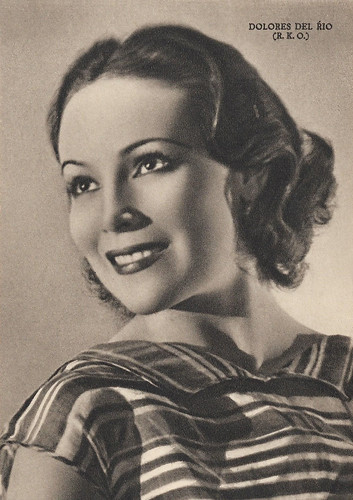
Italian postcard by Rizzoli & C. Milano, 1937. Photo: R.K.O.
Mexican and American actress Dolores del Río (1905–1983) was a Hollywood star in the 1920s and 1930s, and one of the most important female actresses of the Golden Age of Mexican cinema in the 1940s and 1950s. Del Río was the first major Latin cross-over star in Hollywood and was considered one of the most beautiful faces that have emerged in the Hollywood cinema. She also appeared in several European films. She acted in 1937 in The Devil's Playground (Erle C. Kenton, 1937).
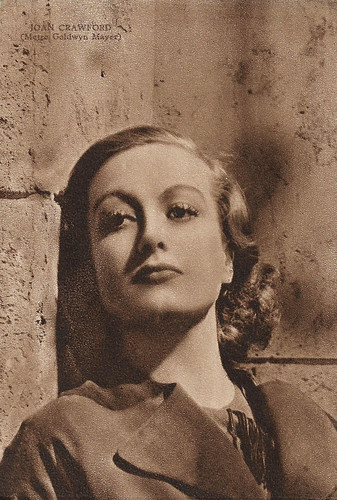
Italian postcard by Rizzoli, 1937. Photo: Metro-Goldwyn-Mayer.
American actress Joan Crawford (1905-1977) became nationally-known as a flapper by the end of the 1920s. In the 1930s, her fame rivaled, and later outlasted, MGM colleagues Norma Shearer and Greta Garbo . Crawford often played hardworking young women who find romance and success. In 1937, she appeared in The Last of Mrs. Cheyney (Richard Boleslawski, 1937), The Bride Wore Red (Dorothy Arzner, 1937), and Mannequin (Frank Borzage, 1937).
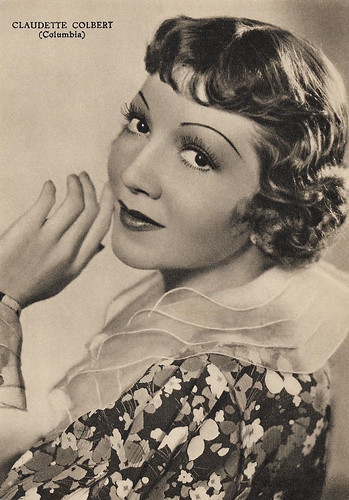
Italian postcard by. Rizzoli, Milano, 1937. Photo: Columbia.
With her round apple-face, big eyes, and charm, French-born Hollywood star Claudette Colbert (1903-1996) was the epitome of chic sophistication. Her comedies It Happened One Night (Frank Capra, 1934) - for which she won the Oscar, Midnight (Mitchell Leisen, 1939), and The Palm Beach Story (Preston Sturges, 1942) are among Hollywood's greatest ever. After more than 60 films, she returned with great success to the theatre and was 84 years old when she won a Golden Globe for the TV mini-series The Two Mrs. Grenvilles (1987). Colbert acted in 1937 in Tovarich (Anatole Litvak, 1937) with Charles Boyer and in two other films
A super production at a new studio complex
The year 1937 was that of the opening of the – still existing - film studio complex of Cinecittà, then outside of Rome, on the Via Tuscolana. The ‘newbies’ of the film school Centro Sperimentale di Cinematografia, founded in 1935 and offering a two-year training, could start working there right away.
A super production at the new complex was the epic film Scipione l’Africano, starring Annibale Ninchi as the stern Scipio, Camillo Pilotto as tough warrior Hannibal, Francesca Braggiotti as the seductive queen Sofonisba, and Fosco Giachetti as her lover and later husband Massinissa, who, yet, must bend to Roman dominance, sacrificing his wife.
The film had huge sets and battle scenes with numerous extras and elephants. Mussolini himself was involved in the production, as he hoped this film would enforce his dream of raising the Third Rome, after that of the Roman emperors and the popes.
Though exported, the film was less successful in foreign countries and it would be the last Antiquity film of the fascist era. Instead, other historical films such as Luis Trenker ’s Condottieri/Military leaders fared much better.
In 1937, the first co-productions with France started, such as Il fu Mattia Pascal/He Was Mattia Pascal by Pierre Chenal, starring Pierre Blanchar , Isa Miranda , and Enrico Glori .
Popular were the Italian comedies with older stage actors who had second careers in the cinema such as Armando Falconi , Angelo Musco, Antonio Gandusio , and Dina Galli , as well as comedies with younger comedians such as Vittorio De Sica and Assia Noris in Il signor Max/Mister Max (Mario Camerini, 1937), Luisa Ferida, Antonio Centa and Leda Gloria in I tre desideri/The Three Wishes (Kurt Gerron, 1937), and Totò in his first film, Fermo con le mani/Hands Off Me! (Gero Zambuto, 1937).
Established opera singers such as Beniamino Gigli and Tito Schipa also started second careers in film, while the new generation who was active in the dramatic genre included Amedeo Nazzari , Caterina Boratto and Maria Denis .
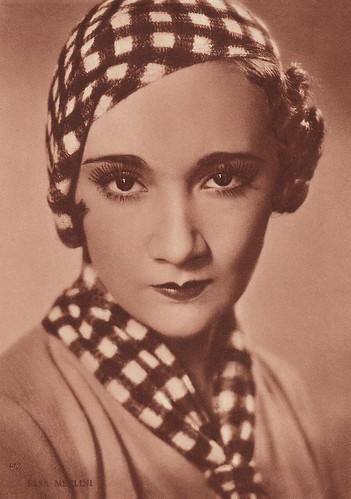
Italian postcard by Rizzoli & C., Milano, 1937.
Elsa Merlini (1903-1983) was a star of the Italian cinema of the 1930's. She excelled in the 'Telefoni Bianchi'(white telephone comedies). Merlini did not act in any film released in 1937, but in 1936 she starred in three films, Ginevra degli Almieri (Guido Brignone, 1936), Non ti conosco più/I Don't Know You Anymore (Nunzio Malasomma, Mario Bonnard, 1936), and 30 secondi d'amore/Thirty Seconds of Love (Mario Bonnard, 1936).

Italian postcard by Rizzoli & C., Milano, 1937.
Assia Noris (1912-1998) is best remembered as the star of several 1930s romantic comedies, directed by Mario Camerini and co-starring Vittorio De Sica . In 1937, she acted in five films (!): Il signor Max/Mister Max (Mario Camerini, 1937), Nina non far la stupida/Nina don't be stupid (Nunzio Malasomma, 1937), Ma non è una cosa seria/But It's Nothing Serious (Mario Camerini, 1937), Una commedia fra i pazzi/A Comedy Among Fools (N.N., 1937), and L'uomo che sorride/The Man Who Smiles (Mario Mattoli, 1937).
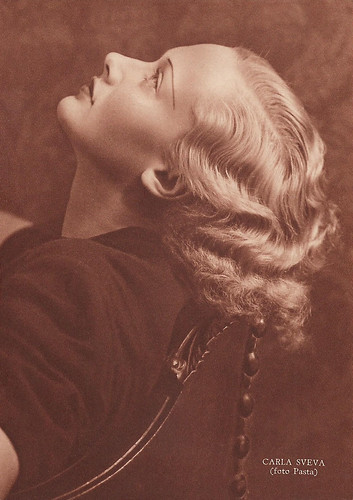
Italian postcard by Rizzoli & C., Milano, 1937. Photo: Pasta.
Carla Sveva (?-?) was an Italian film actress, whose short film career took place between 1936 and 1939. She was the love interest and later wife of Giovanni dalla Bande Nere ( Luis Trenker ) in the historical film Condottieri/Giovanni de Medici: The Leader (Luis Trenker, 1937).
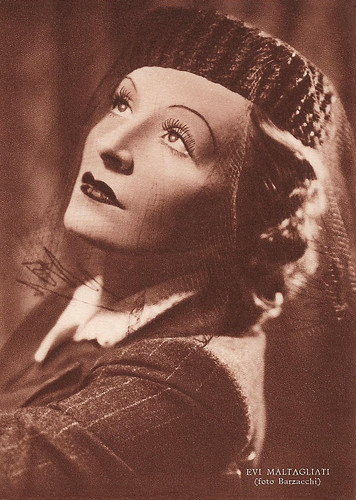
Italian postcard by Rizzoli & C. Milano, 1937. Photo: Barzacchi.
Evi Maltagliati (1908–1986) was an Italian stage and screen actress, who worked in Italian cinema between the later 1930s and the early 1970s. Maltagliati acted in no film in 1937, in 1936 she was in I due sergenti/The two sergeants (Enrico Guazzoni, 1937).
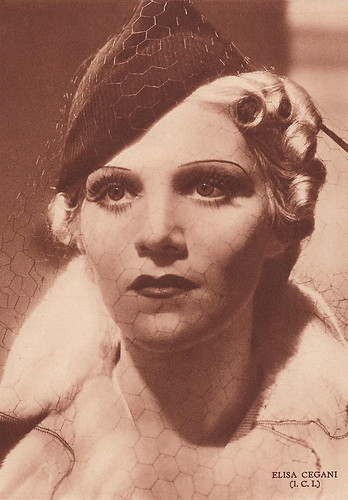
Italian postcard by Rizzoli & C., Milano, 1937. Photo: I.C.I.
Elisa Cegani (1911–1996) was one of the most representative actresses of Italian cinema of the 1930s and 1940s. In 1937, Cegani acted in La contessa di Parma/The Duchess of Parma (Alessandro Blasetti, 1937) and Ma non è una cosa seria/But It's Nothing Serious (Mario Camerini, 1937).
The first serious Italian film magazine
Luigi Chiarini, the director of the Centro Sperimentale, founded in 1937 the film journal Bianco e Nero, the organ of the Centro Sperimentale. Though many trade papers and fanzines had existed before, Bianco e Nero was the first serious Italian film magazine focusing on criticism, theory, and pedagogy.
At the 1937 Venice film festival, the award for Best Foreign Film was for Un carnet de bal/Dance Program by Julien Duvivier, starring Marie Bell . The award for Best Italian Film went to Scipione l'africano/Scipio the African by Carmine Gallone. The Volpi Cup for Best Actor went to Emil Jannings for Der Herrscher/The Ruler (Veit Harlan, 1937), and for Best Actress to Bette Davis for Kid Galahad (Michael Curtiz, 1937) and Marked Woman (Lloyd Bacon, 1937).
At the festival, La grande illusion by Jean Renoir was shown, and although it was liked by the international audience, the film was considered as 'too pacifistic' for a release in Italy. Yet, the screening in Venice would be a precursor to a large contingent of French films in Venice one year after, in 1938.
In Hollywood in March 1938, the Academy Awards for the films of 1937 were given to The Life of Emile Zola (Best Picture), Leo McCarey (Best Direction for The Awful Truth), Spencer Tracy (Best Actor for Captains Courageous), and Luise Rainer (Best Actress for The Good Earth).
The Life of Emile Zola by William Dieterle and starring Paul Muni won three awards that year. Apparently, biopics were popular among the Oscar jury, as in 1936 another biopic had won too, The Story of Louis Pasteur, also starring Paul Muni . Luise Rainer also had won the Oscar for 1936 too, for her role of Anna Held in The Great Ziegfeld Story. The 1937 film Lost Horizon, which was popular in Italy too, got Oscars for best art direction and editing.
Internationally, Italy’s reputation shrunk because of its colonial affairs. In 1937, Italy became worldwide known as ruthless against the Ethiopians, when after an assault on the Italian Viceroy Graziani, a massacre under the Ethiopian population took place, killing about 1/5 of the population of Addis Abeba and the whole population of one convent which supposedly had helped the assaulters.
When the League of Nations imposed economic sanctions on Italy’s invasion of Abyssinia, Italy left the League of Nations. Instead, Hitler received Mussolini in 1937 in Germany with a big display of power, and Mussolini was convinced the Germans would be his best ally...
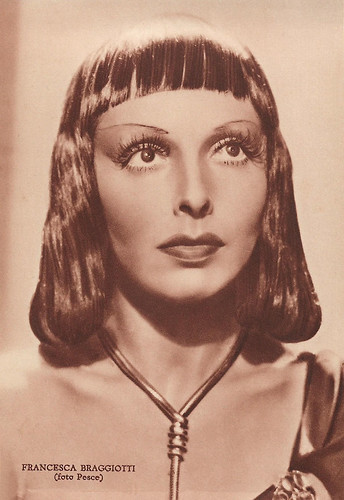
Italian postcard by Rizzoli & C., Milano, 1937. Photo: Pesce.
Francesca Braggiotti (1902-1998) was an Italian dancer and actress. She acted in Scipione l'Africano/Scipio the African (Carmine Gallone, 1937). Married to John Davis Lodge, she left her artistic career after her husband, also an actor, embarked on a political career that led him to become governor and then ambassador.

Italian postcard by Rizzoli, 1937. Photo: Ghergo.
Leda Gloria (1912-1997) was one of Federico Fellini’s favorite film actresses, having a prolific career in the 1930s and 1940s but is also remembered as the wife of Peppone in the Don Camillo films. Gloria also acted in I tre desideri/The Three Wishes (Giorgio Ferroni, Kurt Gerron, 1937).
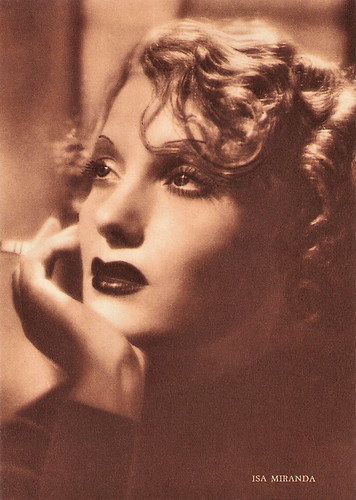
Italian postcard by Rizzoli, Milano, 1937.
Isa Miranda (1905–1982) was the only international film star produced by the Italian fascist cinema. In 1937, she acted in Scipione l'Africano/Scipio the African (Carmine Gallone, 1937) and Il fu Mattia Pascal/He Was Mattia Pascal (Pierre Chenal, 1937). In Hollywood, she was billed as the ‘Italian Marlene Dietrich’ and played femme fatale roles. Later she became one of the most significant European film actresses during the 1940s and early 1950s.
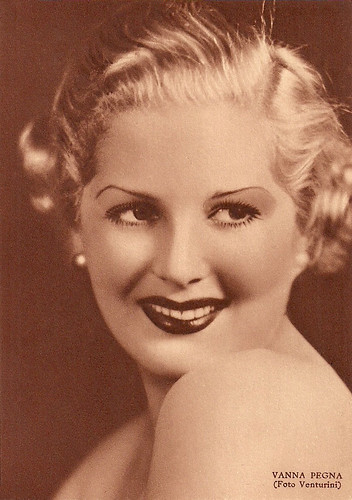
Italian postcard by Rizzoli & C., Milano, 1937. Photo: Venturini.
The elegant brunette Vanna Vanni (1920-1998), aka Vanna Pegna, was an Italian film actress who peaked in the late 1930s and early 1940s. She mostly played in comedies, many directed by Gennaro Righelli, plus several with the De Filippo family. In 1937, she acted in I fratelli Castiglioni/The Brothers Castiglione (Corrado D'Errico, 1937), Nina non far la stupida/Nina don't be stupid (Nunzio Malasomma, 1937), and L'uomo che sorride/The Man Who Smiles (Mario Mattoli, 1937).
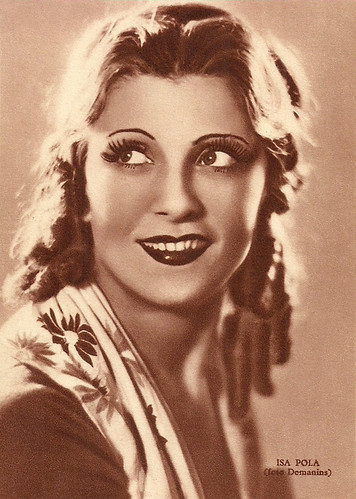
Italian postcard by Rizzoli & C., Milano, 1937. Photo: Demanins.
Isa Pola (1909-1984) was an Italian stage, film and television actress. In the 1930s and 1940s she was a big star in Italian cinema, in films such as La canzone dell'amore/The song of love (Gennaro Righelli, 1930), La telefonista/The switchboard Operator (Nunzio Malasomma, 1932) and I bambini ci guardano/The Children Are Watching Us (Vittorio De Sica, 1943). In 1937, Pola acted in Gli uomini non sono ingrati/Men are not ungrateful (Guido Brignone, 1937) and Sono stato io!/I Was to Blame (Raffaello Matarazzo, 1937).
Check out Part 1, 1936. To be continued!

Italian postcard by Rizzoli & C., Milano, 1937. Photo: Fox.
Simone Simon (1910-2005) was one of the most seductive and brilliant stars of the French cinema of the 1930s and 1950s. In 1936-1937 and during the war years she worked in Hollywood. Publicity dubbed her ‘La Sauvage Tendre’ (The Tender Savage). In 1937, she starred in Seventh Heaven (1937) by Henry King.

Italian postcard by Rizzoli & C. Milano, 1937. Photo: R.K.O.
Mexican and American actress Dolores del Río (1905–1983) was a Hollywood star in the 1920s and 1930s, and one of the most important female actresses of the Golden Age of Mexican cinema in the 1940s and 1950s. Del Río was the first major Latin cross-over star in Hollywood and was considered one of the most beautiful faces that have emerged in the Hollywood cinema. She also appeared in several European films. She acted in 1937 in The Devil's Playground (Erle C. Kenton, 1937).

Italian postcard by Rizzoli, 1937. Photo: Metro-Goldwyn-Mayer.
American actress Joan Crawford (1905-1977) became nationally-known as a flapper by the end of the 1920s. In the 1930s, her fame rivaled, and later outlasted, MGM colleagues Norma Shearer and Greta Garbo . Crawford often played hardworking young women who find romance and success. In 1937, she appeared in The Last of Mrs. Cheyney (Richard Boleslawski, 1937), The Bride Wore Red (Dorothy Arzner, 1937), and Mannequin (Frank Borzage, 1937).

Italian postcard by. Rizzoli, Milano, 1937. Photo: Columbia.
With her round apple-face, big eyes, and charm, French-born Hollywood star Claudette Colbert (1903-1996) was the epitome of chic sophistication. Her comedies It Happened One Night (Frank Capra, 1934) - for which she won the Oscar, Midnight (Mitchell Leisen, 1939), and The Palm Beach Story (Preston Sturges, 1942) are among Hollywood's greatest ever. After more than 60 films, she returned with great success to the theatre and was 84 years old when she won a Golden Globe for the TV mini-series The Two Mrs. Grenvilles (1987). Colbert acted in 1937 in Tovarich (Anatole Litvak, 1937) with Charles Boyer and in two other films
A super production at a new studio complex
The year 1937 was that of the opening of the – still existing - film studio complex of Cinecittà, then outside of Rome, on the Via Tuscolana. The ‘newbies’ of the film school Centro Sperimentale di Cinematografia, founded in 1935 and offering a two-year training, could start working there right away.
A super production at the new complex was the epic film Scipione l’Africano, starring Annibale Ninchi as the stern Scipio, Camillo Pilotto as tough warrior Hannibal, Francesca Braggiotti as the seductive queen Sofonisba, and Fosco Giachetti as her lover and later husband Massinissa, who, yet, must bend to Roman dominance, sacrificing his wife.
The film had huge sets and battle scenes with numerous extras and elephants. Mussolini himself was involved in the production, as he hoped this film would enforce his dream of raising the Third Rome, after that of the Roman emperors and the popes.
Though exported, the film was less successful in foreign countries and it would be the last Antiquity film of the fascist era. Instead, other historical films such as Luis Trenker ’s Condottieri/Military leaders fared much better.
In 1937, the first co-productions with France started, such as Il fu Mattia Pascal/He Was Mattia Pascal by Pierre Chenal, starring Pierre Blanchar , Isa Miranda , and Enrico Glori .
Popular were the Italian comedies with older stage actors who had second careers in the cinema such as Armando Falconi , Angelo Musco, Antonio Gandusio , and Dina Galli , as well as comedies with younger comedians such as Vittorio De Sica and Assia Noris in Il signor Max/Mister Max (Mario Camerini, 1937), Luisa Ferida, Antonio Centa and Leda Gloria in I tre desideri/The Three Wishes (Kurt Gerron, 1937), and Totò in his first film, Fermo con le mani/Hands Off Me! (Gero Zambuto, 1937).
Established opera singers such as Beniamino Gigli and Tito Schipa also started second careers in film, while the new generation who was active in the dramatic genre included Amedeo Nazzari , Caterina Boratto and Maria Denis .

Italian postcard by Rizzoli & C., Milano, 1937.
Elsa Merlini (1903-1983) was a star of the Italian cinema of the 1930's. She excelled in the 'Telefoni Bianchi'(white telephone comedies). Merlini did not act in any film released in 1937, but in 1936 she starred in three films, Ginevra degli Almieri (Guido Brignone, 1936), Non ti conosco più/I Don't Know You Anymore (Nunzio Malasomma, Mario Bonnard, 1936), and 30 secondi d'amore/Thirty Seconds of Love (Mario Bonnard, 1936).

Italian postcard by Rizzoli & C., Milano, 1937.
Assia Noris (1912-1998) is best remembered as the star of several 1930s romantic comedies, directed by Mario Camerini and co-starring Vittorio De Sica . In 1937, she acted in five films (!): Il signor Max/Mister Max (Mario Camerini, 1937), Nina non far la stupida/Nina don't be stupid (Nunzio Malasomma, 1937), Ma non è una cosa seria/But It's Nothing Serious (Mario Camerini, 1937), Una commedia fra i pazzi/A Comedy Among Fools (N.N., 1937), and L'uomo che sorride/The Man Who Smiles (Mario Mattoli, 1937).

Italian postcard by Rizzoli & C., Milano, 1937. Photo: Pasta.
Carla Sveva (?-?) was an Italian film actress, whose short film career took place between 1936 and 1939. She was the love interest and later wife of Giovanni dalla Bande Nere ( Luis Trenker ) in the historical film Condottieri/Giovanni de Medici: The Leader (Luis Trenker, 1937).

Italian postcard by Rizzoli & C. Milano, 1937. Photo: Barzacchi.
Evi Maltagliati (1908–1986) was an Italian stage and screen actress, who worked in Italian cinema between the later 1930s and the early 1970s. Maltagliati acted in no film in 1937, in 1936 she was in I due sergenti/The two sergeants (Enrico Guazzoni, 1937).

Italian postcard by Rizzoli & C., Milano, 1937. Photo: I.C.I.
Elisa Cegani (1911–1996) was one of the most representative actresses of Italian cinema of the 1930s and 1940s. In 1937, Cegani acted in La contessa di Parma/The Duchess of Parma (Alessandro Blasetti, 1937) and Ma non è una cosa seria/But It's Nothing Serious (Mario Camerini, 1937).
The first serious Italian film magazine
Luigi Chiarini, the director of the Centro Sperimentale, founded in 1937 the film journal Bianco e Nero, the organ of the Centro Sperimentale. Though many trade papers and fanzines had existed before, Bianco e Nero was the first serious Italian film magazine focusing on criticism, theory, and pedagogy.
At the 1937 Venice film festival, the award for Best Foreign Film was for Un carnet de bal/Dance Program by Julien Duvivier, starring Marie Bell . The award for Best Italian Film went to Scipione l'africano/Scipio the African by Carmine Gallone. The Volpi Cup for Best Actor went to Emil Jannings for Der Herrscher/The Ruler (Veit Harlan, 1937), and for Best Actress to Bette Davis for Kid Galahad (Michael Curtiz, 1937) and Marked Woman (Lloyd Bacon, 1937).
At the festival, La grande illusion by Jean Renoir was shown, and although it was liked by the international audience, the film was considered as 'too pacifistic' for a release in Italy. Yet, the screening in Venice would be a precursor to a large contingent of French films in Venice one year after, in 1938.
In Hollywood in March 1938, the Academy Awards for the films of 1937 were given to The Life of Emile Zola (Best Picture), Leo McCarey (Best Direction for The Awful Truth), Spencer Tracy (Best Actor for Captains Courageous), and Luise Rainer (Best Actress for The Good Earth).
The Life of Emile Zola by William Dieterle and starring Paul Muni won three awards that year. Apparently, biopics were popular among the Oscar jury, as in 1936 another biopic had won too, The Story of Louis Pasteur, also starring Paul Muni . Luise Rainer also had won the Oscar for 1936 too, for her role of Anna Held in The Great Ziegfeld Story. The 1937 film Lost Horizon, which was popular in Italy too, got Oscars for best art direction and editing.
Internationally, Italy’s reputation shrunk because of its colonial affairs. In 1937, Italy became worldwide known as ruthless against the Ethiopians, when after an assault on the Italian Viceroy Graziani, a massacre under the Ethiopian population took place, killing about 1/5 of the population of Addis Abeba and the whole population of one convent which supposedly had helped the assaulters.
When the League of Nations imposed economic sanctions on Italy’s invasion of Abyssinia, Italy left the League of Nations. Instead, Hitler received Mussolini in 1937 in Germany with a big display of power, and Mussolini was convinced the Germans would be his best ally...

Italian postcard by Rizzoli & C., Milano, 1937. Photo: Pesce.
Francesca Braggiotti (1902-1998) was an Italian dancer and actress. She acted in Scipione l'Africano/Scipio the African (Carmine Gallone, 1937). Married to John Davis Lodge, she left her artistic career after her husband, also an actor, embarked on a political career that led him to become governor and then ambassador.

Italian postcard by Rizzoli, 1937. Photo: Ghergo.
Leda Gloria (1912-1997) was one of Federico Fellini’s favorite film actresses, having a prolific career in the 1930s and 1940s but is also remembered as the wife of Peppone in the Don Camillo films. Gloria also acted in I tre desideri/The Three Wishes (Giorgio Ferroni, Kurt Gerron, 1937).

Italian postcard by Rizzoli, Milano, 1937.
Isa Miranda (1905–1982) was the only international film star produced by the Italian fascist cinema. In 1937, she acted in Scipione l'Africano/Scipio the African (Carmine Gallone, 1937) and Il fu Mattia Pascal/He Was Mattia Pascal (Pierre Chenal, 1937). In Hollywood, she was billed as the ‘Italian Marlene Dietrich’ and played femme fatale roles. Later she became one of the most significant European film actresses during the 1940s and early 1950s.

Italian postcard by Rizzoli & C., Milano, 1937. Photo: Venturini.
The elegant brunette Vanna Vanni (1920-1998), aka Vanna Pegna, was an Italian film actress who peaked in the late 1930s and early 1940s. She mostly played in comedies, many directed by Gennaro Righelli, plus several with the De Filippo family. In 1937, she acted in I fratelli Castiglioni/The Brothers Castiglione (Corrado D'Errico, 1937), Nina non far la stupida/Nina don't be stupid (Nunzio Malasomma, 1937), and L'uomo che sorride/The Man Who Smiles (Mario Mattoli, 1937).

Italian postcard by Rizzoli & C., Milano, 1937. Photo: Demanins.
Isa Pola (1909-1984) was an Italian stage, film and television actress. In the 1930s and 1940s she was a big star in Italian cinema, in films such as La canzone dell'amore/The song of love (Gennaro Righelli, 1930), La telefonista/The switchboard Operator (Nunzio Malasomma, 1932) and I bambini ci guardano/The Children Are Watching Us (Vittorio De Sica, 1943). In 1937, Pola acted in Gli uomini non sono ingrati/Men are not ungrateful (Guido Brignone, 1937) and Sono stato io!/I Was to Blame (Raffaello Matarazzo, 1937).
Check out Part 1, 1936. To be continued!
Published on August 28, 2020 22:00
Paul van Yperen's Blog
- Paul van Yperen's profile
- 13 followers
Paul van Yperen isn't a Goodreads Author
(yet),
but they
do have a blog,
so here are some recent posts imported from
their feed.



